Implementation Report (IGJ)
PURPOSE
This document describes the specifications of the Implementation Report (IGJ) under the CPR Regulation and more specifically those related under the Investment for Growth and Jobs Goal (IGJ). The Implementation Report has to be sent until the 30th April 2015 for YEI and from 2016 onwards for all the other Funds under IGJ each year by 31st of May until 2023.
The last Implementation Report is the 2022 one and will be submitted in 2023. For the reports submitted in 2017 and 2019, deadline shall be 30th of June.
The Final implementation report can be submitted at any time before 15/02/2026. The Commission has 5 months to provide observations in line with article 50(7) CPR.
REGULATION
More details about the regulation regarding the Implementation Report (IGJ) can be found in 'About SFC2014' section of this portal.
ROLES
Roles involved in the Implementation Report (IGJ) are:
MS Managing Authority | Record the Implementation Report (IGJ) Upload the Implementation Report (IGJ) Consult the Implementation Report (IGJ) Delete the Implementation Report (IGJ) Validate the Implementation Report (IGJ) Send the Implementation Report (IGJ) Return the Implementation Report (IGJ) Cancel the Implementation Report (IGJ) Create New Version of an Implementation Report (IGJ) |
MS Audit Authority | Consult the Implementation Report (IGJ) |
FUNDS
YEI | CF | ESF | ERDF |
PRE-CONDITIONS
The IGJ Operational Programme is Adopted by the Commission and managed on your Node.
Workflow
This section shows the lifecycle to create and manage an Implementation Report (IGJ).
Click here to see the AIR IGJ workflow diagram in high resolution.
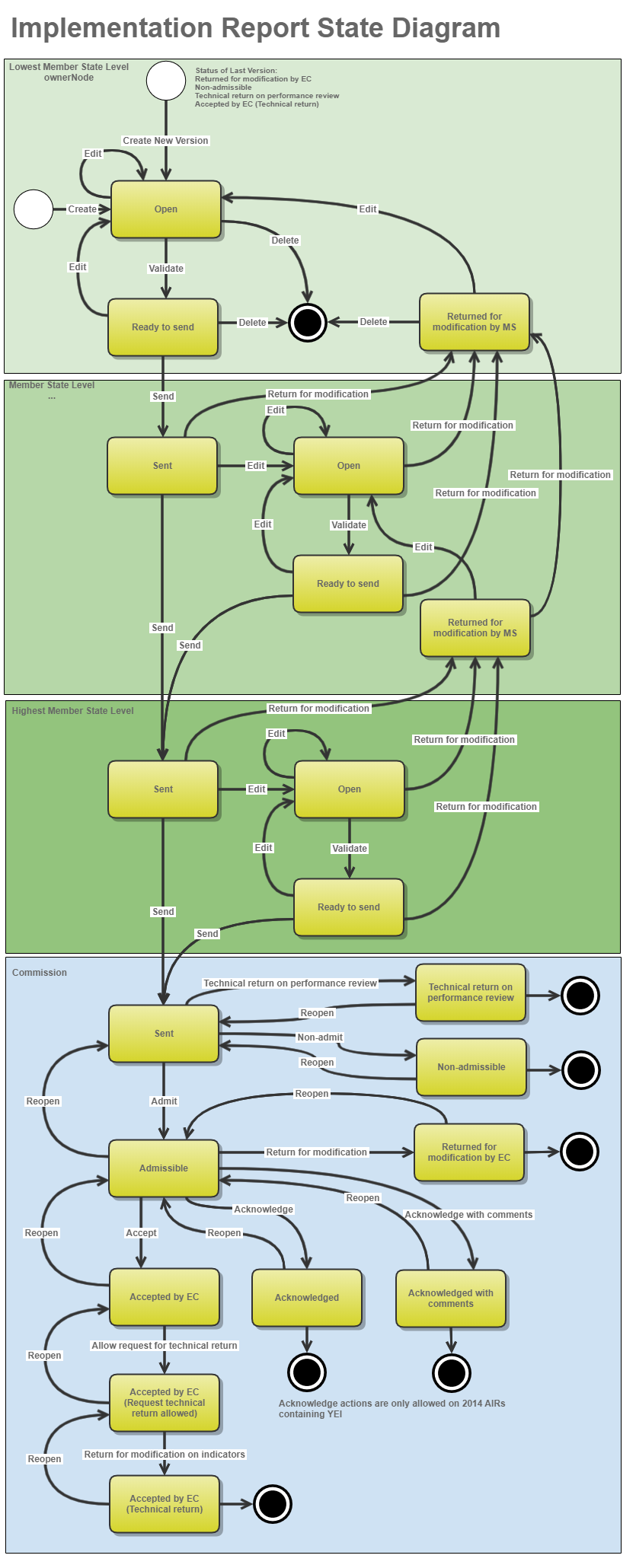
Create the Implementation Report (IGJ)
REMARK | To create the Implementation Report (IGJ) you must have MS Managing Authority with Update access. An IGJ Operational Programme must have been Adopted by the Commission in order for you to create an Implementation Report (IGJ). |
To access into the Implementation Report (IGJ) section, first click on the Monitoring link (1) in the menu and then on the Implementation Report (IGJ) link (2).
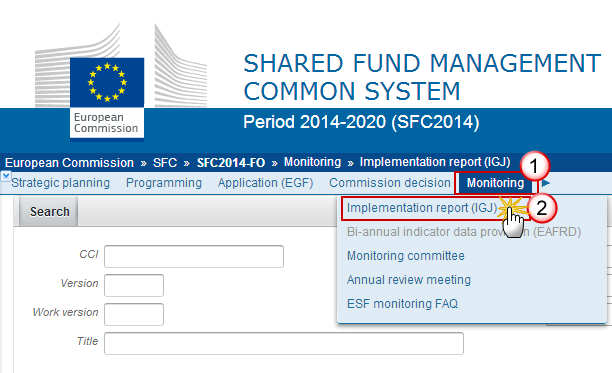
Click on the Create new Implementation Report link to create a new Implementation Report (IGJ).
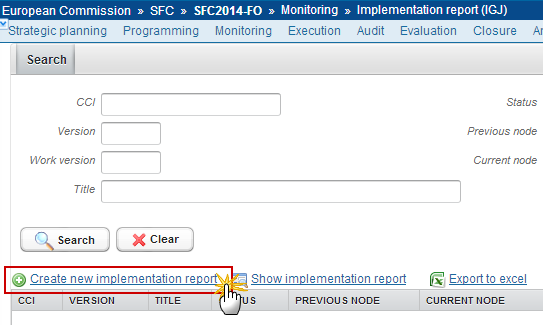
You are redirected to the Implementation Report (IGJ) creation page:
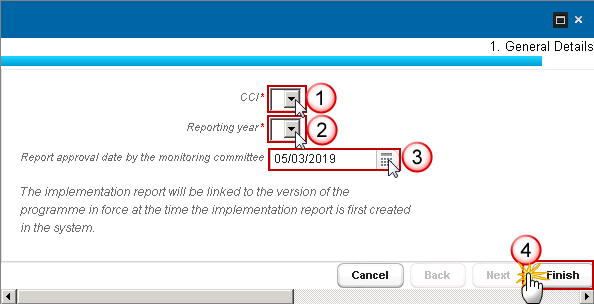
Enter or Select the following information:
(1) Select a CCI.
The CCI list contains all adopted IGJ Programmes which contain Funds for which the User is registered. The list returns the CCI and the Programme Title.
(2) Select a Reporting Year.
The Reporting Year list contains all years smaller than the current year, starting from 2014 for YEI and starting from 2015 for the others, for which no Annual Implementation Report exists. The last Annual Report will be for year 2022 and will be submitted in 2023, unless a Final Implementation Report exists. From 1/10/2022 onwards, the list will also contain 9999 used for the Final Implementation Report.
The achievement values for previous Reporting Years are copied from the Implementation Report of the previous Reporting Year.
(3) The Report Approval Date by the Monitoring Committee is mandatory on the first version of a Reporting Year.
(4) Click on the Finish button to confirm the creation.
The status of the Implementation Report is Open.
REMARK | The Implementation Report is linked to the last adopted version of the Operational Programme, except when a request already exists from the EC to link the IR to another Programme version. The records of the following Tables will automatically be created from the equivalent tables in the linked Operational Programme Version: Section 3.1, Indicator Tables (1, 2A, 2B, 2C, 3A, 3B, 4A and 4B), Performance Framework Table (5), Expenditure incurred outside the Union for ESF (10), Allocation of YEI outside NUTS2 (11), Major Projects (12) and Ex-ante conditionalities (Only pre-AIR2017) (14 and 15). The annual achievement values for previous Reporting Years are copied from the Implementation Report of the previous Reporting Year. Also the "Measurement unit of the indicator", the "Programme Specific Output Indicator used as basis for target setting", the "Measurement unit for baseline and target" and the “Decreasing target” in Table 2C are copied from the Implementation Report of the previous Reporting Year. Also the Financial Instruments data are copied from the Implementation Report of the previous Reporting Year. The Final Implementation Report will contain 3 extra annexes (I, II, III) as described in the Closure Guidelines. |
Record/Edit the Implementation Report (IGJ)
Find all the information to complete each screen of the Implementation Report (IGJ), below there are the links to the main sections:
Note | In AIRs 2017, 2019, 2020, 2021 and 2022 the following sections and their sub-sections are not be editable, and therefore not displayed (both in web, web service and will be empty in print): 11, 12, 14.1, 14.2, 14.3, 14.5, 14.6, 15, 16, 17, 18 |
General
Version Information
The Version Information contains information on the identification and status of the Implementation Report Version like the CCI, the Title, the Version Number = Reporting Year, the Work Version Number, the Status, the Node where it currently resides and the linked adopted Programme Version. It also shows the results of the last validation done on this Implementation Report version.
In the Last validation results list, Warning Messages that already existed in the previous minor version will be shown in grey and ordered at the end of the list.
Only the Report Approval Date by the Monitoring Committee can be updated.
Click on the Edit button
 to modify the Report Approval Date by the Monitoring Committee.
to modify the Report Approval Date by the Monitoring Committee.
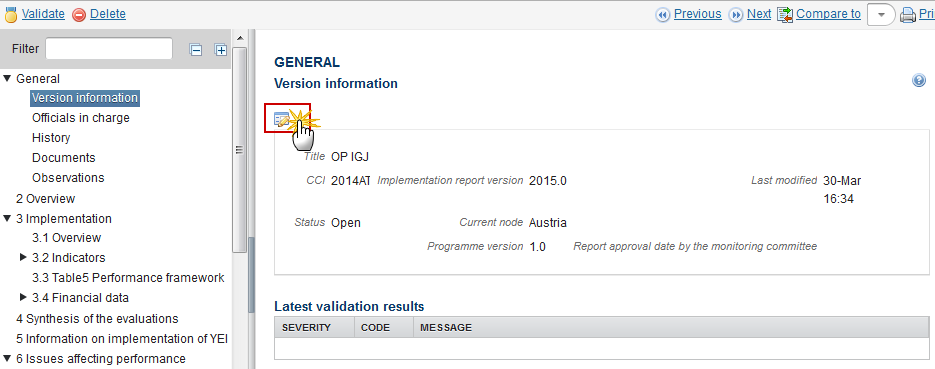
The edit details form pop-up window appears:
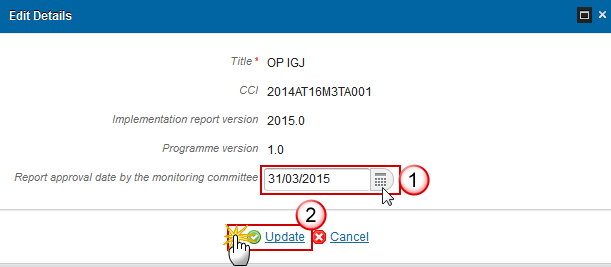
Enter or select the following information:
(1) Enter the new Report Approval Date by the Monitoring Committee.
(2) Click on the Update link to save the information.
Officials in Charge
Note | Officials in Charge can be updated at any time, independent from the status of the Implementation Report. |

Click on the Add button
 to add a new Official in Charge.
to add a new Official in Charge.Select an official and click in the Edit button
 to modify the information of this Official.
to modify the information of this Official.Select an official and click on the Remove button
 to delete the Official in Charge selected.
to delete the Official in Charge selected.
Click on the Add button
 to add a new Official in Charge
to add a new Official in Charge

The Edit Details pop-up window appears:
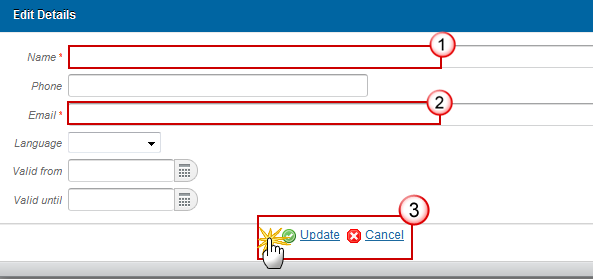
Enter the following information:
(1) Enter the Name.
(2) Enter the Email.
(3) Click on Update to save the information.
Note | Commission Officials (email domain "ec.europa.eu") can only be created/updated/deleted by Commission Users. |
History
This section shows all the actions that happened in the Implementation Report since it was created, for example:

Documents
The Documents list shows all documents uploaded against this version of the Implementation Report by the Member State and by the Commission.
The following documents will be foreseen:
Description | Non-Integral | Integral | System | Required |
|---|---|---|---|---|
Snapshot of data before send |
| X | X | X |
Acknowledgment of Receipt |
|
| X | X |
Citizens' Summary |
| X |
|
|
MS Reply to Article 50(8) observations * | X |
|
|
|
MS reply to observations in EC acceptance letter (other than Article 50(8))* | X |
|
|
|
MS request for technical return** | X |
|
|
|
*Only allow on IR versions in status 'Accepted by EC'
**Only allow on IR versions in status 'Accepted by EC (Request technical return allowed) '
REMARK | ! The 'Other Member state document' type can no longer be uploaded in the Implementation Report. |
REMARK | Integral documents can only be added, updated or deleted when the main object is editable. Integral documents are automatically sent - together with the encoded data – when the AIR is submitted to the EC. Referential/non-integral Documents (ie. 'MS Reply to Observations in EC Acceptance Letter (other than Article 50(8))') can be sent at any time independently when the status of the IR is 'Accepted by EC'. The non-integral type demands a manual submission (they are NOT sent automatically within the Programme). A document is only visible to the Commission when the sent date is visible. |
Uploading & Sending Documents
To upload a document:

Clicking on the Add button
 will open a pop up window allowing you to add a new document type with attachments.
will open a pop up window allowing you to add a new document type with attachments.Selecting a document row and click in the Edit button
 will allow you to modify the document information.
will allow you to modify the document information. Selecting a row of a previously uploaded document and click on the Remove button
 to delete the document and associated attachments.
to delete the document and associated attachments.
Click on the Add button
 to add a new document.
to add a new document.

The document detail pop-up window appears:
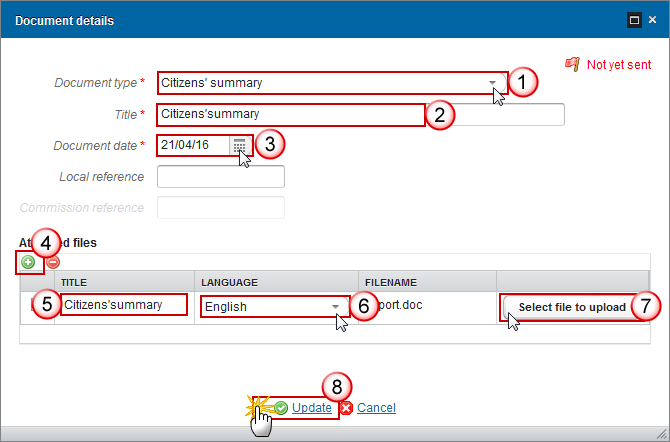
Enter or select the following information:
(1) Select a Document Type
(2) Enter a title for your Document
(3) Enter a Document Date
(4) Click on the Add button ![]() to add a new attachment
to add a new attachment
You can add multiple attachments by clicking on the Add button

You can remove unwanted attachments by selecting the attachment and clicking on the Remove button

(5) Enter a Title for your attachment.
(6) Select the Language of the document.
(7) Select the file to upload.
(8) Click on Update to save the information.
The pop-up window closes and the documents are uploaded.
REMARK | Commission Registration N° is only enabled for Commission Users, while Local Reference is only enabled for Member State Users. |
Deletion of an unsent document
Select a row (1) of a previously uploaded document and click on the Remove button
 (2) to delete the document and associated attachments.
(2) to delete the document and associated attachments.

A confirmation window appears:

Click on Yes to confirm deletion. Click on No to return to the Implementation Report documents.
Observations
This section is to provide any relevant information to the Implementation Report.
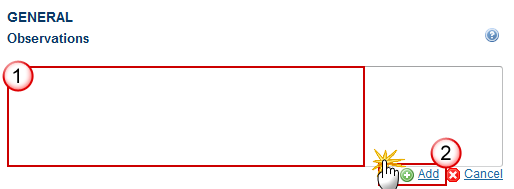
Enter the following information:
(1) Enter an observation.
All users who have Read and Observation permission on the Implementation Report will be able to send an Observation and participate in the conversation.
(2) Click on the Add to save the information.
All Observations are kept against the specific version of the Implementation Report.
2. Overview
Key information on the Implementation of the Operational Programme for the year concerned, including on financial instruments.
Click on the Edit button
 to open a pop up window to add an overview of the Implementation of the Operational Programme.
to open a pop up window to add an overview of the Implementation of the Operational Programme.

The Edit Details pop-up window appears:

Enter the following information:
(1) Enter a description text.
(2) Click on the Update link to save the information.
3. Implementation
Implementation of the Priority Axis.
3.1 Overview
Click on the Edit button
 to open a pop up window to add new information about the Overview of the Implementation.
to open a pop up window to add new information about the Overview of the Implementation.

The Edit Details form pop-up window appears:
Note | The records will be automatically created from the Priority Axes of the linked Programme at creation time. The Key Information field is mandatory. |
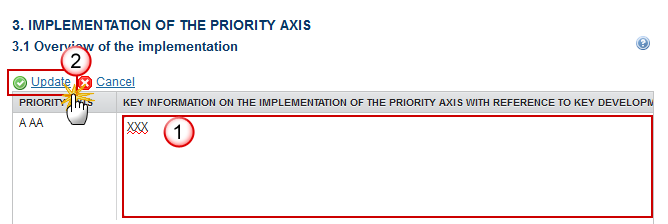
Select the following information:
(1) Enter the information on the Key Information on the Implementation of the Priority Axis with reference to key developments, significant problems and steps taken to address these problems.
The records will be automatically created from the Priority Axes of the linked Programme at creation time.
(2) Click on the Update to save the information.
3.2 Indicators
Non-TA Priority Axes
Priority Axes other than Technical Assistance.
Priority Axis: A
Investment Priority 1
Table 2A – Common Result Indicators for ESF and ESF REACT-EU for Non-TA Priority Axes
Click on the Edit button
 to open a pop up window to enter or modify the common result indicators values for ESF for Non-TA Priority Axes.
to open a pop up window to enter or modify the common result indicators values for ESF for Non-TA Priority Axes.

The Common Result Indicators form pop-up window appears:
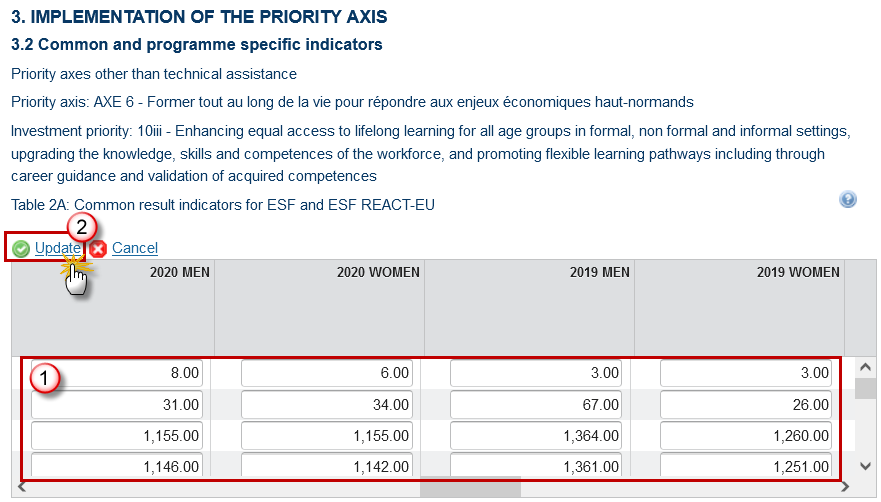
Enter or select the following information:
(1) Enter the Common result indicator for 20XX Men and 20XX Women
(2) Click on Update to save the information.
Note | For each Priority Axis/Investment Priority/Category of Region, all Common ESF Result Indicators need to be foreseen. Then, for the ones used in the linked Programme version (Table 4), the "Common Output Indicator used as basis for target setting", the "Measurement Unit for baseline and target" and the "Target Value" is copied from the Programme. Then, in addition to the records with "Common Output Indicator used as basis for target setting" (needed for reporting on target group), an additional record without this "Common Output Indicator" reference is created (needed for reporting on entire population). Since in the Programme Table 12 it is not possible to use a Common ESF Result Indicator and to set a target for Technical Assistance Priority Axes, Table 2A doesn't have to be foreseen under Technical Assistance Priority Axes. The measurement unit of Common Result Indicators is always Number. If the "Measurement for target setting" is "Ratio" and the Target is therefore expressed in a percentage, then the AR can only be calculated when taking into account the absolute achievements of the Output Indicator used for target setting (=
The achievement ratio should always be shown as a nominal value (0.75) instead of a percentage (75%). |
Table 2B – Result Indicators for the YEI and YEI REACT-EU for Non-TA Priority Axes
Click on the Edit button
 to open a pop up window to enter or modify the Result Indicators for the YEI for Non-TA Priority Axes.
to open a pop up window to enter or modify the Result Indicators for the YEI for Non-TA Priority Axes.
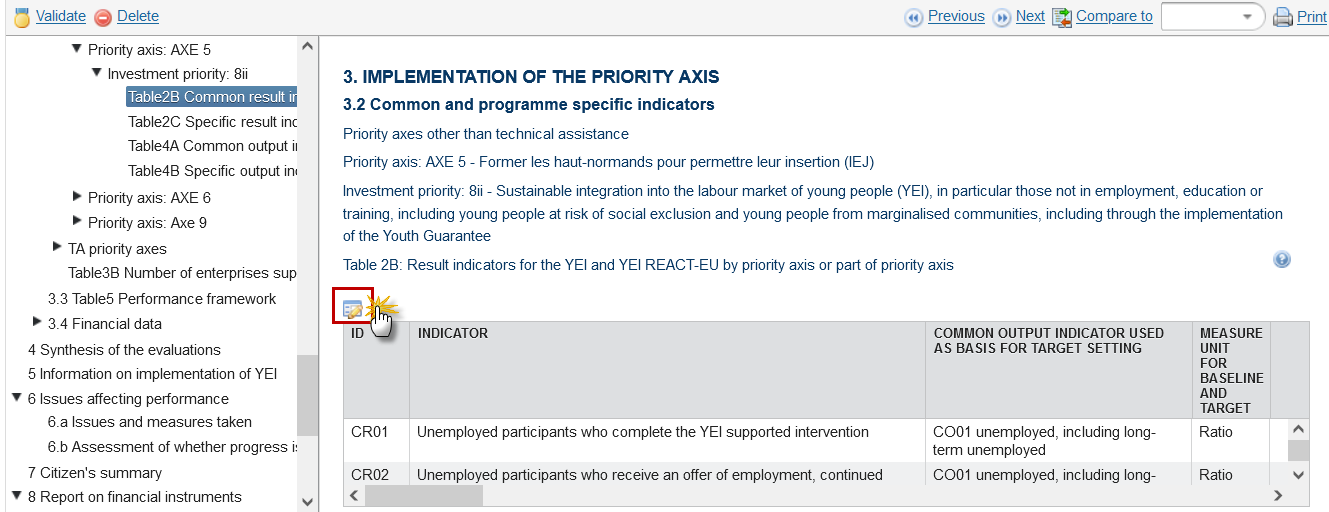
The Result Indicators for the YEI pop-up window becomes editable:

Enter the following information:
(1) Enter the Common result indicator for 20XX Men and 20XX Women
(2) Click on Update to save the information.
Note | For each Priority Axis/Investment Priority, all Common YEI and ESF Result Indicators need to be foreseen. Then, for the ones used in the linked Programme version (Table 4a), the "Common Output Indicator used as basis for target setting", the "Measurement Unit for baseline and target" and the "Target Value" is copied from the Programme. Table 2B is not to be foreseen under Technical Assistance Priority Axes. The achievement ratio should always be shown as a nominal value (0.75) instead of a percentage (75%). |
Table 2C – Programme Specific Result Indicators for ESF and ESF REACT-EU and YEI and YEI REACT-EU for Non-TA Priority Axes
Click on the Edit button
 to open a pop up window to add the Programme Indicators.
to open a pop up window to add the Programme Indicators.
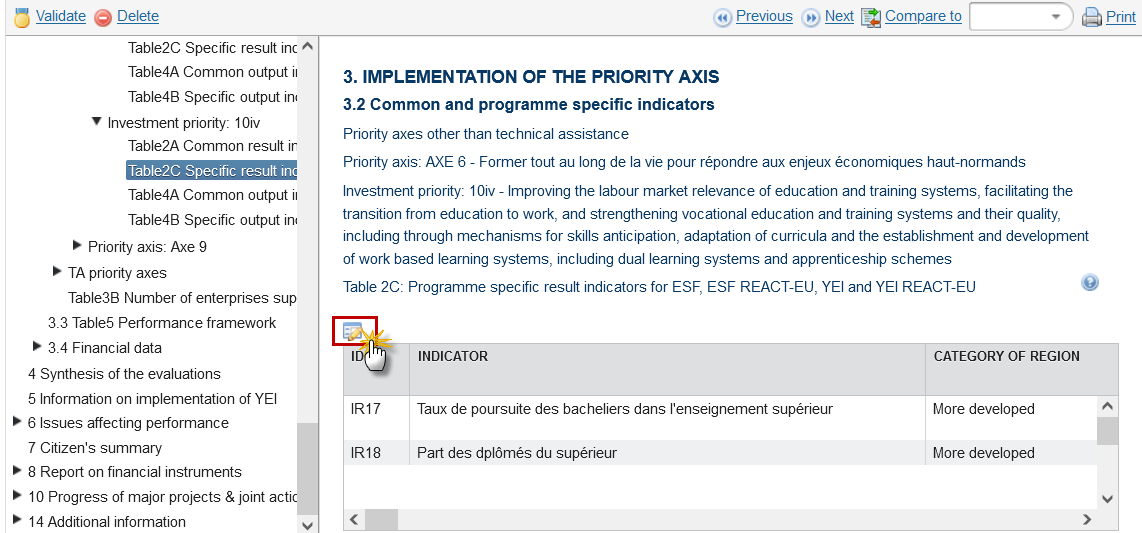
The Programme Specific Result Indicators for ESF and YEI pop-up window appears:


Enter the following information:
(1) Enter the Measurement Unit for Indicator (number or rate)
(2) Select the Output Indicator used as basis for target setting
(3) Select the Measurement for baseline and target
(4) Select if that indicator has a decreasing target
(5) - (6) Enter the Annual and Cumulative values for men women and total for the years displayed.
(7) Click on the Update link to save the information.
Note | The records will be automatically created from the Table 4 (for non-TA Priority Axes) and Table 12 (for TA Priority Axes) of the linked Programme at creation time. From Table 4 only the Programme Specific indicators are taken. From Table 12 only the Programme Specific indicators linked to ESF/YEI Priority Axes are taken. In case of a quantitative indicator, since the Measurement Unit of the Programme Specific Result Indicators in the Programme is free text, it cannot be used to determine if the measurement unit is in absolute values or in percentages. Therefore, it is only foresee "Number" and "Ratio" as possible values of the list. In case of a quantitative indicator, since in the Programme it is not possible to link a Programme Specific Result Indicator to a Programme Specific or Common Output Indicator, it needed to provide this possibility in this Table 2C. The list "Output Indicator used as basis for target setting" contains all ESF/YEI Programme Specific and Common Output Indicators defined against the same Priority Axis/Investment Priority (for non-TA) or Priority Axis/Specific Objective (for TA). In case of a quantitative indicator, since in the Programme, the "Measurement unit for baseline and target" is not always set, it needed again here. Values are "Number" and "Ratio". Since an Indicator could have a decreasing Target, in which case the calculation of the Achievement Ratio needs to be inverted (= 1/Achievement Ratio), and since this has not been foreseen on the definition of the Indicator in the Programme, this table foresees a checkbox "Decreasing target" so it can still be set. The different achievement value fields will be enabled / disabled depending on:
The calculation of the Cumulative values and the Achievement Ratios depend on the measurement unit of the Result Indicator and of the measurement unit of the Target. The Measurement Unit of the RI and of the Target both show the value selected in this Implementation Report and between brackets the value as it exists in the Programme. For the value from the Programme we will only show the first 30 characters. An additional attribute has been added to indicate that the indicator has a decreasing target. In this case, the achievement ratio will be 1/Achievement Ratio. In the Print, the “Decreasing target” will not be shown. The achievement ratio should always be shown as a nominal value (0.75) instead of a percentage (75%). |
Table 3A – Common and Programme Specific Output Indicators for the ERDF, the ERDF REACT-EU and the Cohesion Fund for Non-TA Priority Axes
Click on the Edit button
 to open a pop-up window to add the Common and Programme Specific Indicators for ERDF/CF.
to open a pop-up window to add the Common and Programme Specific Indicators for ERDF/CF.
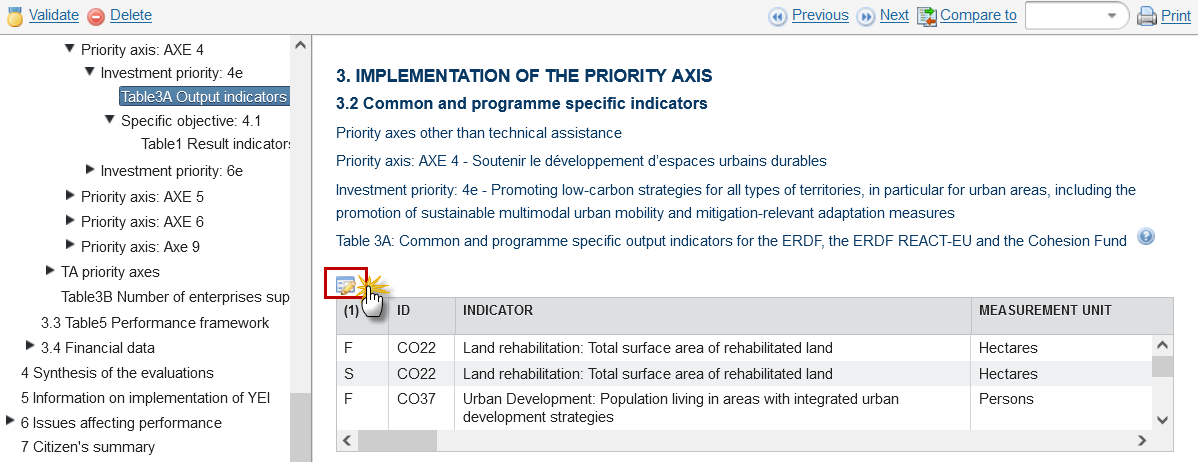
The Common and Programme Indicator's table becomes editable:

Enter the following information:
(1) Enter the 20XX Total
(2) Enter the 20XX Men
(3) Enter the 20XX Women
(4) Enter the Observations
(5) Click on the Update link to save the information.
Note | The records will be automatically created from the Table 5 (for non-TA priority Axes) of the linked Programme at creation time. From Table 5 only the records linked to ERDF/CF Investment Priorities are taken. For each record in the Programme, 2 records will be created in Table 3A, one for ‘Outputs to be delivered by selected operations’ and one for ‘Outputs delivered by operations’ (pre-2017)/ Operations (2017 onwards). |
Table 4A – Common Output Indicators for the ESF and ESF REACT-EU and YEI and YEI REACT-EU for Non-TA Priority Axes
Click on the Edit button
 to open a pop up window to add the information about the Common Output Indicators for the ESF and YEI.
to open a pop up window to add the information about the Common Output Indicators for the ESF and YEI.
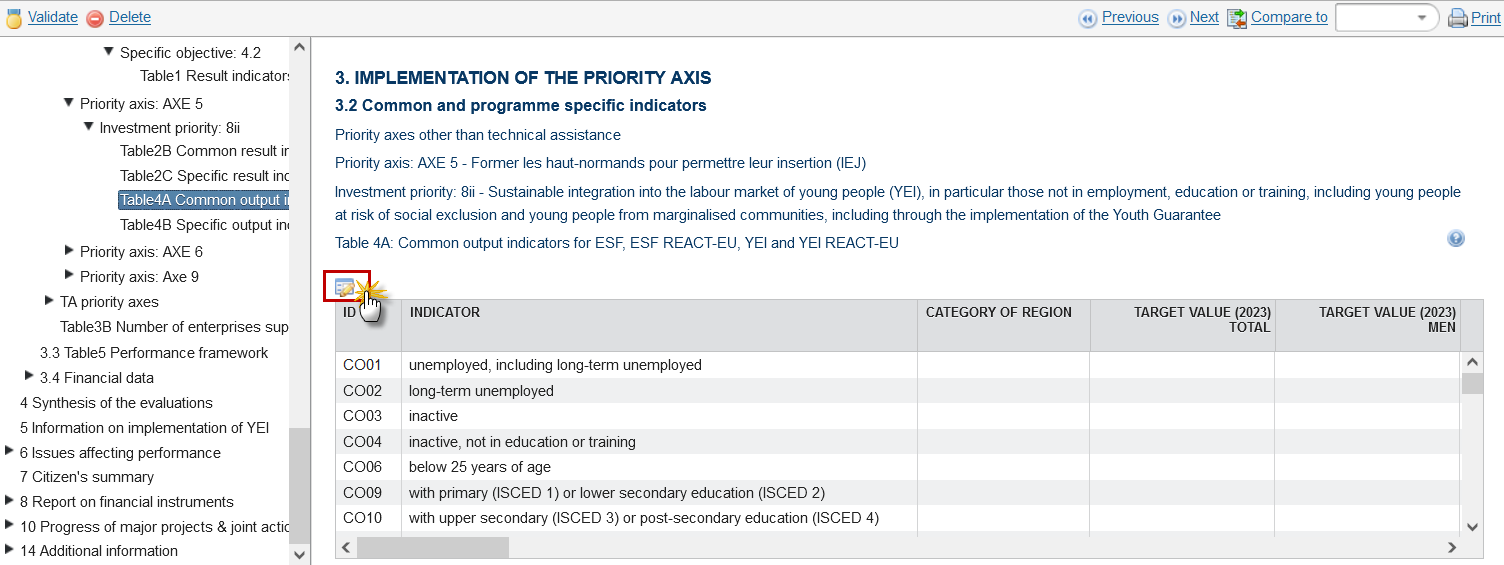
The Edit Details pop-up window appears:
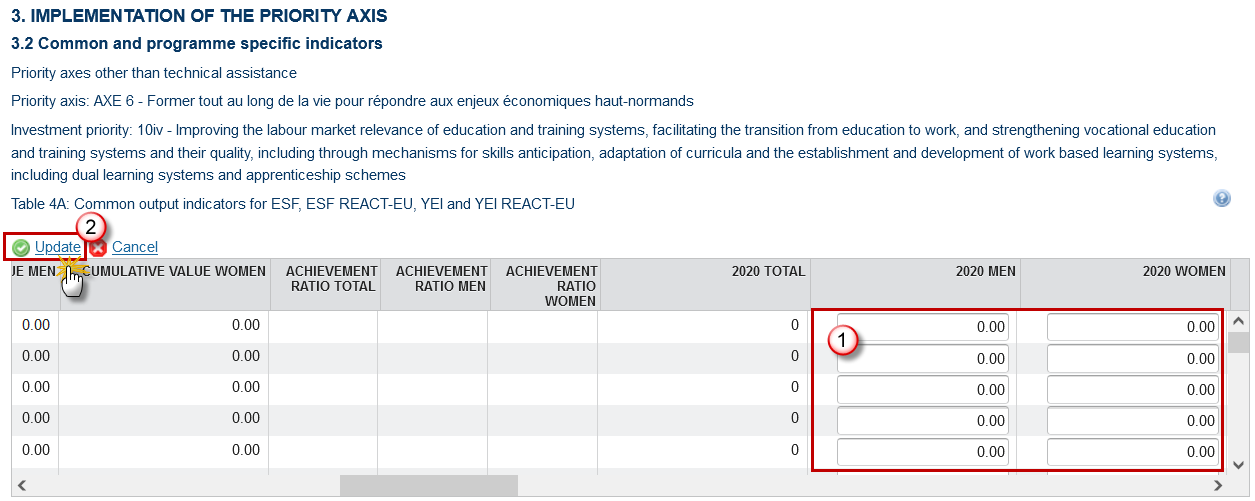
Enter the following information:
(1) Enter the values for 20XX Men and for 20XX Women
(2) Click on the Update link to save the information.
Note | For each non-TA, non-CARE, non-REACT-EU CARE, non-SAFE, non-REACT-EU SAFE Priority Axis/ESF Investment Priority/[Category of Region], all Common ESF Output Indicators need to be foreseen,
The Target Value(s) are copied from the equivalent records in Tables 5 (same PA/IP/Category of Region/Indicator). For each ESF TA Priority Axis, only Common ESF Output Indicators with a target in Table 13 (same PA/Category of Region/Indicator) of the linked programme are to be foreseen. For each non-TA, CARE or REACT-EU CARE or SAFE or REACT-EU SAFE Priority Axis/ESF Investment Priority/[Category of Region], the Common ESF Output Indicators CCO01 and CCO02 need always to be foreseen, plus all other Common ESF Output Indicators used in OP Table 5. The Target Value(s) are copied from the equivalent records in Tables 5 (same PA/IP/[Category of Region]/Indicator). As ESF/YEI Common Output indicators CO12-CO14 have become obsolete since the Omnibus regulation, the system now only creates them in Table 4A when they were used in the OP Tables 4/4a, 5 and/or 6. Since there are no YEI Common Output Indicators, the system will automatically foresee for each non-TA Priority Axis/YEI Investment Priority, all Common ESF Output Indicators which are marked to be used by YEI. The Target Value(s) are copied from the equivalent records in Tables 5 (same PA/IP/Indicator) of the linked programme. There are no YEI TA Priority Axes in the Programme. An additional record "Grand total of participants" is automatically foreseen under each Priority Axis/Investment Priority for non-TA Priority Axes. It is not needed under TA Priority Axes. Common Output Indicators CO01 to CO19 have gender breakdown: Input in Men and Women columns. Common Output Indicators CO20 to CO23, and CCO01 and CCO02 have no gender breakdown: Input in Total values and without decimals, total columns are now foreseen. Grand total of participants has no gender breakdown: Input in Total column and without decimals. The achievement ratio should always be shown as a nominal value (0.75) instead of a percentage (75%). |
Table 4B – Programme Specific Output Indicators for the ESF and ESF REACT-EU and YEI and YEI REACT-EU
Clicking on the Edit button
 to open a pop up window allowing you to add the information about the Programme Specific Output Indicators for the ESF and YEI.
to open a pop up window allowing you to add the information about the Programme Specific Output Indicators for the ESF and YEI.

The Edit Details pop-up window appears:

Enter the following information:
(1) Enter the values for 20XX Men and for 20XX Women
(2) Click on the Update link to save the information.
Note | The records will be automatically created from Table 5 of the linked Programme at creation time. From Table 5 only the Programme Specific Output Indicators linked to ESF/YEI Investment Priorities are taken. The achievement ratio should always be shown as a nominal value (0.75) instead of a percentage (75%). |
Table 1 – Result Indicators ERDF, the ERDF REACT-EU and the Cohesion Fund
Clicking on the Edit button
 will open a pop up window allowing you to add the total amounts and the observations for the result indicators for the ERDF/CF
will open a pop up window allowing you to add the total amounts and the observations for the result indicators for the ERDF/CF

The Table 1 becomes editable:

Enter the following information:
(1) Enter the 20XX Total
(2) Enter the Observations
(3) Click on the Update link to save the information.
Note | The records will be automatically created from Table 3 for non-TA Priority Axes/Investment Priorities (ERDF/CF)/Specific Objectives and from Table 12 for TA Priority Axes (ERDF/CF)/Specific Objectives of the linked Programme at creation time. |
TA Priority Axes
Priority Axis: TA1
Table 3A
Table 3A – Output Indicators for the ERDF REACT-EU and the Cohesion Fund
Clicking on the Edit button
 will open a pop-up window allowing you to add the Output Indicators for ERDF/CF.
will open a pop-up window allowing you to add the Output Indicators for ERDF/CF.

The Table of Common and Programme Indicators for the ERDF/CF becomes editable:

Enter the following information:
(1) Enter the 20XXTotal
(2) Enter the 20XX Men
(3) Enter the 20XX Women
(4) Enter the Observations
(5) Click on the Update link to save the information.
Note | The records will be automatically created from Table 13 (for TA Priority Axes) of the linked Programme at creation time. From Table 13 only the records linked to ERDF/CF Priority Axes are taken. For each record in the Programme, 2 records will be created in Table 3A, one for ‘Outputs to be delivered by selected operations’ and one for ‘Outputs delivered by operations’. The 'Category of Region' Field is displayed but non-editable for TA priority Axes. |
Table 4A
Table 4A – Common Output Indicators for the ESF and ESF REACT-EU and YEI and YEI REACT-EU for Non-TA Priority Axes
Clicking on the Edit button
 will open a pop-up window allowing you to add the information about the Common Output Indicators for the ESF and YEI.
will open a pop-up window allowing you to add the information about the Common Output Indicators for the ESF and YEI.
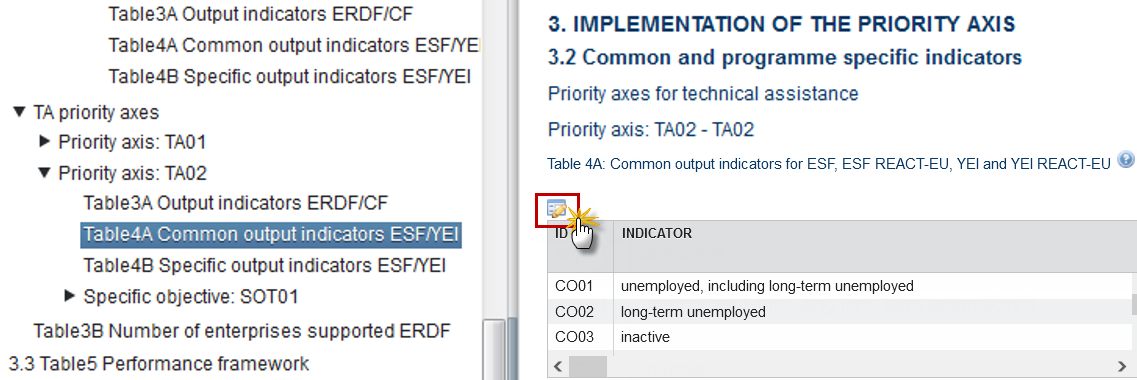
The Edit Details pop-up window appears:

Enter the following information:
(1) Enter the values for 20XX Men and 20XX Women
(2) Click on the Update link to save the information.
Note | For each non-TA Priority Axis/ESF Investment Priority/Category of Region, all Common ESF Output Indicators need to be foreseen. For each ESF TA Priority Axis, all Common ESF Output Indicators need to be foreseen. The Target Value(s) are copied from the equivalent records in Tables 5 (same PA/IP/Category of Region/Indicator). For each ESF TA Priority Axis, only Common ESF Output Indicators with a target in Table 13 (same PA/Category of Region/Indicator) of the linked programme are to be foreseen. Technical assistance priorities are not required to report data on common ESF indicators. Only those common output indicators should be reported which were used in the programme. Since there are no YEI Common Output Indicators, the system will automatically foresee for each non-TA Priority Axis/YEI Investment Priority, all Common ESF Output Indicators which are marked to be used by YEI. The Target Value(s) are copied from the equivalent records in Tables 5 (same PA/IP/Indicator) of the linked programme. There are no YEI TA Priority Axes in the Programme. An additional record "Grand total of participants" is automatically foreseen under each Priority Axis/Investment Priority for non-TA Priority Axes and under each Priority Axis for TA Priority Axes. It is not needed under TA Priority Axes. Common Output Indicators CO01 to CO19 have gender breakdown: Input in Men and Women columns. Common Output Indicators CO20 to CO23 have no gender breakdown: Input in Total column and without decimals. Grand total of participants has no gender breakdown: Input in Total column and without decimals. |
Table 4B
Table 4B – Specific Output Indicators for the ESF, ESF REACT-EU, YEI and YEI REACT-EU
Clicking on the Edit button
 will open a pop-up window allowing you to add the information about the Specific Output Indicators for the ESF and YEI.
will open a pop-up window allowing you to add the information about the Specific Output Indicators for the ESF and YEI.

The Table 4B becomes editable:
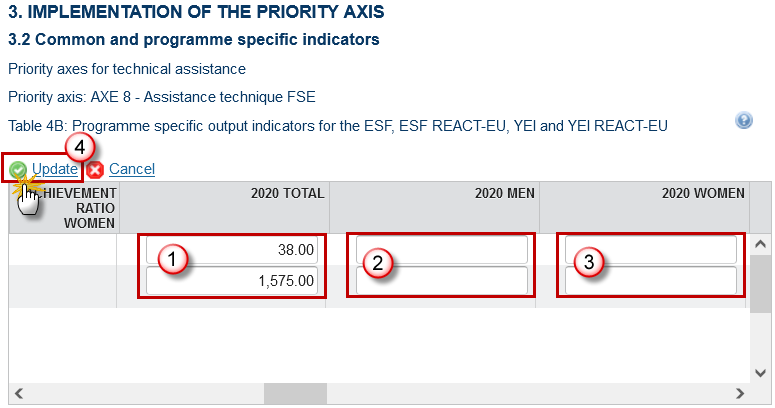
Enter the following information:
(1) Enter the 20XX Total
(2) Enter the 20XX Men
(3) Enter the 20XX Women
(4) Click on the Update link to save the information.
Note | The records will be automatically created from Table 5 (for non-TA Priority Axes) and from Table 13 (for TA Priority Axes) of the linked Programme at creation time. From Table 5 only the Programme Specific Output Indicators linked to ESF/YEI Investment Priorities are taken. From Table 13 only the Programme Specific Output Indicators linked to ESF/YEI Priority Axes are taken. |
Specific Objective: n
Table 1 – Result Indicators for the ERDF, the ERDF REACT-EU and the Cohesion Fund
Clicking on the Edit button
 will open a pop up window allowing you to add the Result Indicators for the ERDF and the CF.
will open a pop up window allowing you to add the Result Indicators for the ERDF and the CF.

The Table 1 becomes editable:

Enter the following information:
(1) Enter the 20XX Total
(2) Enter the 20XX Men
(3) Enter the 20XX Women
(4) Enter the Observations
(5) Click on the Update link to save the information.
Note | The 'Category of Region' Field is displayed but non-editable for TA priority Axes. |
Table 2C Specific Result Indicators for ESF, ESF REACT-EU, YEI and YEI REACT-EU
Clicking on the Edit button
 will open a pop up window allowing you to add the Specific Result Indicators for ESF and YEI.
will open a pop up window allowing you to add the Specific Result Indicators for ESF and YEI.

The Programme Specific Result Indicators for ESF and YEI pop-up window becomes editable:


Enter the following information:
(1) Enter the data
(2) Click on the Update link to save the information.
Note | The records will be automatically created from the Table 12 (for TA Priority Axes) of the linked Programme at creation time. From Table 12 only the Programme Specific indicators linked to ESF/YEI Priority Axes are taken. The list "Output Indicator used as basis for target setting" contains all ESF/YEI Programme Specific and Common Output Indicators defined against the same Priority Axis/Specific Objective (for TA). The different achievement value fields will be enabled/disabled depending on:
|
Table 3B - Number of Enterprises supported by the Operational Programme ERDF Net of Multiple Support to the same Enterprises
Clicking on the Edit button
 will open a pop up window allowing you to add the number of enterprises supported by the Operational Programme ERDF.
will open a pop up window allowing you to add the number of enterprises supported by the Operational Programme ERDF.

The Table 3B becomes editable:
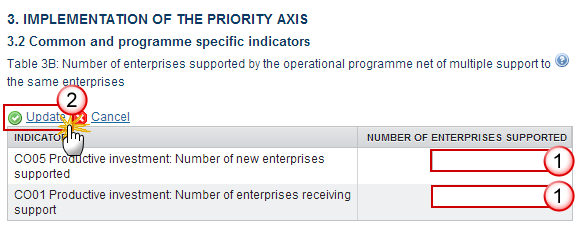
Enter the following information:
(1) Enter the Number of Enterprises Supported
(2) Click on the Update link to save the information.
Note | A record for each of the 5 ERDF and ERDF REACT-EU Common Output Indicators (CO01 to CO05) will automatically be created at creation time when these indicators were used in the linked Programme version. |
3.3 Table 5
Table 5: Performance Framework
Information on the milestones and targets defined in the performance framework.
Note | For ESF/YEI there are standalone Performance Framework indicators which do not exist in the Operational Programmes tables (4A, 4B and 5) and therefore doesn’t exist in the IR tables 2C and 4B. Since the values for the ESF/YEI Specific Output and Result Indicators from IR tables 2C & 4B are automatically generated, these Standalone Performance Framework Indicators don’t get any values. Thus, this table can contain ESF/YEI Programme Specific Output and Result Indicators which do not exist in Tables 2C or 4B. In that case their values need to be encoded manually. This manually update is only enable for the Programme Specific Output and Result Indicators because for Common Indicators SFC2014 always foresee all of them. Indicators with a qualitative target can only exist for Key Implementation Steps for ERDF/CF in the OP Table 6. If such qualitative Key Implementation Step Indicator exists, Table 5 will be generated with additional target and annual qualitative columns. In the PRINT however, it will appear the quantitative and qualitative values in the same columns ‘YYYY CUM TOTAL’. |
Clicking on the Edit button
 will open a pop up window allowing you to update the achievements.
will open a pop up window allowing you to update the achievements.

The Table becomes editable:



Enter the following information:
(1) Enter the Cumulative total, the Cumulative total men & Cumulative total women for the current year displayed.
(2) Enter the Cumulative total for the past years displayed.
For the past years only the Cumulative Total columns will be foreseen.
(3) Enter the Observations.
(4) Click on the Update link to save the information.
Note | The records will be automatically created from Table 6 of the linked Programme at creation time. For the active year both Cumulative and Annual, with Total, Men and Women columns will be foreseen. For the past years, only the Cumulative Total columns will be foreseen. There is no performance framework for dedicated REACT-EU programmes and REACT-EU and REACT-EU CARE and REACT-EU SAFE priorities. For ESF/YEI, the Cumulative and Annual Achievement values for Output Indicators will be automatically generated from Tables 4A and 4B of this Implementation Report and cannot be edited. If an Indicator is included in more Investment Priorities within the Priority Axis, then the achievement values will be added up. For Programme Specific Output Indicators, it is possible they do not exist in Table 4B because they were only created in the OP under the Performance Framework table. In that case, for the active year both Cumulative and Annual, with Total, Men and Women values will need to be encoded, and for the past years only the Cumulative Total values will need to be encoded. For ESF/YEI, the Cumulative and Annual Achievement values for Result Indicators will be automatically generated from Tables 2A, 2B and 2C of this Implementation Report, and cannot be edited. If an Indicator is included in more Investment Priorities within the Priority Axis, then the achievement values will be added up. For Programme Specific Result Indicators, it is possible they do not exist in Table 2C because they were only created in the OP under the Performance Framework table. In that case, for the active year both Cumulative and Annual, with Total, Men and Women values will need to be encoded, and for the past years only the Cumulative Total values will need to be encoded. For ESF/YEI, only the Cumulative Total Achievement values for Key Implementation Step Indicators and Financial Indicators need to be encoded. For ERDF/CF, only the Cumulative Total Achievement values for all types of Indicators, or the Qualitative values for a Qualitative Key Implementation Step need to be encoded. Nothing is calculated. Previous year’s Cumulative Total Achievement or Qualitative values of Indicators with non-generated achievement values can always be updated. The Observations field for all types of Indicators and Funds is always editable. Indicators with a qualitative target can only exist for Key Implementation Steps for ERDF/CF in the OP Table 6. If such qualitative Key Implementation Step Indicator exists, Table 5 will be generated with additional target and annual qualitative columns. In the PRINT however, it will appear the quantitative and qualitative values in the same columns ‘YYYY CUM TOTAL’. |
Financial Data
Table 6
Table 6 by priority axis
Financial information at Priority Axis and Programme level (as set out in Table 1 of Annex II to Commission Implementing Regulation (EU) No 1011/2014 (Model for the transmission of financial data)).
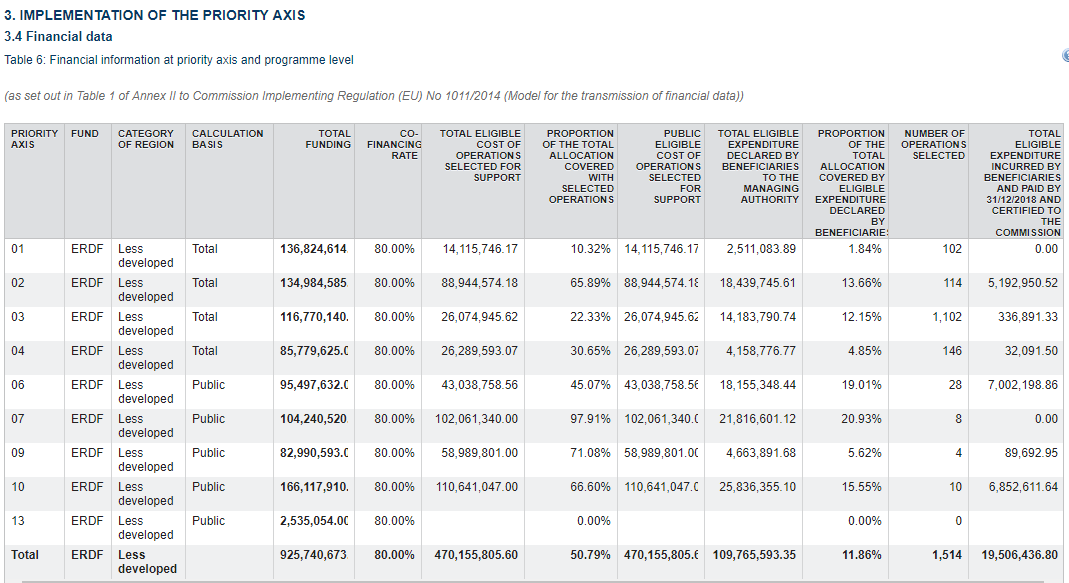
REMARK | Table 6 and 7 are not to be encoded anymore. Table 6 is shown as they exist in Table 1 of the Financial Data submission of 31/01/Reporting Year+1. For FIR, the table is shown as it exists in Table 1 of the Financial Data submitted for 31/01/Last available Reporting Year. There is NO Section 15 as such in the AIR, this section describes for the 2019 submission an additional column on Table 6. The column “Total eligible expenditure incurred by beneficiaries and paid by 31/12/2018 and certified to the Commission” is only displayed in AIR2018. Its value comes from the “2018 CUM TOTAL” value of the Financial Indicators for each Priority Axis, Fund and Category of Region in Table 5. The column “Total eligible expenditure incurred by beneficiaries and paid by 31/12/2023 and certified to the Commission” is only displayed in the FIR. Its value comes from the “2023 CUM TOTAL” value of the Financial Indicators for each Priority Axis, Fund and Category of Region in Table 5. |
Table 7
Table 7 by categories
Breakdown of the cumulative financial data by category of intervention for ERDF, the ESF and the Cohesion fund.
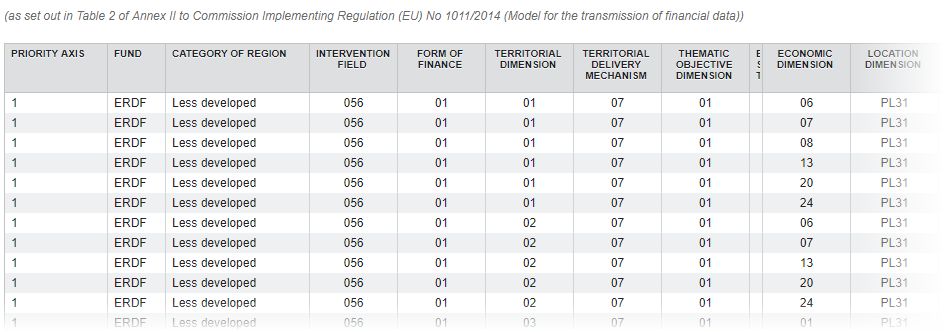
REMARK | Table 6 and 7 are not to be encoded anymore. Table 7 is shown as it exists in Table 2 of the Financial Data submission of 31/01/Reporting Year+1. For a FIR, the table is shown as it exists in Table 2 of the Financial Data submitted for 31/01/Last available Reporting Year. |
Table 8
Table 8 ERDF/ESF cross financing
Clicking on the Add button
 will open a pop up window allowing you to fill the fields of the form to add the information.
will open a pop up window allowing you to fill the fields of the form to add the information.Selecting a row and clicking on the Remove button
 will delete the selected row.
will delete the selected row.Selecting row and click in the Edit button
 will allow you to modify the information.
will allow you to modify the information.
Click on the Add button
 to add information in the table 8, the use made of cross-financing.
to add information in the table 8, the use made of cross-financing.
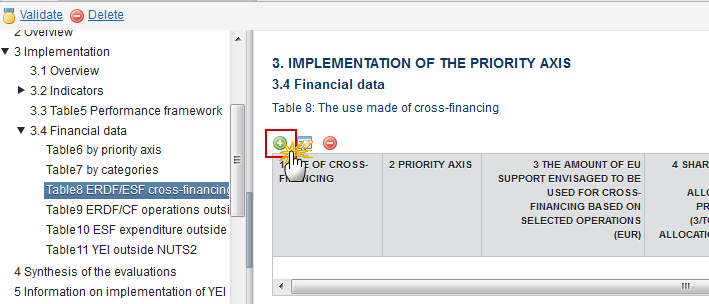
The Edit Details pop-up window appears:

Select the following information:
(1) Select a Priority Axis.
(2) Select the use of cross-financing Costs supported from the: Fund.
(3) Enter the amount of EU Support envisaged to be used for cross-financing based on selected operations (EUR).
(4) Enter the amount of EU Support used under cross financing based on eligible expenditure declared by the beneficiary to the Managing Authority (EUR).
(5) Click on the Update link to save the information.
Note | The list of Priority Axes contains all ERDF, ERDF REACT-EU, and ESF and ESF REACT-EU Priority Axes from the linked Programme version. So, no CARE and REACT-EU CARE and no SAFE and REACT-EU SAFE Priority Axes. The Fund list for cross-financing contains ERDF and/or ESF depending on which ones have been defined in the linked Programme under that Priority Axis. The "Use of cross-financing: Supported from" list contains
Calculation of ‘share’ columns changes to take into account the performance reserve:
|
Table 9
Table 9 - Cost of Operations Implemented outside the Programme Area (the ERDF, the ERDF REACT-EU and the Cohesion Fund under the Investment for growth and jobs goal)
Clicking on the Add button
 will open a pop up window allowing you to fill the fields of the form to add the information.
will open a pop up window allowing you to fill the fields of the form to add the information.Selecting a row and clicking on the Remove button
 will delete the selected row.
will delete the selected row.Selecting row and click in the Edit button
 will allow you to modify the information.
will allow you to modify the information.
Click on the Add button
 to add the Cost of Operations implemented outside the Programme area.
to add the Cost of Operations implemented outside the Programme area.
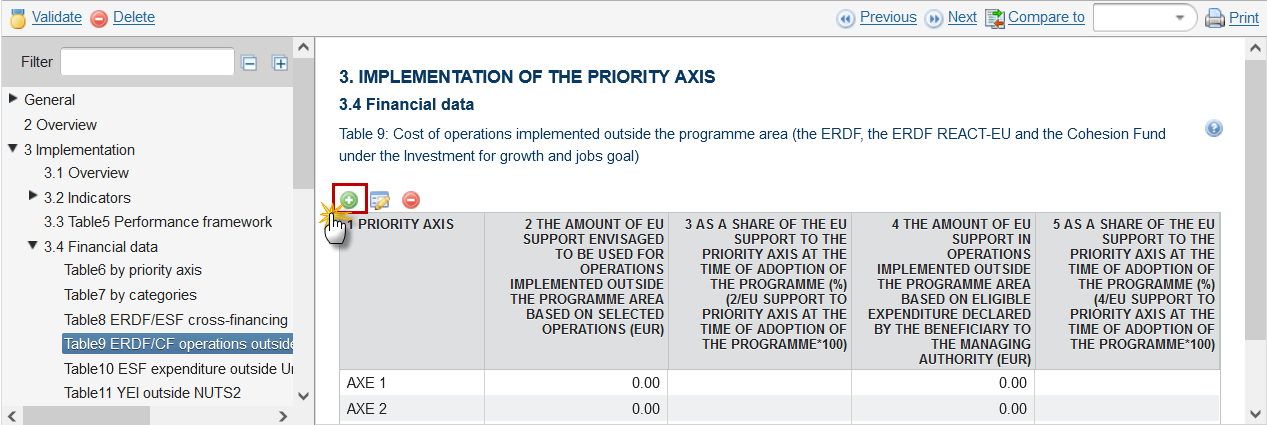
The Edit Details becomes editable:

Select the following information:
(1) Select a Priority Axis.
(2) Enter The Amount of support envisaged to be used for operations implemented outside the Programme area based on selected operations (EUR).
(3) Enter The Eligible Expenditure incurred in Operations implemented outside the Programme area declared by the beneficiary to the Managing Authority (EUR).
(4) Click on the Update link to save the information.
Note | The list of Priority Axes contains all ERDF and CF Priority Axes from the linked Programme version. Calculation of ‘share’ columns changes to take into account the performance reserve:
|
Table 10
Table 10 – ESF Expenditure Incurred Outside the Union (ESF and ESF REACT-EU)
Click on the Edit button
 to add the Expenditure incurred outside the Union (ESF and ESF REACT-EU).
to add the Expenditure incurred outside the Union (ESF and ESF REACT-EU).

The Table 10 becomes editable:

Select the following information:
(1) Enter the Amount of Expenditure envisaged to the incurred outside the Union under thematic objectives 8 and 10 based on selected Operations (EUR).
(2) Select the Eligible expenditure incurred outside the Union declared by the beneficiary to the Managing Authority.
(3) Click on the Update link to save the information.
Table 11
Table 11 - Allocation of YEI Resources to Young People outside the Eligible NUTS Level 2 Regions
Click on the Edit button
 to add the allocation of YEI Resources outside NUTS level 2.
to add the allocation of YEI Resources outside NUTS level 2.

The table 11 for the allocation of YEI resources becomes editable:

Enter the following information:
(1) Enter the Amount of EU Support under the YEI (YEI specific allocation and corresponding ESF Support) envisaged to be located to young people outside the eligible NUTS Level 2 Regions (EUR), as indicated in section 2.A.6.1 of the OP
(2) Enter the Amount of EU Support under the YEI (YEI specific allocation and corresponding ESF Support) allocated to operations to support young people outside the eligible NUTS Level 2 Regions (EUR)
(3) Enter the Eligible expenditure incurred in Operations to support young people outside the eligible Regions (EUR)
(4) Enter the Corresponding EU Support to eligible expenditure incurred in operations to support young people outside the eligible Regions, resulting from applying the Co-Financing rate of the Priority Axis (EUR)
(5) Click on the Update link to save the information.
Note | The records will be automatically created from the YEI Priority Axes of the linked Programme version at creation time. |
4. Synthesis of the Evaluations
Synthesis of the findings of all evaluations of the programme that have become available during previous financial year, with reference of name and reference period of the evaluation reports used.
Click on the Edit button
 to add the Synthesis of the Evaluations.
to add the Synthesis of the Evaluations.
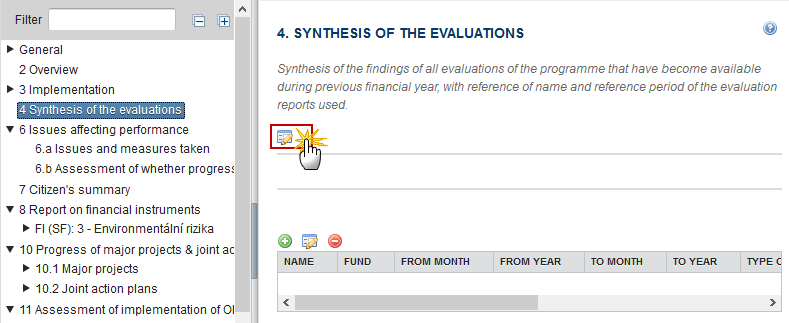
The Edit Details pop-up window appears:
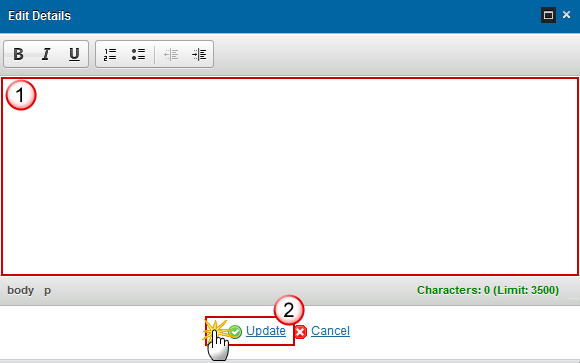
Enter the following information:
(1) Enter a description text.
(2) Click on the Update link to save the information.
Click on the Add button
 to add the information in the evaluation table.
to add the information in the evaluation table.

The Edit Details pop-up window appears:
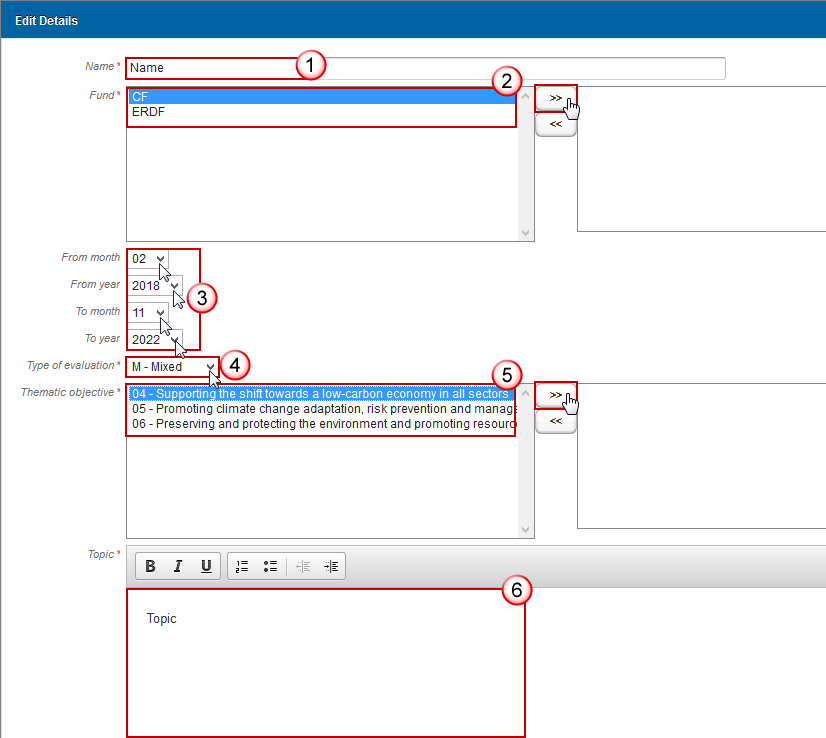
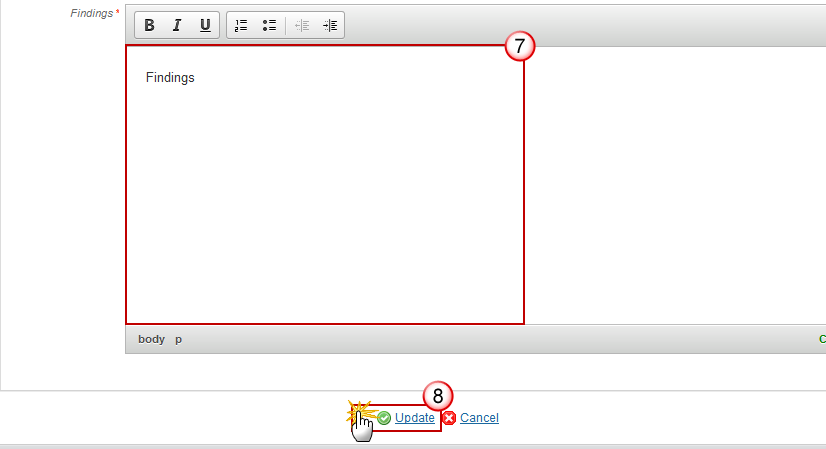
Select the following information:
(1) Enter the Name
(2) Select the Funds
The Funds list contains all Funds covered by the Programme.
(3) Enter the reference period from month, from year & to month, to year.
(4) Select the type of evaluation
(5) Select the Thematic Objectives
The Thematic Objectives list contains all Thematic Objectives covered by the Programme.
(6) Enter the topic
(7) Enter the findings
(8) Click on the Update link to save the information.
5. Information on Implementation of YEI
Clicking on the Edit button
 will open a pop up window allowing you to add a description text.
will open a pop up window allowing you to add a description text.

The Edit Details pop-up window appears:
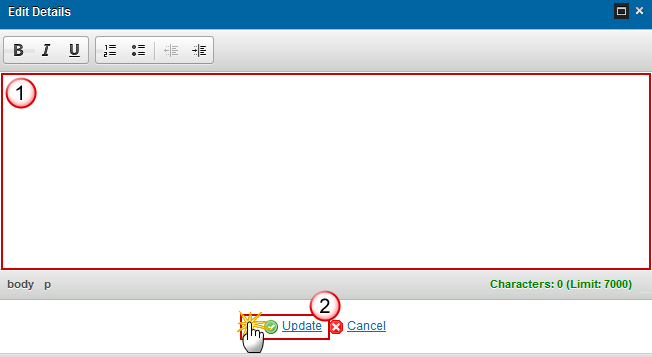
Enter the following information:
(1) Enter a description text.
(2) Click on the Update link to save the information.
6. Issues affecting Performance
Issues affecting the performance of the programme and the measures taken.
6.a Issues and Measures taken
(a) Issues which affect the performance of the programme and the measures taken
Clicking on the Edit button
 will open a pop up window allowing you to add a description text for the Issues and memories taken.
will open a pop up window allowing you to add a description text for the Issues and memories taken.

The Edit Details pop-up window appears:

Enter the following information:
(1) Enter a description text.
(2) Click on the Update link to save the information.
6.b Assessment of whether Progress is sufficient
(b) OPTIONAL FOR LIGHT REPORTS, otherwise it will be included in point 11.1 of the model.
An assessment of whether progress made towards targets is sufficient to ensure their fulfilment, indicating any remedial actions taken or planned, where appropriate.
Clicking on the Edit button
 will open a pop up window allowing you to add a description text for the Assessment of whether Progress is sufficient.
will open a pop up window allowing you to add a description text for the Assessment of whether Progress is sufficient.

The Edit Details pop-up window appears:

Enter the following information:
(1) Enter a description text.
(2) Click on the Update link to save the information.
7. Citizen's Summary
A citizen's summary of the contents of the Annual and the Final Implementation Reports shall be made public and uploaded as a separate file in the form of annex to the Annual and the Final Implementation Report.

8. Report on Financial Instruments
List of Financial Instruments
REMARK | There are structural changes implemented in the Financial Instruments from AIR 2017 onwards: 1. Elements 33, 34, 38, 38.3.1, 38.3.2, 39, 39.1, 39.2, 39.3 and 40 will not occur anymore under the Financial Instrument but under the Product(s). 2. The calculated achieved leverage effect (39.2) will be persisted so that the reports do not have to implement the calculation formulas. 3. Since the calculated achieved leverage effect (39.2) has been moved from FI level to Product level, the formulas to calculate were modified. 4. Elements 12 and 12.1 under "MA" are not shown any more from AIR2017 onwards. 5. Element 26.1 under "SF" were added from AIR2017 onwards. 6. Elements 18, 19 and 20 under "FoF" are not shown any more from AIR2017 onwards. 7. The labels for elements 24, 25, 27, 28, 33, 34, 39.1, 39.2 and 39.3 were made product specific. 8. New elements: 7.3, 37.3, 38.1A, 38.2A, 38.3A Now on the creation of a new Annual Implementation Report, the Financial Instruments data is also imported from previous Annual Implementation Report year’s. |
REMARK | There are changes implemented in the Financial Instruments from AIR 2018 onwards: 1. New elements under FOF, SF/FoF, SF & MA: 7.3, 37.3, 38.1.A & 38.2A. 2. New elements under Equity, Guarantee & Loan: 38.3A. 3. Modified element descriptions: 7.2, 10, III, 11.1, VII, 37, 37.1 & 40. 4. Changed Reference Data: - Implementation Arrangement Type: c changed and renamed to d, new c and changed b - Implementation Body Type: changed b4 - Implementation Body Selection Procedure: new 6 |
Clicking on the Add button
 will open a pop up window allowing you to add a financial instrument.
will open a pop up window allowing you to add a financial instrument.

The Edit Details pop-up window appears:

Enter the following information:
(1) Enter the name of the financial instrument
(2) Select the type of the financial instrument
There are 4 different options:

(3) Select the related Fund of Funds
(4) Click on the Update link to save the information.
Financial Instrument (FoF)
Financial instrument (Fund of Funds)
Clicking on the Edit button
 will open the financial instrument table allowing you to enter the information.
will open the financial instrument table allowing you to enter the information.

The table becomes editable:
PRE-2017 AIR
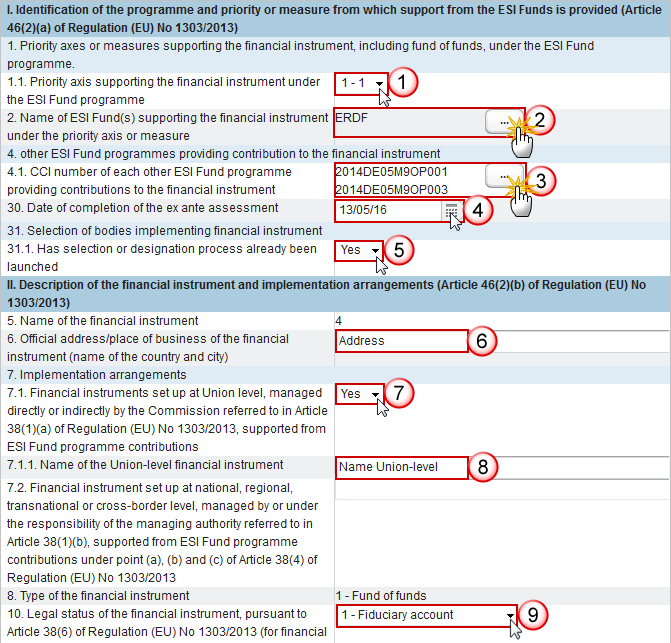


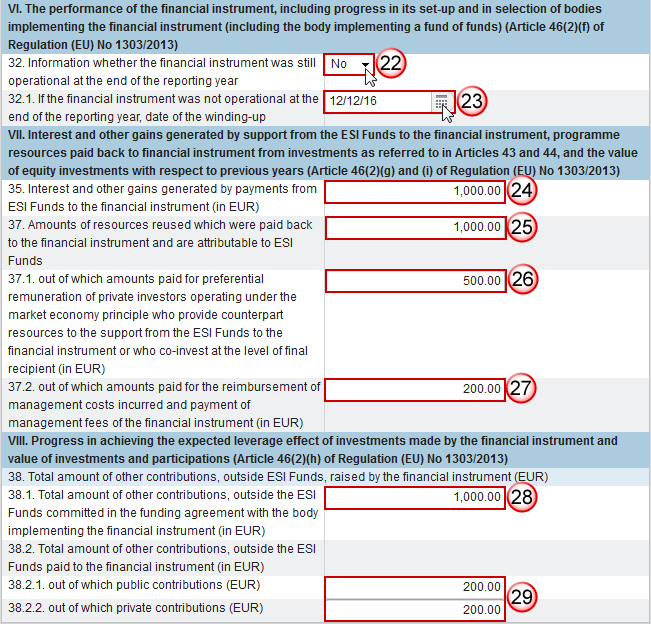
Enter the following information:
(1) Select the Priority Axis
The list of Priority Axes (1.1) contains all Priority Axes of the linked Programme Version.
(2) Select the name of ESI Fund supporting the financial instrument:
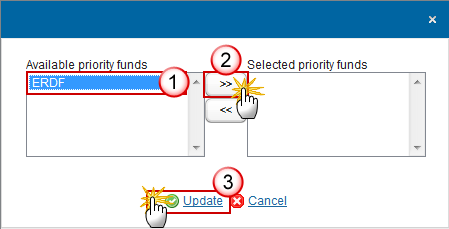
REMARK | The list of Funds (2) contains all Funds of the selected Priority Axis. When the Priority Axis is mono-Fund, this Fund will be selected by default. |
(3) Select the CCI number of each other ESI Fund:

REMARK | The list of Other ESI Fund Programmes (4.1) contains all IGJ, EMFF and EAFRD Programmes of the same Member State as the linked Programme. |
(4) Select the date of completion of the ex-ante assessment.
(5) Select yes or no if the selection or designation process has been launched.
(6) Enter the address of business of the financial instrument
(7) Select yes or no if the financial instruments set up at Union level, is managed directly or indirectly by the Commission.
(8) Enter the Name of the Union-level financial instrument
The Name of the Union-level financial instrument (7.1.1) is only to be enabled when 7.1 is true.
(9) Select the legal status
(10) Select the type of implementing body
(11) Enter the Name of body
(12) Enter the official address of business of the body implementing the financial instrument
(13) Select the procedure
(14) Select the date of signature of the funding agreement with the body implementing the financial instrument
(15) Enter the total amount of programme contributions committed in the funding agreement
(16) Enter the total amount of programme contributions committed in the funding agreement out of which ESI Funds contributions, ERDF, Cohesion Fund, ESF, EAFRD and EMFF (optional).
(17) Enter the total amount of programme contributions paid to the financial instrument out of which ERDF, Cohesion Fund, ESF, EAFRD, and EMFF (in EUR).
(18) Enter the total amount of programme contributions paid to the financial instrument out of which total amount of national co-financing out of which total amount of national public funding and private funding.
(19) Enter the total amount of programme contributions paid to the financial instrument under YEI.
(20) Enter the total amount of management costs and fees paid out of programme contributions.
(21) Enter the amount out of which base remuneration and performance-based remuneration.
(22) Select whether the financial instrument was still operational at the end of the reporting year.
(23) Select the date of the winding-up if it was not operational.
(24) Enter the interest and other gains generated by payments from ESI Funds to the financial instrument.
(25) Enter the Amounts of resources reused which were paid back to the financial instrument and are attributable to ESI Funds.
(26) Enter the Amounts of resources reused which were paid back to the financial instrument and are attributable to ESI Funds out of which amounts paid for preferential remuneration of private investors operating under the market economy principle.
(27) Enter the Amounts of resources reused which were paid back to the financial instrument and are attributable to ESI Funds out of which amounts paid for the reimbursement of management costs incurred and payment of management fees of the financial instrument.
(28) Enter the total amount of other contributions, outside the ESI Funds committed in the funding agreement with the body.
(28) Enter the total amount of other contributions outside the ESI Funds paid to the financial instrument out of which public contributions and private contributions.
(29) Click on the Update link to save the information.
REMARK | The list of Priority Axes (1.1) contains all Priority Axes of the linked Programme Version. The Name of the Union-level financial instrument (7.1.1) is only to be enabled when 7.1 is true. The Description of the other procedure (12.1) is only to be enabled when the value of 12 = 'Others' Elements 18 to 21 are only to be enabled when Final Implementation Report. The Date of winding-up (32.1) is only to be enabled when 32 is false. |
2017 AIR Onwards

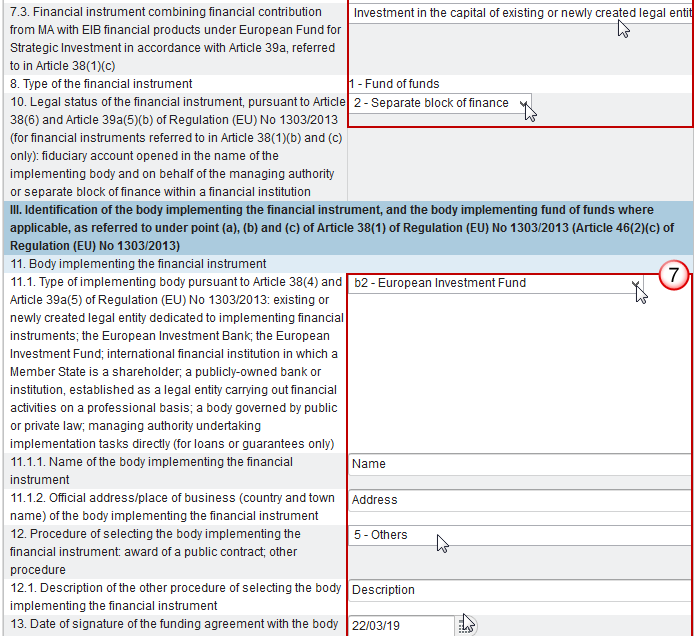

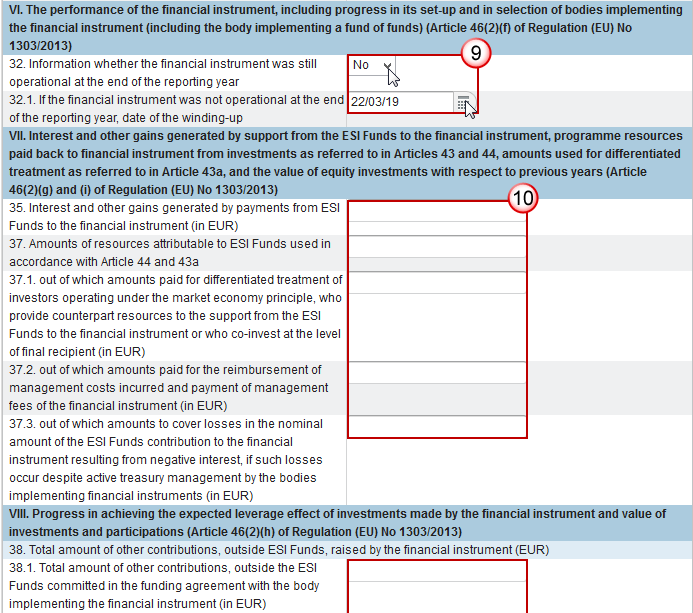

Enter the following information:
(1) Select the Priority Axis
The list of Priority Axes (1.1) contains all Priority Axes of the linked Programme Version.
(2) Select the name of ESI Fund supporting the financial instrument:

REMARK | The list of Funds (2) contains all Funds of the selected Priority Axis. When the Priority Axis is mono-Fund, this Fund will be selected by default. |
(3) Select the CCI number of each other ESI Fund:

REMARK | The list of Other ESI Fund Programmes (4.1) contains all IGJ, EMFF and EAFRD Programmes of the same Member State as the linked Programme. |
(4) Select the date of completion of the ex-ante assessment.
(5) Select yes or no if the selection or designation process has been launched.
(6) Enter the information for the section II. Description of the financial instrument and implementation arrangements.
The Name of the Union-level financial instrument (7.1.1) is only to be enabled when 7.1 is true.
(7) Enter the information for section III. Identification of the body implementing the financial, and the body implementing fund of funds where applicable.
The Description of the other procedure (12.1) is only to be enabled when the value of 12 = 'Others' (code 5).
(8) Enter the information for section IV. Total amount of programmes contributions, by priority or measure, paid to the financial instrument and management costs incurred or management fees paid.
2017AIR onwards, element 21 is only to be enabled when Final Implementation Report.
(9) Enter the information for section VI. The performance of the financial instrument, including progress in its set-up an in selection of bodies implementing the financial instrument.
(10) Enter the information for section VII. Interest and other gains generated by support from the ESI Funds to the financial instrument.
(11) Enter the information for section VIII. Progress in achieving the expected leverage effect of investments made by the financial instrument and value of investments.
(12) Click on the Update link to save the information.
REMARK | Elements 33, 34, 38, 38.3.1, 38.3.2, 39, 39.1, 39.2, 39.3 and 40 will not occur anymore under the Financial Instrument but under the Product(s). 2017AIR onwards, element 21 is only to be enabled when Final Implementation Report. The content for 38.2, 38.2.1, 38.2.2 are optional in the years 2017 and 2019. New elements from AIR 2018 onwards: 7.3, 37.3, 38.1.A & 38.2A. |
Thematic objectives
Clicking on the Add button
 will open the thematic objectives table allowing you to enter the information.
will open the thematic objectives table allowing you to enter the information.

The Edit Details pop-up window appears:

Enter the following information:
(1) Select the Thematic objective
The list of Thematic Objectives (3) contains all Thematic Objectives covered by the selected Priority Axis.
(2) Enter the amount of ESI funds committed to this thematic objective
(3) Click on the Update link to save the information.
REMARK | The list of Thematic Objectives (3) contains all Thematic Objectives covered by the selected Priority Axis. |
Financial Instrument (SF/FoF): Specific Fund/Fund of Funds
Clicking on the Edit button
 will open the Financial instrument: Specific Fund table allowing you to enter the information.
will open the Financial instrument: Specific Fund table allowing you to enter the information.
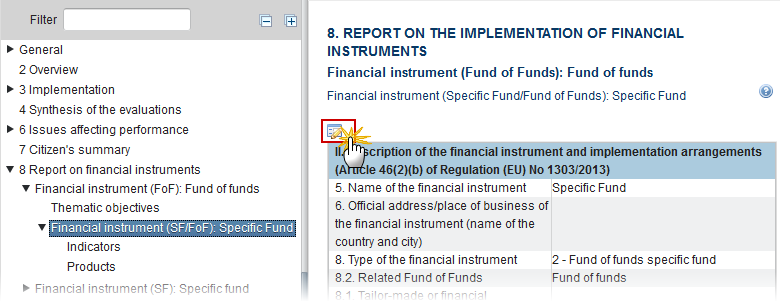
The table becomes editable:
PRE-AIR 2017
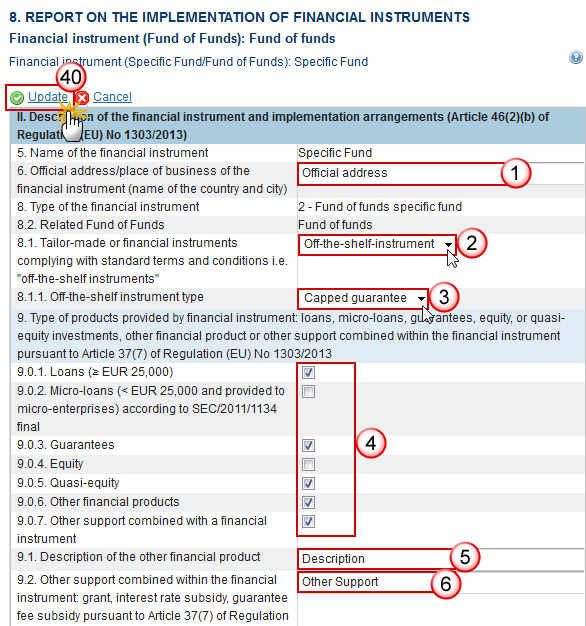

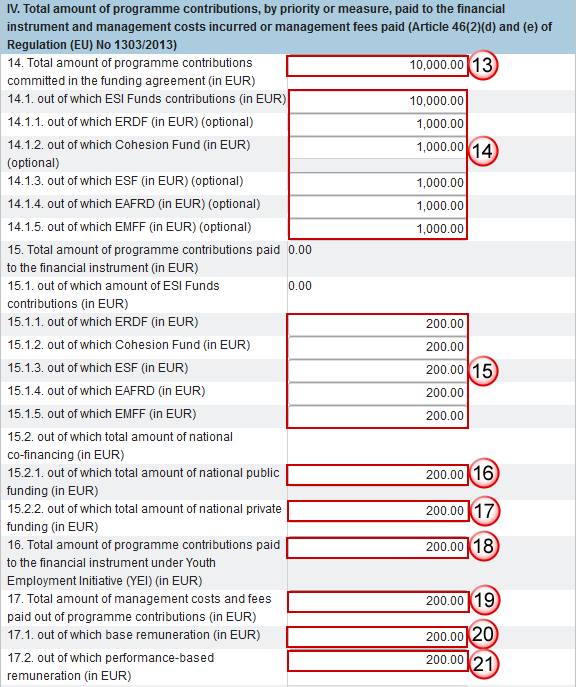
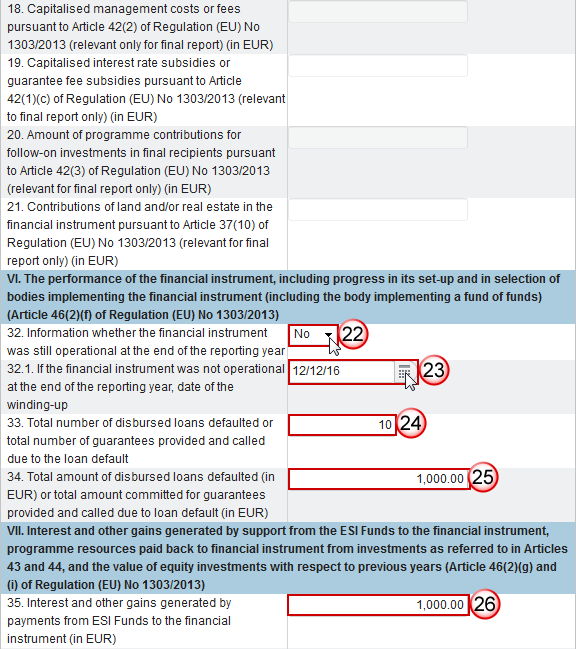


Enter the following information:
(1) Enter the Official address of the financial instrument
(2) Select the tailor-made or financial instrument
(3) Select the off-the-self instrument type
(4) Select the type of products provided by financial instrument: loans, micro-loans, guarantees, equity or quasi-equity investments, other financial products or other support combined with a financial instrument
(5) Enter a description of the other financial product
(6) Enter the other support
(7) Select the legal status of the financial instrument
(8) Select the type of implementing body
(9) Enter the name of the body
(10) Enter the official address of the body
(11) Select the procedure of selecting the body
(12) Select the date of signature of the funding agreement with the body
(13) Enter the total amount of programme contributions committed in the funding agreement
(14) Enter the amount of programme contributions committed in the funding agreement out of which ESI Funds contributions (in EUR), ERDF (optional), Cohesion Fund (optional), ESF Fund (optional), EAFRD (optional), EMFF (optional)
(15) Enter the amount of programme contributions paid to the financial instrument out of which amount ERDF, Cohesion Fund, ESF, EAFRD, EMFF (in EUR)
(16) Enter the amount of programme contributions paid out of which total amount of national public funding
(17) Enter the amount of programme contributions paid out of which total amount of national private funding
(18) Enter the total amount of programme contributions paid to the financial instrument under YEI
(19) Enter the total amount of management costs and fees paid out of programme contributions
(20) Enter the amount of management costs and fees paid out of which base remuneration
(21) Enter the amount of management costs and fees paid out of which performance-based remuneration
(22) Select yes or no for the information whether the financial instrument was still operational at the end of the reporting year
(23) Select the date of the winding-up
(24) Enter the total number of disbursed loans defaulted or total number of guarantees provided
(25) Enter the total amount of disbursed loans defaulted (in EUR) or total amount committed for guarantees provided
(26) Enter the interest and other gains generated by payments from ESI Funds
(27) Enter the amount repaid to the financial instrument attributable to support from ESI Funds out of which capital repayments
(28) Enter the amount repaid to the financial instrument attributable to support from ESI Funds out of which gains, other earnings and yields
(29) Enter the amounts of resources reused which were paid back to the financial instrument and are attributable to ESI Funds
(30) Enter the amounts of resources reused which were paid back to the financial instrument out of which amounts paid for preferential remuneration of private investors operating under the market economy principle
(31) Enter the amounts of resources reused which were paid back to the financial instrument out of which amounts paid for the reimbursement of management costs incurred and payment of management fees
(32) Enter the amount of value of investments and participations in equity
(33) Enter the total amount of other contributions, outside the ESI Funds committed in the funding agreement with the body
(34) Enter the total amount of other contributions, outside the ESI Funds paid to the financial instrument out of which public contributions
(35) Enter the total amount of other contributions, outside the ESI Funds paid to the financial instrument out of which private contributions
(36) Enter the total amount of other contributions, outside the ESI Funds mobilised at the level of final recipients out of which public contributions
(37) Enter the total amount of other contributions, outside the ESI Funds mobilised at the level of final recipients out of which private contributions
(38) Enter the expected leverage effect for loan/guarantee/equity or quasi-equity investment/other financial product, by reference to the funding agreement
(39) Enter the investment mobilised through ESIF financial instruments for loan/guarantee/equity and quasi-equity investment (optional)
(40) Click on the Update link to save the information.
REMARK | The Off-the-shelf instrument type (8.1.1) is only to be enabled when 8.1 is true. The Description of the other financial product (9.1) is only to be enabled when 9.0.6 is true. The Description of the other financial product (9.2) is only to be enabled when 9.0.7 is true. The Description of the other procedure (12.1) is only to be enabled when the value of 12 = 'Others' (Internal code 5). Elements 18 to 21 are only to be enabled when Final Implementation Report. The Date of winding-up (32.1) is only to be enabled when 32 is false. |
2017 AIR Onwards
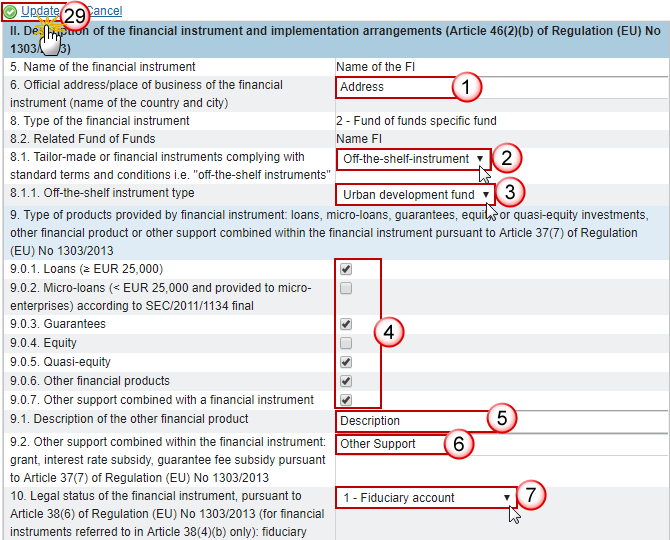
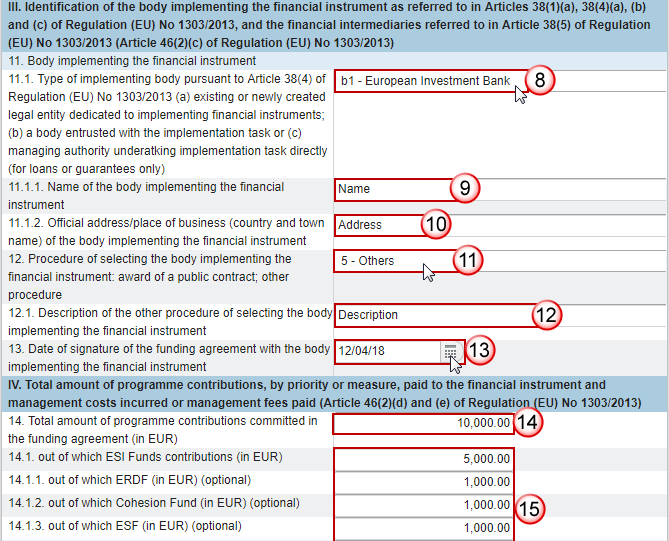
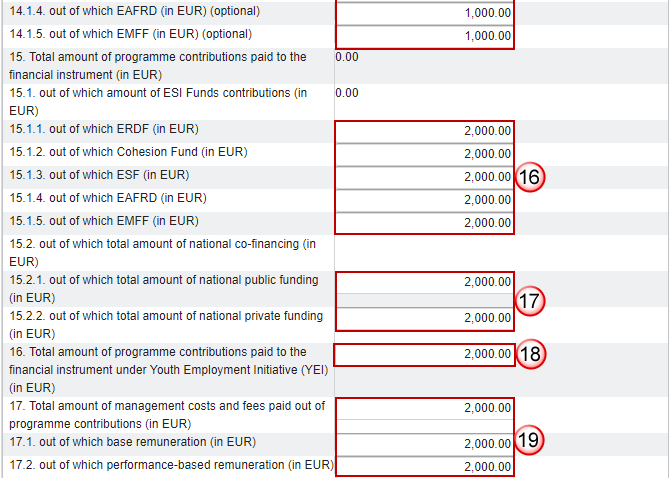
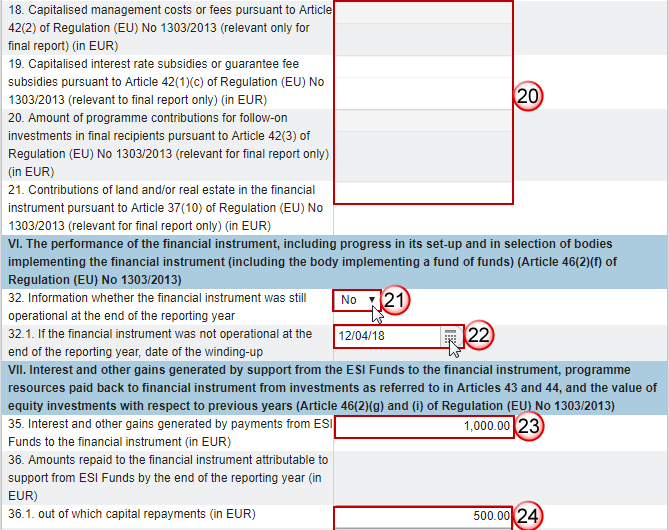
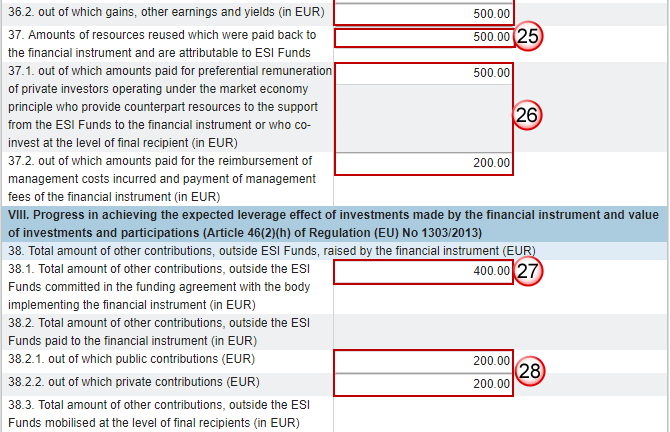
Enter the following information:
(1) Enter the Official address of the financial instrument
(2) Select the tailor-made or financial instrument
(3) Select the off-the-self instrument type
(4) Select the type of products provided by financial instrument: loans, micro-loans, guarantees, equity or quasi-equity investments, other financial products or other support combined with a financial instrument
(5) Enter a description of the other financial product
(6) Enter the other support
(7) Select the legal status of the financial instrument
(8) Select the type of implementing body
(9) Enter the name of the body
(10) Enter the official address of the body
(11) Select the procedure of selecting the body
(12) Enter the description
(13) Select the date of signature of the funding agreement with the body
(14) Enter the total amount of programme contributions committed in the funding agreement
(15) Enter the amount of programme contributions committed in the funding agreement out of which ESI Funds contributions (in EUR), ERDF (optional), Cohesion Fund (optional), ESF Fund (optional), EAFRD (optional), EMFF (optional)
(16) Enter the amount of programme contributions paid to the financial instrument out of which amount ERDF, Cohesion Fund, ESF, EAFRD, EMFF (in EUR)
(17) Enter the amount of programme contributions paid out of which total amount of national public funding
(18) Enter the amount of programme contributions paid out of which total amount of national private funding
(19) Enter the total amount of management costs and fees paid out of programme contributions & out of which base remuneration and out of which performance-based.
(20) Elements 18 to 21 are only to be enabled when Final Implementation Report.
(21) Select yes or no for the information whether the financial instrument was still operational at the end of the reporting year
(22) Select the date of the winding-up
(23) Enter the interest and other gains generated by payments from ESI funds
(24) Enter the amount repaid to the financial instrument attributable to support from ESI Funds out of which capital repayments
(25) Enter the amounts of resources reused which were paid back to the financial instrument and are attributable to ESI Funds
(26) Enter the amounts of resources reused which were paid back to the financial instrument out of which amounts paid for preferential remuneration of private investors operating under the market economy principle & out of which amounts paid for the reimbursement of management costs incurred and payment of management fees.
(27) Enter the total amount of other contributions, outside the ESI Funds committed in the funding agreement with the body.
(28) Enter the total amount of other contributions, outside the ESI Funds paid to the financial instrument out of which public contributions and out of which private contributions
(29) Click on the Update link to save the information.
REMARK | The Off-the-shelf instrument type (8.1.1) is only to be enabled when 8.1 is true. The Description of the other financial product (9.1) is only to be enabled when 9.0.6 is true. The Description of the other financial product (9.2) is only to be enabled when 9.0.7 is true. The Description of the other procedure (12.1) is only to be enabled when the value of 12 = 'Others' (Internal code 5). Elements 18 to 21 are only to be enabled when Final Implementation Report. The Date of winding-up (32.1) is only to be enabled when 32 is false. The content for 38.2, 38.2.1, 38.2.2, 38.3.1 & 38.3.2 are optional in the years 2017 and 2019. New elements from AIR 2018 onwards: 7.3, 37.3, 38.1.A & 38.2A. |
Indicators
Clicking on the Add button
 will open the indicators table allowing you to enter the information.
will open the indicators table allowing you to enter the information.
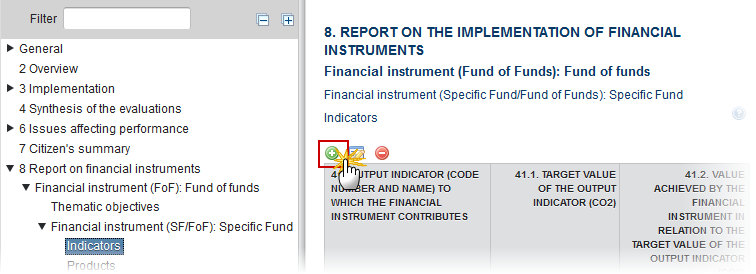
The Edit Details pop-up window appears:

Enter the following information:
(1) Select the Output indicator.
(2) Enter the Target value of the output indicator (CO2).
(3) Enter the value achieved by the financial instrument in relation to the target value of the output indicator (CO2).
(4) Click on the Update link to save the information.
REMARK | The list of Output Indicators (41) contains all Common and Programme Specific Output Indicators used in the linked Programme version under the selected Priority Axis. |
Products
REMARK | Products: 1. Elements 33, 34, 38, 38.3.1, 38.3.2, 39, 39.1, 39.2, 39.3 and 40 will not occur anymore under the Financial Instrument but under the Product(s). 2. The calculated achieved leverage effect (39.2) will be persisted so that the reports do not have to implement the calculation formulas. 3. Since the calculated achieved leverage effect (39.2) has been moved from FI level to Product level, the formulas to calculate were modified. 7. The labels for elements 24, 25, 27, 28, 33, 34, 39.1, 39.2 and 39.3 were made product specific. |
Clicking on the Add button
 will open the products table allowing you to enter the information.
will open the products table allowing you to enter the information.

The Edit Details pop-up window appears:
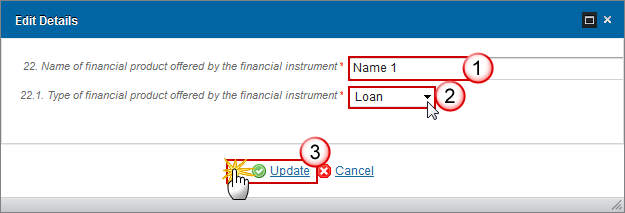
Enter the following information:
(1) Enter the Name of financial product
(2) Select the type of financial product offered

(3) Click on the Update link to save the information.
REMARK | The list of Financial Product Types (22.1) contains all the Financial Product Types relevant for the Financial Instrument Type. |
Equity
Clicking on the Edit button
 will open the financial instrument table allowing you to enter the information.
will open the financial instrument table allowing you to enter the information.
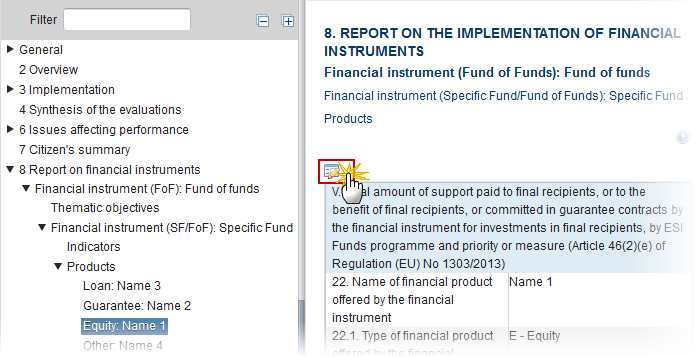
The table becomes editable:
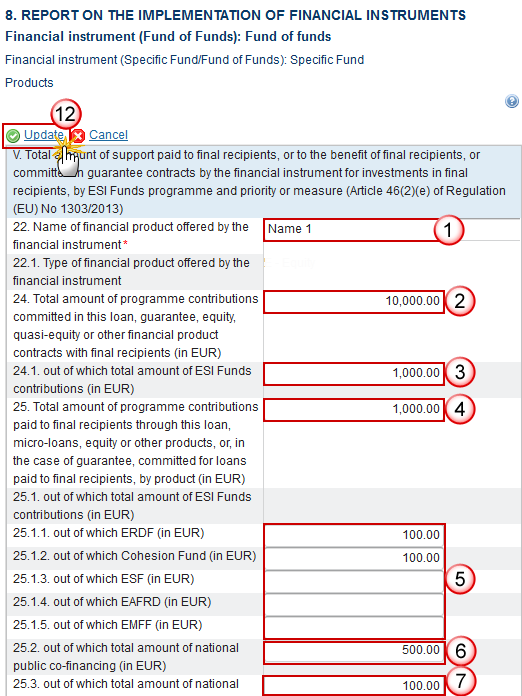
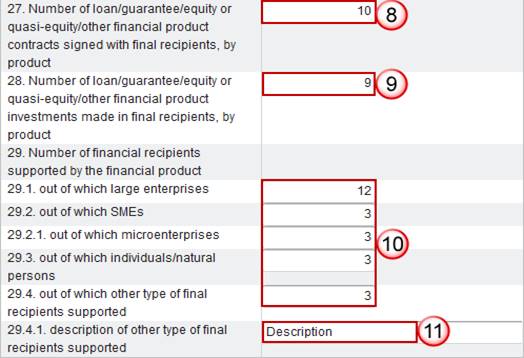
Enter the following information:
(1) Enter the Name of financial product.
(2) Enter the total amount of programme contributions committed in this equity.
(3) Enter the total amount of programme contributions committed in this equity out of which total amount of ESI Funds contributions.
(4) Enter the total amount of programme contributions paid to final recipients through this equity.
(5) Enter the total amount of programme contributions paid to final recipients through this equity paid to final recipients out of which ERDF, Cohesion Fund, ESF, EAFRD, EMFF (in EUR)
(6) Enter the amount of programme contributions paid to final recipients through this equity paid to final recipients out of which total amount of national public co-financing.
(7) Enter the amount of programme contributions paid to final recipients through this equity paid to final recipients out of which total amount of national private co-financing.
(8) Enter the number of loan/guarantee/equity financial product contracts signed with final recipients.
(9) Enter the number of loan/guarantee/equity financial product investments signed with final recipients.
(10) Enter the number of financial recipients supported by the financial product out of which large enterprises, out of which SMEs, out of which microenterprises, out of which individuals/natural persons, out of which other type of final recipients supported.
(11) Enter a description of other type of final recipients supported.
(12) Click on the Update link to save the information.



Enter the following information:
(1) Enter the Name of financial product.
(2) Enter the total amount of programme contributions committed in this equity & out of which total amount of ESI Funds contributions.
(3) Enter the total amount of programme contributions paid to final recipients through this equity, out of which ERDF, Cohesion Fund, ESF, EAFRD, EMFF (in EUR)
(4) Enter the amount of programme contributions paid to final recipients through this equity paid to final recipients out of which total amount of national public & private co-financing.
(5) Enter the number of equity or quasi-equity contracts signed with final recipients.
(6) Enter the number of equity or quasi-equity investments made in final.
(7) Enter the number of financial recipients supported by the financial product out of which large enterprises, out of which SMEs, out of which microenterprises, out of which individuals/natural persons, out of which other type of final recipients supported.
(8) Enter the description of other type of final recipient.
(9) Enter the total amount of other contributions outside the ESI funds, out of which public & private contributions.
(10) Enter the expected leverage effect for equity or quasi-equity investment.
(11) Enter the investment mobilised through ESIF financial instruments for equity and quasi-equity investment.
(12) Click on the Update link to save the information.
REMARK | The Description of other type of financial recipients (29.4.1) is only to be enabled when the value of 29.4 > 0. New element from AIR 2018 onwards: 38.3A. |
Guarantee
Clicking on the Edit button
 will open the guarantee table allowing you to enter the information.
will open the guarantee table allowing you to enter the information.

The table becomes editable:


Enter the following information:
(1) Enter the Name of financial product.
(2) Enter the total amount of programme contributions committed in this guarantee.
(3) Enter the total amount of programme contributions committed in this guarantee out of which total amount of ESI Funds contributions.
(4) Enter the total amount of programme contributions paid to final recipients through this guarantee.
(5) Enter the total amount of programme contributions paid to final recipients through this equity paid to final recipients out of which ERDF, Cohesion Fund, ESF, EAFRD, EMFF (in EUR)
(6) Enter the amount of programme contributions paid to final recipients through this guarantee paid to final recipients out of which total amount of national public co-financing.
(7) Enter the amount of programme contributions paid to final recipients through this guarantee paid to final recipients out of which total amount of national private co-financing.
(8) Enter the number of loan/guarantee/equity financial product contracts signed with final recipients.
(9) Enter the number of loan/guarantee/equity financial product investments signed with final recipients.
(10) Enter the number of financial recipients supported by the financial product out of which large enterprises, out of which SMEs, out of which microenterprises, out of which individuals/natural persons, out of which other type of final recipients supported.
(11) Enter a description of other type of final recipients supported.
(12) Click on the Update link to save the information.
REMARK | The Total value of new debt finance (26.1) is only to be enabled when the value of 7.1 in the master Fund of Funds is true. The Description of other type of financial recipients (29.4.1) is only to be enabled when the value of 29.4 > 0. |
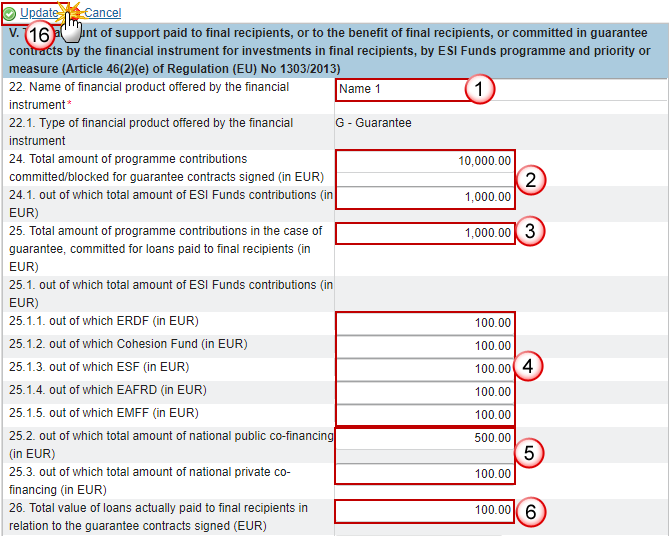
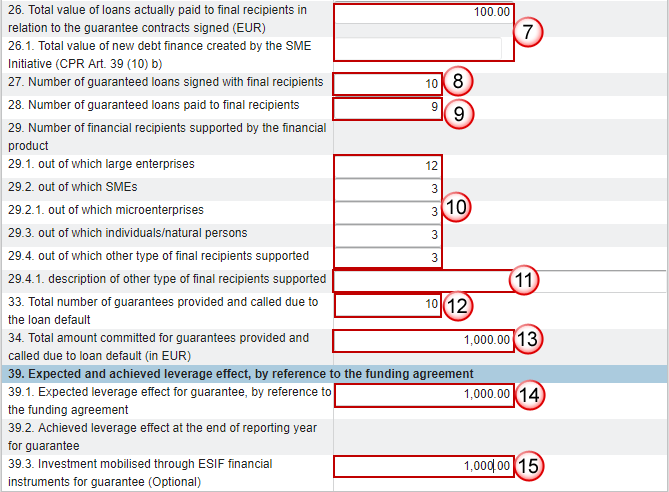
Enter the following information:
(1) Enter the Name of financial product.
(2) Enter the total amount of programme contributions committed in this guarantee and out of which total amount of ESI Funds contributions.
(3) Enter the total amount of programme contributions in the case of guarantee, committed for loans paid to final recipients.
(4) Enter the total amount of programme contributions paid to final recipients through this equity paid to final recipients out of which ERDF, Cohesion Fund, ESF, EAFRD, EMFF (in EUR)
(5) Enter the amount of programme contributions paid to final recipients through this guarantee paid to final recipients out of which total amount of national public co-financing & private co-financing.
(6) Enter the total number number of loans paid to final recipients in relation to the guarantee contracts signed.
(7) Enter the total value of new debt finance created by the SME initiative.
(8) Enter the number of loans signed with final recipients.
(9) Enter the number of loans paid to final recipients.
(10) Enter the number of financial recipients supported by the financial product out of which large enterprises, out of which SMEs, out of which microenterprises, out of which individuals/natural persons, out of which other type of final recipients supported.
(11) Enter a description of other type of final recipients supported.
(12) Enter the total number provided and called due to the loan default.
(13) Enter the total amount committed for guarantees provided and called due to loan default.
(14) Enter the expected leverage effect.
(15) Enter the investment mobilised through ESIF financial instruments.
(16) Click on the Update link to save the information.
REMARK | The Total value of new debt finance (26.1) is only to be enabled when the value of 7.1 in the master Fund of Funds is true. The Description of other type of financial recipients (29.4.1) is only to be enabled when the value of 29.4 > 0. Elements 33, 34, 38, 38.3.1, 38.3.2, 39, 39.1, 39.2, 39.3 and 40 will not occur anymore under the Financial Instrument but under the Product(s). |
Loan
Clicking on the Edit button
 will open the loan table allowing you to add the information.
will open the loan table allowing you to add the information.
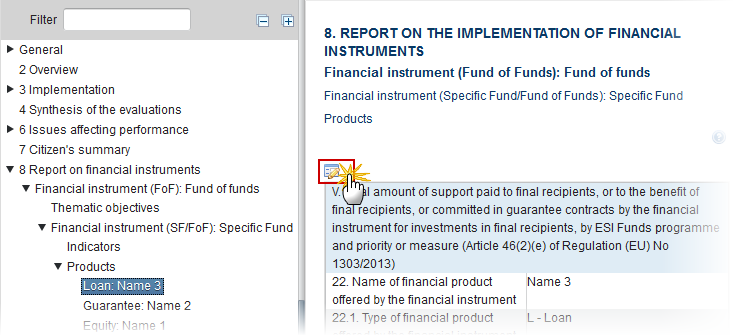
The table becomes editable:


Enter the following information:
(1) Enter the Name of financial product.
(2) Enter the total amount of programme contributions committed in this loan.
(3) Enter the total amount of programme contributions committed in this loan out of which total amount of ESI Funds contributions.
(4) Enter the total amount of programme contributions paid to final recipients through this loan.
(5) Enter the total amount of programme contributions paid to final recipients through this loan paid to final recipients out of which ERDF, Cohesion Fund, ESF, EAFRD, EMFF (in EUR)
(6) Enter the amount of programme contributions paid to final recipients through this loan paid to final recipients out of which total amount of national public co-financing.
(7) Enter the amount of programme contributions paid to final recipients through this loan paid to final recipients out of which total amount of national private co-financing.
(8) Enter the number of loan/guarantee/equity financial product contracts signed with final recipients.
(9) Enter the number of loan/guarantee/equity financial product investments signed with final recipients.
(10) Enter the number of financial recipients supported by the financial product out of which large enterprises, out of which SMEs, out of which microenterprises, out of which individuals/natural persons, out of which other type of final recipients supported.
(11) Enter a description of other type of final recipients supported.
(12) Click on the Update link to save the information.
REMARK | The Description of other type of financial recipients (29.4.1) is only to be enabled when the value of 29.4 > 0. |
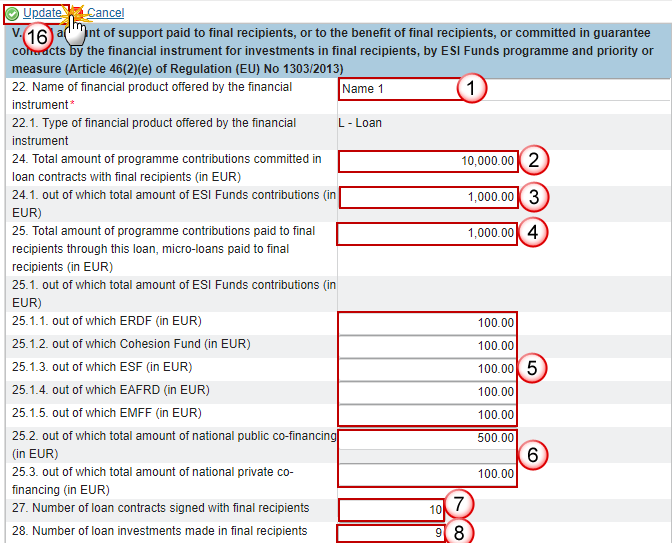
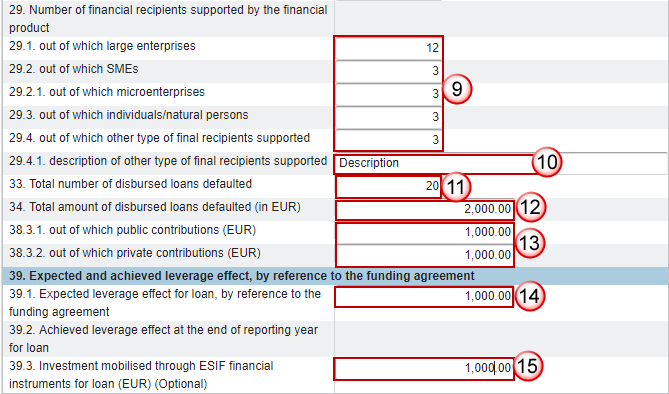
Enter the following information:
(1) Enter the Name of financial product.
(2) Enter the total amount of programme contributions committed in this loan.
(3) Enter the total amount of programme contributions committed in this loan out of which total amount of ESI Funds contributions.
(4) Enter the total amount of programme contributions paid to final recipients through this loan.
(5) Enter the total amount of programme contributions paid to final recipients through this loan paid to final recipients out of which ERDF, Cohesion Fund, ESF, EAFRD, EMFF (in EUR)
(6) Enter the amount of programme contributions paid to final recipients through this loan paid to final recipients out of which total amount of national public & private co-financing.
(7) Enter the number of loan contracts signed with final recipients.
(8) Enter number of loan investments made in final recipients.
(9) Enter the number of financial recipients supported by the financial product out of which large enterprises, out of which SMEs, out of which microenterprises, out of which individuals/natural persons, out of which other type of final recipients supported.
(10) Enter a description of other type of final recipients supported.
(11) Enter the total number of disbursed loans defaulted.
(12) Enter the total amount of disbursed loans.
(13) Out of which public & private contributions.
(14) Enter the expected leverage effect for loan.
(15) Enter the investment mobilised through ESIF for loan.
(16) Click on the Update link to save the information.
REMARK | The Description of other type of financial recipients (29.4.1) is only to be enabled when the value of 29.4 > 0. New element from AIR 2018 onwards: 38.3A. |
Other
Clicking on the Edit button
 will open the other table allowing you to add the information.
will open the other table allowing you to add the information.

The table becomes editable:


Enter the following information:
(1) Enter the Name of financial product.
(2) Enter the total amount of programme contributions committed in other.
(3) Enter the total amount of programme contributions committed in this other out of which total amount of ESI Funds contributions.
(4) Enter the total amount of programme contributions paid to final recipients through this other.
(5) Enter the total amount of programme contributions paid to final recipients through this other paid to final recipients out of which ERDF, Cohesion Fund, ESF, EAFRD, EMFF (in EUR)
(6) Enter the amount of programme contributions paid to final recipients through this other paid to final recipients out of which total amount of national public co-financing.
(7) Enter the amount of programme contributions paid to final recipients through this other paid to final recipients out of which total amount of national private co-financing.
(8) Enter the number of loan/guarantee/equity financial product contracts signed with final recipients.
(9) Enter the number of loan/guarantee/equity financial product investments signed with final recipients.
(10) Enter the number of financial recipients supported by the financial product out of which large enterprises, out of which SMEs, out of which microenterprises, out of which individuals/natural persons, out of which other type of final recipients supported.
(11) Enter a description of other type of final recipients supported.
(12) Click on the Update link to save the information.
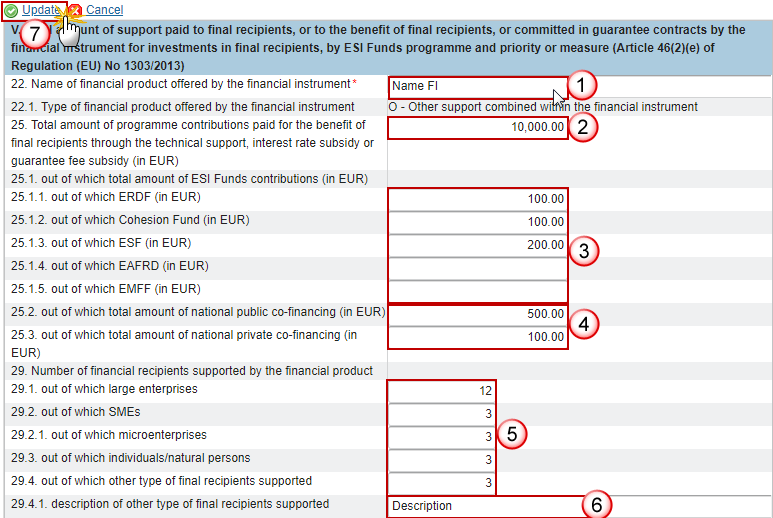
Enter the following information:
(1) Enter the Name of financial product.
(2) Enter the total amount of programme contributions paid for the benefit.
(3) Enter the amount for the contributions paid for the benefit out of which total amount of ESI Funds out of which ERDF, CF, ESF, EAFRD & EMFF (in EUR).
(4) Enter the amount for the contributions paid for the benefit out of which total amount of ESI Funds out of which total amount of national public & private co-financing (in EUR)
(5) Enter the number of financial recipients out of which large enterprises, SMEs, microenterprises, individual/natural persons, other type of final recipients.
(6) Enter the description of other type of final recipients.
(7) Click on the Update link to save the information.
Financial Instrument (SF): Specific fund
Financial instrument (Specific Fund): Specific fund
Clicking on the Edit button
 will open the specific fund table allowing you to enter the information.
will open the specific fund table allowing you to enter the information.
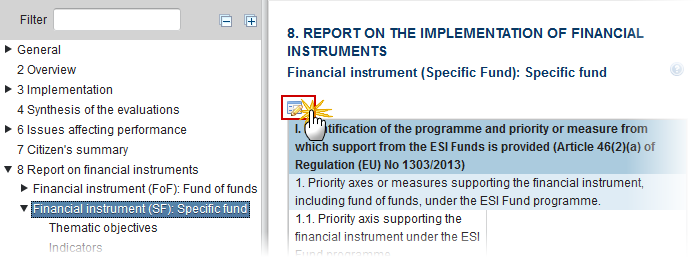
The table becomes editable:
PRE-AIR 2017
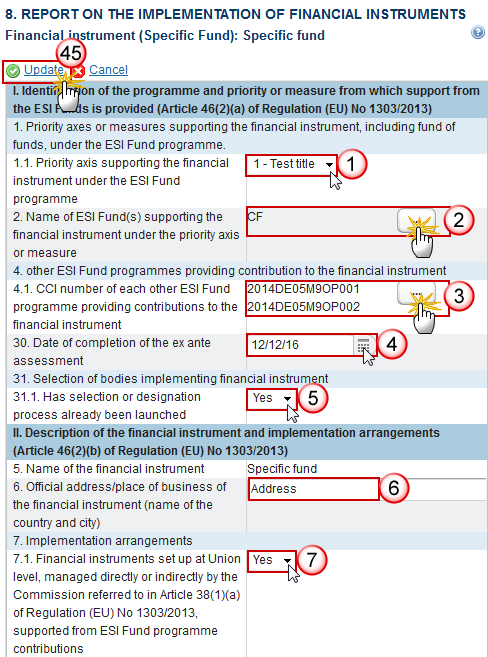



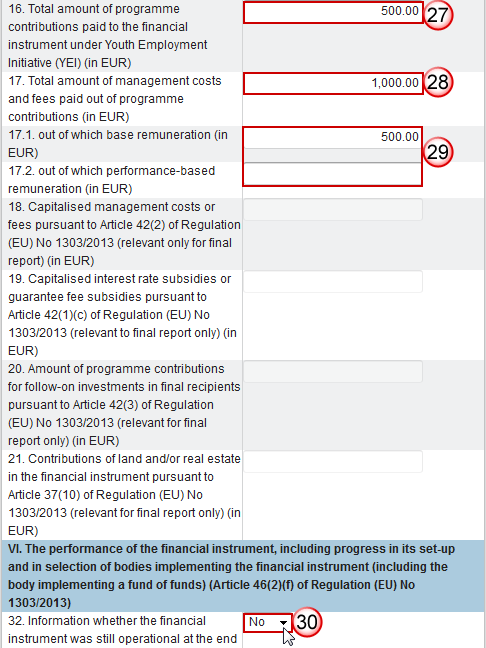

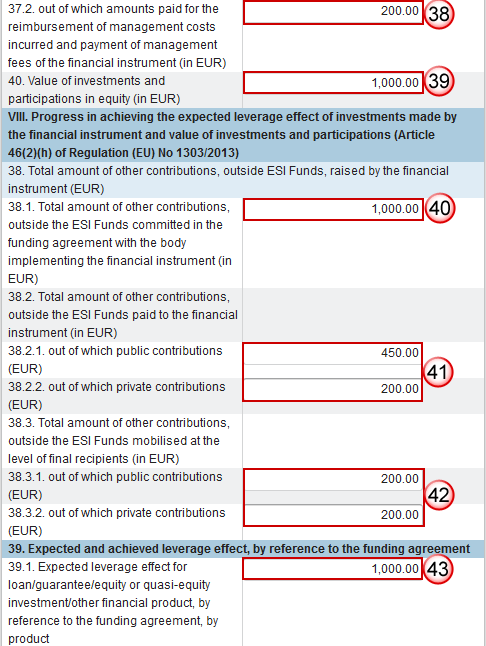

Enter the following information:
(1) Select the Priority Axis
The list of Priority Axes (1.1) contains all Priority Axes of the linked Programme Version.
(2) Select the name of ESI Fund supporting the financial instrument:

REMARK | The list of Funds (2) contains all Funds of the selected Priority Axis. When the Priority Axis is mono-Fund, this Fund will be selected by default. |
(3) Select the CCI number of each other ESI Fund:

REMARK | The list of Other ESI Fund Programmes (4.1) contains all IGJ, EMFF and EAFRD Programmes of the same Member State as the linked Programme. |
(4) Select the date of completion of the ex-ante assessment.
(5) Select yes or no if the selection or designation process has been launched.
(6) Enter the address of business of the financial instrument.
(7) Select yes or no if the financial instruments set up at Union level, is managed directly or indirectly by the Commission.
(8) Enter the Name of the Union-level financial instrument.
The Name of the Union-level financial instrument (7.1.1) is only to be enabled when 7.1 is true.
(9) Select the financial instrument set up at national, regional, transnational or cross-border level, managed by or under the responsibility of the managing authority.
(10) Select the tailor-made or financial instruments.
(11) Enter the off-the-shelf instrument type.
(12) Select the type of products provided by financial instrument: loans, micro-loans, guarantees, equity, or quasi-equity investments, other financial product or other support.
(13) Enter the description of the other financial product.
(14) Enter the other support combined within the financial instrument.
(15) Select the legal status.
(16) Select the type of implementing body.
(17) Enter the name of the body.
(18) Enter the official address of the body.
(19) Select the procedure of selecting the body.
(20) Enter the description of the other procedure of selecting the body.
(21) Select the date of signature of the funding agreement with the body.
(22) Enter the total amount of programme contributions committed in the funding agreement.
(23) Enter the amount of programme contributions committed in the funding agreement out of which ESI Funds contributions (in EUR).
(24) Enter the amount of programme contributions committed in the funding agreement out of which ERDF (optional), Cohesion Fund (optional), ESF Fund (optional), EAFRD (optional), EMFF (optional).
(25) Enter the amount of programme contributions paid to the financial instrument out of which ERDF, Cohesion Fund, ESF, EAFRD, EMFF (in EUR).
(26) Enter the amount of programme contributions paid to the financial instrument out of which total amount of national public funding and private funding.
(27) Enter the total amount of programme contributions paid to the financial instrument under YEI.
(28) Enter the total amount of management costs and fees paid out of programme contributions.
(29) Enter the amount out of which base remuneration and performance-based remuneration.
(30) Select yes or no for the information whether the financial instrument was still operational at the end of the reporting year
(31) Select the date of the winding-up.
(32) Enter the total number of disbursed loans defaulted or total number of guarantees provided.
(33) Enter the total amount of disbursed loans defaulted (in EUR) or total amount committed for guarantees provided.
(34) Enter the interest and other gains generated by payments from ESI Funds.
(35) Enter the amount repaid to the financial instrument attributable to support from ESI Funds out of which capital repayments and out of which gains, other earnings and yields.
(36) Enter the amounts of resources reused which were paid back to the financial instrument and are attributable to ESI Funds.
(37) Enter the amounts of resources reused which were paid back to the financial instrument out of which amounts paid for preferential remuneration of private investors operating under the market economy principle.
(38) Enter the amounts of resources reused which were paid back to the financial instrument out of which amounts paid for the reimbursement of management costs incurred and payment of management fees.
(39) Enter the value of investments and participants in equity.
(40) Enter the total amount of other contributions, outside the ESI Funds committed in the funding agreement with the body.
(41) Enter the total amount of other contributions, outside the ESI Funds paid to the financial instrument out of which public and private contributions.
(42) Enter the total amount of other contributions, outside the ESI Funds mobilised at the level of final recipients out of which public and private contributions
(43) Enter the expected leverage effect for loan/guarantee/equity or quasi-equity investment/other financial product, by reference to the funding agreement
(44) Enter the investment mobilised through ESIF financial instruments for loan/guarantee/equity and quasi-equity investment (optional)
(45) Click on the Update link to save the information.
REMARK | The list of Priority Axes (1.1) contains all Priority Axes of the linked Programme Version. The Name of the Union-level financial instrument (7.1.1) is only to be enabled when 7.1 is true. The Off-the-shelf instrument type (8.1.1) is only to be enabled when 8.1 is true. The Description of the other financial product (9.1) is only to be enabled when 9.0.6 is true. The Description of the other financial product (9.2) is only to be enabled when 9.0.7 is true. The Description of the other procedure (12.1) is only to be enabled when the value of 12 = 'Others' (Internal code 5). Elements 18 to 21 are only to be enabled when Final Implementation Report. The Date of winding-up (32.1) is only to be enabled when 32 is false. |
2017 AIR Onwards
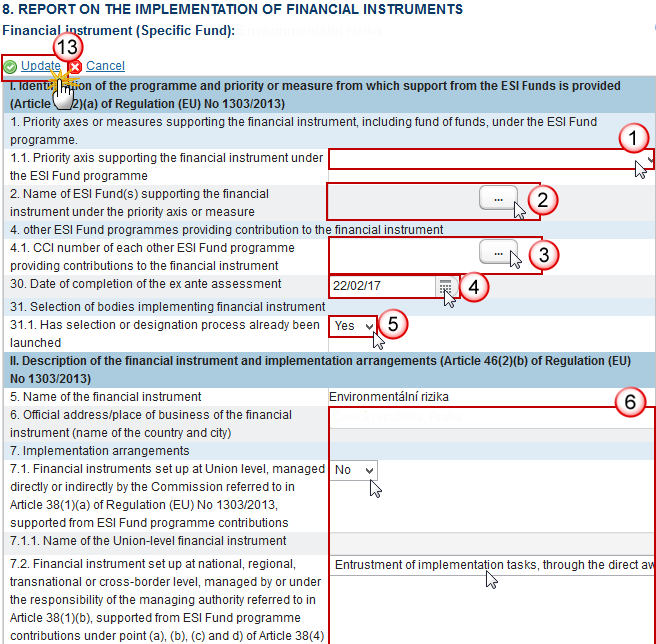
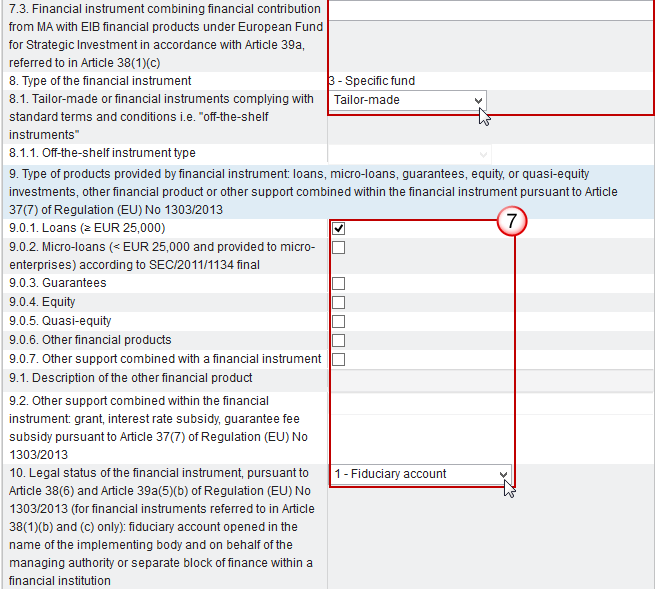

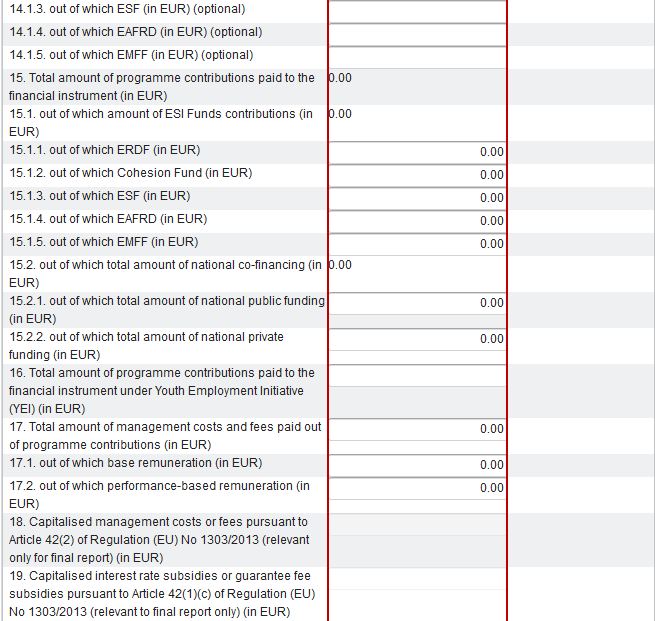

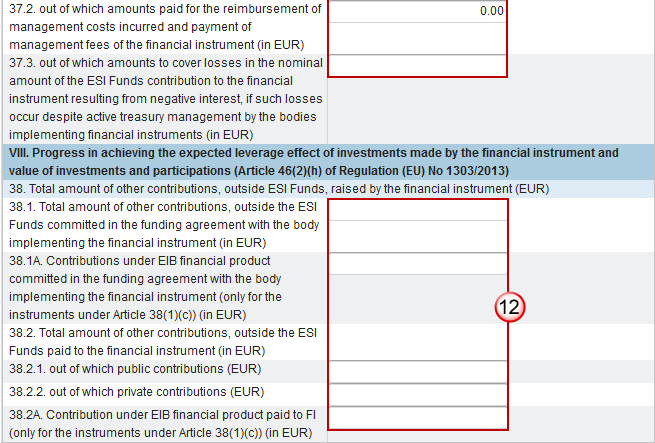
Enter the following information:
(1) Select the Priority Axis
The list of Priority Axes (1.1) contains all Priority Axes of the linked Programme Version.
(2) Select the name of ESI Fund supporting the financial instrument:

REMARK | The list of Funds (2) contains all Funds of the selected Priority Axis. When the Priority Axis is mono-Fund, this Fund will be selected by default. |
(3) Select the CCI number of each other ESI Fund:

REMARK | The list of Other ESI Fund Programmes (4.1) contains all IGJ, EMFF and EAFRD Programmes of the same Member State as the linked Programme. |
(4) Select the date of completion of the ex-ante assessment.
(5) Select yes or no if the selection or designation process has been launched.
(6) Enter the information for section II. Description of the financial instrument and implementation arrangements.
The Name of the Union-level financial instrument (7.1.1) is only to be enabled when 7.1 is true.
(7) Enter the type of products provided by financial instrument loans, micro-loans, guarantees, equity, or quasi-equity investments, other financial product or other support combined within the financial instrument.
(8) Enter the information for the section III. Identification of the body implementing the financial, and the body implementing fund of funds where applicable.
The Description of the other procedure (12.1) is only to be enabled when the value of 12 = 'Others' (code 5).
(9) Enter the information for section IV. Total amount of programmes contributions, by priority or measure, paid to the financial instrument and management costs incurred or management fees paid.
2017AIR onwards, element 21 is only to be enabled when Final Implementation Report.
(10) Enter the information for section VI. The performance of the financial instrument, including progress in its set-up an in selection of bodies implementing the financial instrument.
The Date of the winding-up (32.1) is only to be enabled when 32 is no.
(11) Enter the information for section VII. Interest and other gains generated by support from the ESI Funds to the financial instrument, programme resources paid back to financial instrument from investments.
(12) Enter the information for section VIII. Progress in achieving the expected leverage effect of investments made by the financial instrument and value of investments.
(12) Click on the Update link to save the information.
REMARK | The list of Priority Axes (1.1) contains all Priority Axes of the linked Programme Version. The Name of the Union-level financial instrument (7.1.1) is only to be enabled when 7.1 is true. The Off-the-shelf instrument type (8.1.1) is only to be enabled when 8.1 is true. The Description of the other financial product (9.1) is only to be enabled when 9.0.6 is true. The Description of the other financial product (9.2) is only to be enabled when 9.0.7 is true. The Description of the other procedure (12.1) is only to be enabled when the value of 12 = 'Others' (Internal code 5). Elements 18 to 21 are only to be enabled when Final Implementation Report. The Date of winding-up (32.1) is only to be enabled when 32 is false. The content for 38.2, 38.2.1, 38.2.2, 38.3.1 & 38.3.2 are optional in the years 2017 and 2019. New elements from AIR 2018 onwards: 7.3, 37.3, 38.1.A & 38.2A. |
Thematic objectives
Clicking on the Add button
 will open the thematic objectives table allowing you to enter the information.
will open the thematic objectives table allowing you to enter the information.
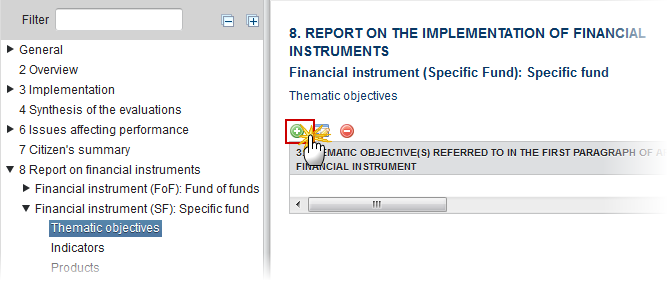
The Edit Details pop-up window appears:

Enter the following information:
(1) Select the Thematic objective
The list of Thematic Objectives (3) contains all Thematic Objectives covered by the selected Priority Axis.
(2) Enter the amount of ESI funds committed to this thematic objective
(3) Click on the Update link to save the information.
REMARK | The list of Thematic Objectives (3) contains all Thematic Objectives covered by the selected Priority Axis. |
Indicators
Clicking on the Add button
 will open the indicators table allowing you to enter the information.
will open the indicators table allowing you to enter the information.

The Edit Details pop-up window appears:

Enter the following information:
(1) Select the Output indicator.
(2) Enter the Target value of the output indicator (CO2).
(3) Enter the value achieved by the financial instrument in relation to the target value of the output indicator (CO2).
(4) Click on the Update link to save the information.
REMARK | The list of Output Indicators (41) contains all Common and Programme Specific Output Indicators used in the linked Programme version under the selected Priority Axis. |
Products
Clicking on the Add button
 will open the products table allowing you to enter the information.
will open the products table allowing you to enter the information.

The Edit Details pop-up window appears:

Enter the following information:
(1) Enter the Name of financial product
(2) Select the type of financial product offered

(3) Click on the Update link to save the information.
REMARK | The list of Financial Product Types (22.1) contains all the Financial Product Types relevant for the Financial Instrument Type. |
Equity
Clicking on the Edit button
 will open the financial instrument table allowing you to enter the information.
will open the financial instrument table allowing you to enter the information.
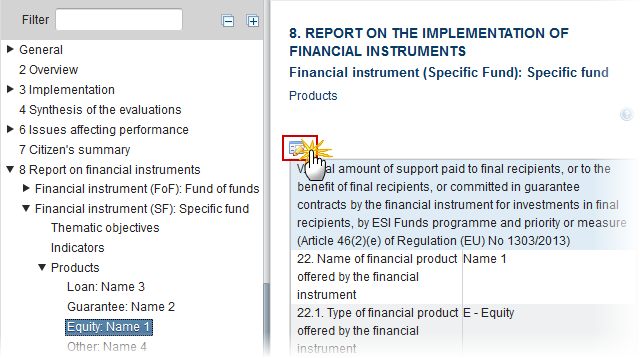
The table becomes editable:
PRE-AIR 2017


Enter the following information:
(1) Enter the Name of financial product.
(2) Enter the total amount of programme contributions committed in this equity.
(3) Enter the total amount of programme contributions committed in this equity out of which total amount of ESI Funds contributions.
(4) Enter the total amount of programme contributions paid to final recipients through this equity.
(5) Enter the total amount of programme contributions paid to final recipients through this equity paid to final recipients out of which ERDF, Cohesion Fund, ESF, EAFRD, EMFF (in EUR)
(6) Enter the amount of programme contributions paid to final recipients through this equity paid to final recipients out of which total amount of national public co-financing.
(7) Enter the amount of programme contributions paid to final recipients through this equity paid to final recipients out of which total amount of national private co-financing.
(8) Enter the number of loan/guarantee/equity financial product contracts signed with final recipients.
(9) Enter the number of loan/guarantee/equity financial product investments signed with final recipients.
(10) Enter the number of financial recipients supported by the financial product out of which large enterprises, out of which SMEs, out of which microenterprises, out of which individuals/natural persons, out of which other type of final recipients supported.
(11) Enter a description of other type of final recipients supported.
(12) Click on the Update link to save the information.
2017 AIR Onwards



Enter the following information:
(1) Enter the Name of financial product.
(2) Enter the total amount of programme contributions committed in this equity & out of which total amount of ESI Funds contributions.
(3) Enter the total amount of programme contributions paid to final recipients through this equity, out of which ERDF, Cohesion Fund, ESF, EAFRD, EMFF (in EUR)
(4) Enter the amount of programme contributions paid to final recipients through this equity paid to final recipients out of which total amount of national public & private co-financing.
(5) Enter the number of equity or quasi-equity contracts signed with final recipients.
(6) Enter the number of equity or quasi-equity investments made in final.
(7) Enter the number of financial recipients supported by the financial product out of which large enterprises, out of which SMEs, out of which microenterprises, out of which individuals/natural persons, out of which other type of final recipients supported.
(8) Enter the description of other type of final recipient.
(9) Enter the total amount of other contributions outside the ESI funds, out of which public & private contributions.
(10) Enter the expected leverage effect for equity or quasi-equity investment.
(11) Enter the investment mobilised through ESIF financial instruments for equity and quasi-equity investment.
(12) Click on the Update link to save the information.
REMARK | The Description of other type of financial recipients (29.4.1) is only to be enabled when the value of 29.4 > 0. New element from AIR 2018 onwards: 38.3A. |
Guarantee
Clicking on the Edit button
 will open the guarantee table allowing you to enter the information.
will open the guarantee table allowing you to enter the information.

The table becomes editable:
PRE-AIR 2017


Enter the following information:
(1) Enter the Name of financial product.
(2) Enter the total amount of programme contributions committed in this guarantee.
(3) Enter the total amount of programme contributions committed in this guarantee out of which total amount of ESI Funds contributions.
(4) Enter the total amount of programme contributions paid to final recipients through this guarantee.
(5) Enter the total amount of programme contributions paid to final recipients through this guarantee paid to final recipients out of which ERDF, Cohesion Fund, ESF, EAFRD, EMFF (in EUR)
(6) Enter the amount of programme contributions paid to final recipients through this guarantee paid to final recipients out of which total amount of national public co-financing.
(7) Enter the amount of programme contributions paid to final recipients through this guarantee paid to final recipients out of which total amount of national private co-financing.
(8) Enter the number of loan/guarantee/equity financial product contracts signed with final recipients.
(9) Enter the number of loan/guarantee/equity financial product investments signed with final recipients.
(10) Enter the number of financial recipients supported by the financial product out of which large enterprises, out of which SMEs, out of which microenterprises, out of which individuals/natural persons, out of which other type of final recipients supported.
(11) Enter a description of other type of final recipients supported.
(12) Click on the Update link to save the information.
REMARK | The Total value of new debt finance (26.1) is only to be enabled when the value of 7.1 in the master Fund of Funds is true. The Description of other type of financial recipients (29.4.1) is only to be enabled when the value of 29.4 > 0. |
2017 AIR Onwards


Enter the following information:
(1) Enter the Name of financial product.
(2) Enter the total amount of programme contributions committed in this guarantee and out of which total amount of ESI Funds contributions.
(3) Enter the total amount of programme contributions in the case of guarantee, committed for loans paid to final recipients.
(4) Enter the total amount of programme contributions paid to final recipients through this equity paid to final recipients out of which ERDF, Cohesion Fund, ESF, EAFRD, EMFF (in EUR)
(5) Enter the amount of programme contributions paid to final recipients through this guarantee paid to final recipients out of which total amount of national public co-financing & private co-financing.
(6) Enter the total number number of loans paid to final recipients in relation to the guarantee contracts signed.
(7) Enter the total value of new debt finance created by the SME initiative.
(8) Enter the number of loans signed with final recipients.
(9) Enter the number of loans paid to final recipients.
(10) Enter the number of financial recipients supported by the financial product out of which large enterprises, out of which SMEs, out of which microenterprises, out of which individuals/natural persons, out of which other type of final recipients supported.
(11) Enter a description of other type of final recipients supported.
(12) Enter the total number provided and called due to the loan default.
(13) Enter the total amount committed for guarantees provided and called due to loan default.
(14) Enter the expected leverage effect.
(15) Enter the investment mobilised through ESIF financial instruments.
(16) Click on the Update link to save the information.
REMARK | The Total value of new debt finance (26.1) is only to be enabled when the value of 7.1 in the master Fund of Funds is true. The Description of other type of financial recipients (29.4.1) is only to be enabled when the value of 29.4 > 0. Elements 33, 34, 38, 38.3.1, 38.3.2, 39, 39.1, 39.2, 39.3 and 40 will not occur anymore under the Financial Instrument but under the Product(s). |
Loan
Clicking on the Edit button
 will open the loan table allowing you to add the information.
will open the loan table allowing you to add the information.

The table becomes editable:
PRE-AIR 2017


Enter the following information:
(1) Enter the Name of financial product.
(2) Enter the total amount of programme contributions committed in this loan.
(3) Enter the total amount of programme contributions committed in this loan out of which total amount of ESI Funds contributions.
(4) Enter the total amount of programme contributions paid to final recipients through this loan.
(5) Enter the total amount of programme contributions paid to final recipients through this loan paid to final recipients out of which ERDF, Cohesion Fund, ESF, EAFRD, EMFF (in EUR)
(6) Enter the amount of programme contributions paid to final recipients through this loan paid to final recipients out of which total amount of national public co-financing.
(7) Enter the amount of programme contributions paid to final recipients through this loan paid to final recipients out of which total amount of national private co-financing.
(8) Enter the number of loan/guarantee/equity financial product contracts signed with final recipients.
(9) Enter the number of loan/guarantee/equity financial product investments signed with final recipients.
(10) Enter the number of financial recipients supported by the financial product out of which large enterprises, out of which SMEs, out of which microenterprises, out of which individuals/natural persons, out of which other type of final recipients supported.
(11) Enter a description of other type of final recipients supported.
(12) Click on the Update link to save the information.
REMARK | The Description of other type of financial recipients (29.4.1) is only to be enabled when the value of 29.4 > 0. |
2017 AIR Onwards


Enter the following information:
(1) Enter the Name of financial product.
(2) Enter the total amount of programme contributions committed in this loan.
(3) Enter the total amount of programme contributions committed in this loan out of which total amount of ESI Funds contributions.
(4) Enter the total amount of programme contributions paid to final recipients through this loan.
(5) Enter the total amount of programme contributions paid to final recipients through this loan paid to final recipients out of which ERDF, Cohesion Fund, ESF, EAFRD, EMFF (in EUR)
(6) Enter the amount of programme contributions paid to final recipients through this loan paid to final recipients out of which total amount of national public & private co-financing.
(7) Enter the number of loan contracts signed with final recipients.
(8) Enter number of loan investments made in final recipients.
(9) Enter the number of financial recipients supported by the financial product out of which large enterprises, out of which SMEs, out of which microenterprises, out of which individuals/natural persons, out of which other type of final recipients supported.
(10) Enter a description of other type of final recipients supported.
(11) Enter the total number of disbursed loans defaulted.
(12) Enter the total amount of disbursed loans.
(13) Out of which public & private contributions.
(14) Enter the expected leverage effect for loan.
(15) Enter the investment mobilised through ESIF for loan.
(16) Click on the Update link to save the information.
REMARK | The Description of other type of financial recipients (29.4.1) is only to be enabled when the value of 29.4 > 0. New element from AIR 2018 onwards: 38.3A. |
Other
Clicking on the Edit button
 will open the other table allowing you to add the information.
will open the other table allowing you to add the information.
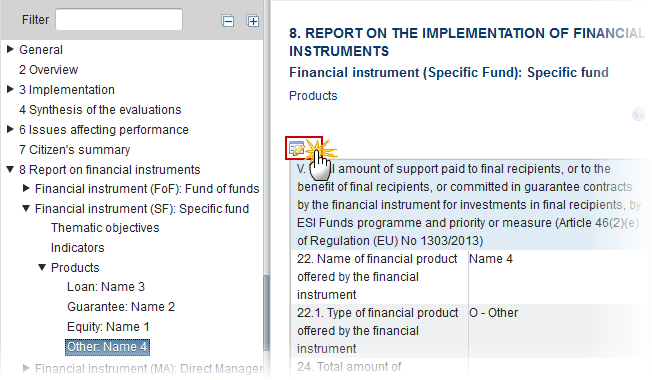
The table becomes editable:
PRE-AIR 2017


Enter the following information:
(1) Enter the Name of financial product.
(2) Enter the total amount of programme contributions committed in this other.
(3) Enter the total amount of programme contributions committed in this other out of which total amount of ESI Funds contributions.
(4) Enter the total amount of programme contributions paid to final recipients through this other.
(5) Enter the total amount of programme contributions paid to final recipients through this other paid to final recipients out of which ERDF, Cohesion Fund, ESF, EAFRD, EMFF (in EUR)
(6) Enter the amount of programme contributions paid to final recipients through this other paid to final recipients out of which total amount of national public co-financing.
(7) Enter the amount of programme contributions paid to final recipients through this other paid to final recipients out of which total amount of national private co-financing.
(8) Enter the number of loan/guarantee/equity financial product contracts signed with final recipients.
(9) Enter the number of loan/guarantee/equity financial product investments signed with final recipients.
(10) Enter the number of financial recipients supported by the financial product out of which large enterprises, out of which SMEs, out of which microenterprises, out of which individuals/natural persons, out of which other type of final recipients supported.
(11) Enter a description of other type of final recipients supported.
(12) Click on the Update link to save the information.
2017 AIR Onwards

Enter the following information:
(1) Enter the Name of financial product.
(2) Enter the total amount of programme contributions paid for the benefit.
(3) Enter the amount for the contributions paid for the benefit out of which total amount of ESI Funds out of which ERDF, CF, ESF, EAFRD & EMFF (in EUR).
(4) Enter the amount for the contributions paid for the benefit out of which total amount of ESI Funds out of which total amount of national public & private co-financing (in EUR)
(5) Enter the number of financial recipients out of which large enterprises, SMEs, microenterprises, individual/natural persons, other type of final recipients.
(6) Enter the description of other type of final recipients.
(7) Click on the Update link to save the information.
Financial Instrument (MA): Direct Management
Financial instrument (Direct management): Direct Management
Clicking on the Edit button
 will open the direct management table allowing you to enter the information.
will open the direct management table allowing you to enter the information.

The table becomes editable:
PRE-AIR 2017

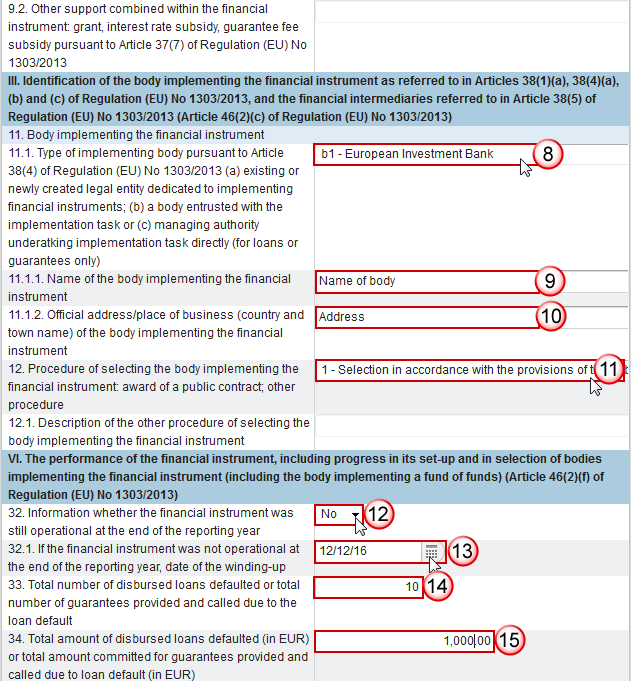

Enter the following information:
(1) Select the Priority Axis
The list of Priority Axes (1.1) contains all Priority Axes of the linked Programme Version.
(2) Select the name of ESI Fund(s) supporting the financial instrument:

REMARK | The list of Funds (2) contains all Funds of the selected Priority Axis. When the Priority Axis is mono-Fund, this Fund will be selected by default. |
(3) Select the CCI number of each other ESI Fund providing contributions:

REMARK | The list of Other ESI Fund Programmes (4.1) contains all IGJ, EMFF and EAFRD Programmes of the same Member State as the linked Programme. |
(4) Select the date of completion of the ex-ante assessment.
(5) Enter the address of business of the financial instrument.
(6) Select the financial instrument set up at national, regional, transnational or cross-border level, managed by or under the responsibility of the managing authority.
(7) Select the type of products provided by financial instrument: loans, micro-loans, guarantees, equity, or quasi-equity investments, other financial product or other support combined within the financial instrument.
(8) Select the type of implementing body.
(9) Enter the name of the body.
(10) Enter the address of business of the body.
(11) Select the procedure of selecting the body implementing the financial instrument.
(12) Select yes or no whether the financial instrument was still operational at the end of the reporting year.
(13) Select the date of the winding-up.
(14) Enter the total number of disbursed loans defaulted or total number of guarantees provided and called due to the loan default.
(15) Enter the total number of disbursed loans defaulted or total committed for guarantees provided.
(16) Enter the amounts repaid to the financial instrument attributable to support from ESI Funds by the end of the reporting year out of which capital repayments and out of which gains, other earnings and yields.
(17) Enter the amounts of resources reused which were paid back to the financial instrument and are attributable to ESI Funds.
(18) Enter the total amount of other contributions, outside the ESI Funds mobilised at the level of final recipients out of which public contributions and out of which private contributions.
(19) Enter the expected leverage effect for loan/guarantee/equity or quasi-equity investment/other financial product.
(20) Enter the investment mobilised through ESIF financial instruments for loan/guarantee/equity and quasi-equity investment.
(21) Click on the Update link to save the information.
REMARK | The list of Priority Axes (1.1) contains all Priority Axes of the linked Programme Version. The Description of the other financial product (9.2) is only to be enabled when 9.0.7 is true. The Description of the other procedure (12.1) is only to be enabled when the value of 12 = 'Others' (Internal code 5). The Date of winding-up (32.1) is only to be enabled when 32 is false. |
2017 AIR Onwards
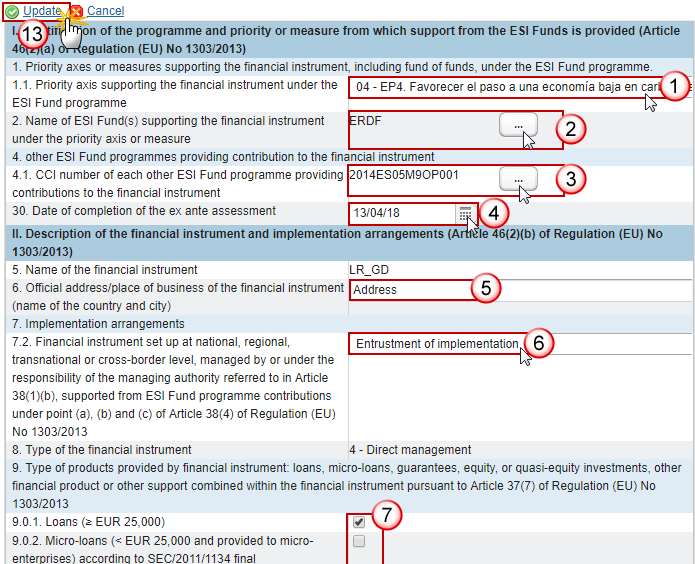


Enter the following information:
(1) Enter the Priority Axis.
(2) Select the fund.
(3) Select the CCI number.
(4) Select the date of completion of the ex-ante assessment.
(5) Enter the address.
(6) Select the Financial instrument.
(7) Select the type of products provided by financial instrument: loans, micro-loans, guarantees, equity, or quasi-equity investments, other financial product or other support.
(8) Enter the Other support.
(9) Select the type of implementing body and enter the name of the body and the official address.
(10) Select yes or no the information whether the financial instrument was still operational at the end of the reporting year. If no, select the date of the winding-up.
(11) Enter the amounts repaid out of which capital repayments and out of which gains, other earnings and yields.
(12) Enter the amounts of resources reused which were paid back to the financial instrument.
(13) Click on the Update link to save the information.
REMARK | The list of Priority Axes (1.1) contains all Priority Axes of the linked Programme Version. The Description of the other financial product (9.2) is only to be enabled when 9.0.7 is true. The Date of winding-up (32.1) is only to be enabled when 32 is false. The content for 38.2, 38.2.1, 38.2.2, 38.3.1 & 38.3.2 are optional in the years 2017 and 2019. |
Thematic objectives
Clicking on the Add button
 will open the thematic objectives table allowing you to enter the information.
will open the thematic objectives table allowing you to enter the information.
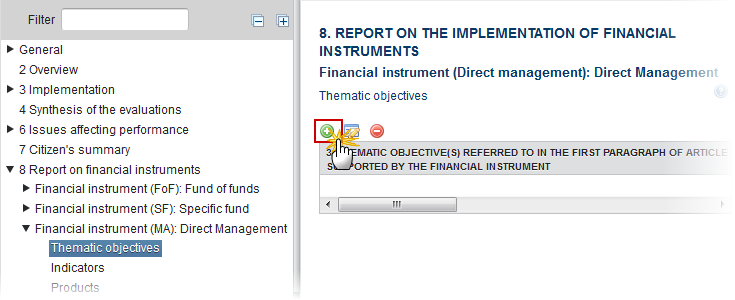
The Edit Details pop-up window appears:

Enter the following information:
(1) Select the Thematic objective
The list of Thematic Objectives (3) contains all Thematic Objectives covered by the selected Priority Axis.
(2) Enter the amount of ESI funds committed to this thematic objective
(3) Click on the Update link to save the information.
REMARK | The list of Thematic Objectives (3) contains all Thematic Objectives covered by the selected Priority Axis. |
Indicators
Clicking on the Add button
 will open the indicators table allowing you to enter the information.
will open the indicators table allowing you to enter the information.
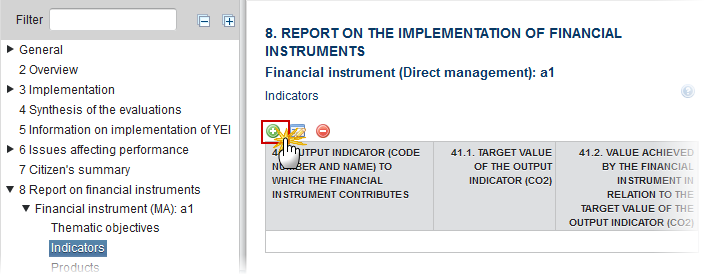
The Edit Details pop-up window appears:

Enter the following information:
(1) Select the Output indicator.
(2) Enter the Target value of the output indicator (CO2).
(3) Enter the value achieved by the financial instrument in relation to the target value of the output indicator (CO2).
(4) Click on the Update link to save the information.
REMARK | The list of Output Indicators (41) contains all Common and Programme Specific Output Indicators used in the linked Programme version under the selected Priority Axis. |
Products
Clicking on the Add button
 will open the Products table allowing you to enter the information.
will open the Products table allowing you to enter the information.
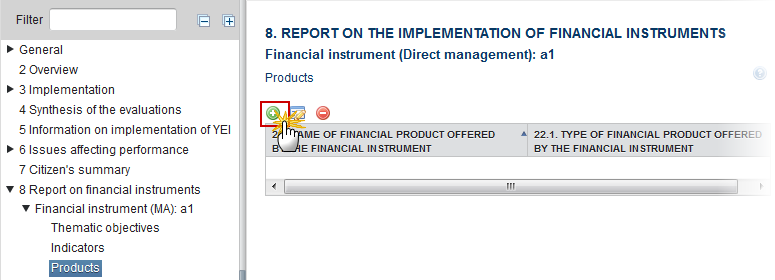
The Edit Details pop-up window appears:

Enter the following information:
(1) Enter the Name of financial product
(2) Select the type of financial product offered
(3) Click on the Update link to save the information.
REMARK | The list of Financial Product Types (22.1) contains all the Financial Product Types relevant for the Financial Instrument Type. |
Loan
Clicking on the Edit button
 will open the loan table allowing you to add the information.
will open the loan table allowing you to add the information.
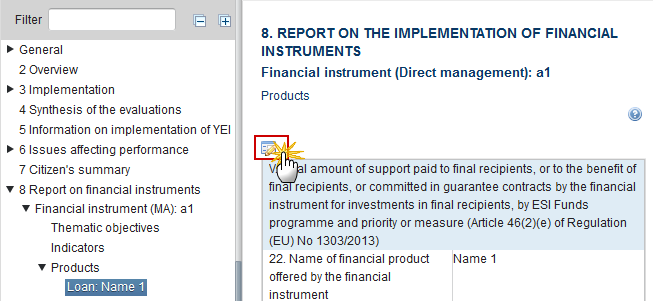
The table becomes editable:
PRE-AIR 2017


Enter the following information:
(1) Enter the Name of financial product.
(2) Enter the total amount of programme contributions committed in this loan.
(3) Enter the total amount of programme contributions committed in this loan out of which total amount of ESI Funds contributions.
(4) Enter the total amount of programme contributions paid to final recipients through this loan.
(5) Enter the total amount of programme contributions paid to final recipients through this loan paid to final recipients out of which ERDF, Cohesion Fund, ESF, EAFRD, EMFF (in EUR)
(6) Enter the amount of programme contributions paid to final recipients through this loan paid to final recipients out of which total amount of national public co-financing.
(7) Enter the amount of programme contributions paid to final recipients through this loan paid to final recipients out of which total amount of national private co-financing.
(8) Enter the number of loan/guarantee/equity financial product contracts signed with final recipients.
(9) Enter the number of loan/guarantee/equity financial product investments signed with final recipients.
(10) Enter the number of financial recipients supported by the financial product out of which large enterprises, out of which SMEs, out of which microenterprises, out of which individuals/natural persons, out of which other type of final recipients supported.
(11) Enter a description of other type of final recipients supported.
(12) Click on the Update link to save the information.
REMARK | The Description of other type of financial recipients (29.4.1) is only to be enabled when the value of 29.4 > 0. |
2017 AIR Onwards


Enter the following information:
(1) Enter the Name of financial product.
(2) Enter the total amount of programme contributions committed in this loan.
(3) Enter the total amount of programme contributions committed in this loan out of which total amount of ESI Funds contributions.
(4) Enter the total amount of programme contributions paid to final recipients through this loan.
(5) Enter the total amount of programme contributions paid to final recipients through this loan paid to final recipients out of which ERDF, Cohesion Fund, ESF, EAFRD, EMFF (in EUR)
(6) Enter the amount of programme contributions paid to final recipients through this loan paid to final recipients out of which total amount of national public & private co-financing.
(7) Enter the number of loan contracts signed with final recipients.
(8) Enter number of loan investments made in final recipients.
(9) Enter the number of financial recipients supported by the financial product out of which large enterprises, out of which SMEs, out of which microenterprises, out of which individuals/natural persons, out of which other type of final recipients supported.
(10) Enter a description of other type of final recipients supported.
(11) Enter the total number of disbursed loans defaulted.
(12) Enter the total amount of disbursed loans.
(13) Out of which public & private contributions.
(14) Enter the expected leverage effect for loan.
(15) Enter the investment mobilised through ESIF for loan.
(16) Click on the Update link to save the information.
REMARK | The Description of other type of financial recipients (29.4.1) is only to be enabled when the value of 29.4 > 0. |
Guarantee
Clicking on the Edit button
 will open the guarantee table allowing you to enter the information.
will open the guarantee table allowing you to enter the information.

The table becomes editable:
PRE-AIR 2017


Enter the following information:
(1) Enter the Name of financial product.
(2) Enter the total amount of programme contributions committed in this guarantee.
(3) Enter the amount out of which total amount of ESI Funds contributions.
(4) Enter the total amount of programme contributions paid to final recipients through this guarantee.
(5) Enter the total amount of programme contributions paid to final recipients through this guarantee paid to final recipients out of which ERDF, Cohesion Fund, ESF, EAFRD, EMFF (in EUR)
(6) Enter the amount of programme contributions paid to final recipients through this guarantee paid to final recipients out of which total amount of national public co-financing.
(7) Enter the amount of programme contributions paid to final recipients through this guarantee paid to final recipients out of which total amount of national private co-financing.
(8) Enter the number of loan/guarantee/equity financial product contracts signed with final recipients.
(9) Enter the number of loan/guarantee/equity financial product investments signed with final recipients.
(10) Enter the number of financial recipients supported by the financial product out of which large enterprises, out of which SMEs, out of which microenterprises, out of which individuals/natural persons, out of which other type of final recipients supported.
(11) Enter a description of other type of final recipients supported.
(12) Click on the Update link to save the information.
REMARK | The Total value of new debt finance (26.1) is only to be enabled when the value of 7.1 in the master Fund of Funds is true. The Description of other type of financial recipients (29.4.1) is only to be enabled when the value of 29.4 > 0. |
2017 AIR Onwards


Enter the following information:
(1) Enter the Name of financial product.
(2) Enter the total amount of programme contributions committed in this guarantee and out of which total amount of ESI Funds contributions.
(3) Enter the total amount of programme contributions in the case of guarantee, committed for loans paid to final recipients.
(4) Enter the total amount of programme contributions paid to final recipients through this equity paid to final recipients out of which ERDF, Cohesion Fund, ESF, EAFRD, EMFF (in EUR)
(5) Enter the amount of programme contributions paid to final recipients through this guarantee paid to final recipients out of which total amount of national public co-financing & private co-financing.
(6) Enter the total number number of loans paid to final recipients in relation to the guarantee contracts signed.
(7) Enter the total value of new debt finance created by the SME initiative.
(8) Enter the number of loans signed with final recipients.
(9) Enter the number of loans paid to final recipients.
(10) Enter the number of financial recipients supported by the financial product out of which large enterprises, out of which SMEs, out of which microenterprises, out of which individuals/natural persons, out of which other type of final recipients supported.
(11) Enter a description of other type of final recipients supported.
(12) Enter the total number provided and called due to the loan default.
(13) Enter the total amount committed for guarantees provided and called due to loan default.
(14) Enter the expected leverage effect.
(15) Enter the investment mobilised through ESIF financial instruments.
(16) Click on the Update link to save the information.
REMARK | The Total value of new debt finance (26.1) is only to be enabled when the value of 7.1 in the master Fund of Funds is true. The Description of other type of financial recipients (29.4.1) is only to be enabled when the value of 29.4 > 0. Elements 33, 34, 38, 38.3.1, 38.3.2, 39, 39.1, 39.2, 39.3 and 40 will not occur anymore under the Financial Instrument but under the Product(s). |
9-13. Actions taken to Fulfill EACs (only Pre-AIR 2017)
REMARK | From AIR 2017 reporting on the Ex-ante conditionalities is NOT required anymore. Thus this section is only for pre-AIR 2017. On create/create new version it should not be copied from the previous version anymore. In the Print, it will stay but it will be empty anyway. |
Table 14
Table 14 - Unfulfilled Criteria of General Ex-ante Conditionalities (only pre-AIR 2017)
Note | From AIR 2017 reporting on the Ex-ante conditionalities is NOT required anymore. |
Select a row and click on the Edit button
 to add all the unfulfilled Criteria.
to add all the unfulfilled Criteria.

The Edit Details pop-up window appears:

Enter or select the following information:
(1) Select Fulfilled (yes or no) criteria
(2) Select the Expected date for full implementation of remaining actions
(3) Click on the Update link to save the information.
Note | All unfulfilled Criteria records from the linked Programme version will be automatically created at creation time. |
Table 14
Table 14 – Actions taken to fulfil general EACs (only Pre-AIR 2017)
Note | From AIR 2017 reporting on the Ex-ante conditionalities is NOT required anymore. |
Select a row and click on the Edit button
 to add all the Actions taken to fulfil the applicable general Ex-ante Conditionalities.
to add all the Actions taken to fulfil the applicable general Ex-ante Conditionalities.

The Edit Details pop-up window appears:
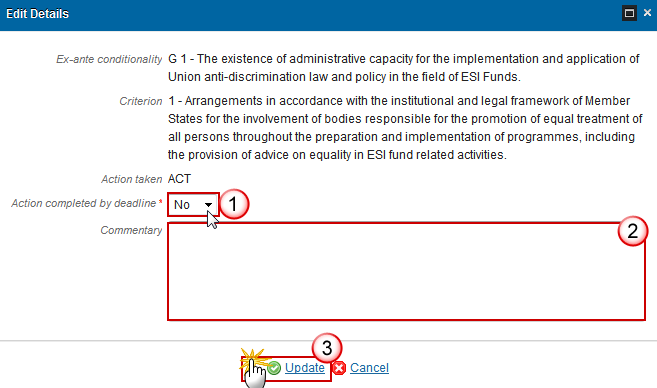
Enter or select the following information:
(1) Select if the Action is completed by deadline (yes or no)
(2) Enter a Commentary (no mandatory)
(3) Click on the Update link to save the information.
Note | All Actions records from Unfulfilled Criteria from the linked Programme version will be automatically created at creation time. |
Table 15
Table 15 – Unfulfilled Criteria of Thematic EACS (only pre-AIR 2017)
Note | From AIR 2017 reporting on the Ex-ante conditionalities is NOT required anymore. |
Select a row and click on the Edit button
 to add the Unfulfilled Criteria of Thematic Ex-ante Conditionalities.
to add the Unfulfilled Criteria of Thematic Ex-ante Conditionalities.

The Edit Details pop-up window appears:

Enter or select the following information:
(1) Select if the Criteria is Fulfilled (yes or no)
(2) Select an Expected date for full implementation of remaining actions (no mandatory)
(3) Click on the Update link to save the information.
Note | All Actions records from Unfulfilled Criteria from the linked Programme version will be automatically created at creation time. |
Table 15
Table 15 – Actions taken to Fulfill Thematic EACS (only Pre-AIR 2017)
Note | From AIR 2017 reporting on the Ex-ante conditionalities is NOT required anymore. |
Select a row and click on the Edit button
 to add the Actions taken to fulfill the thematic Ex-ante Conditionalities.
to add the Actions taken to fulfill the thematic Ex-ante Conditionalities.

The Edit Details pop-up window appears:
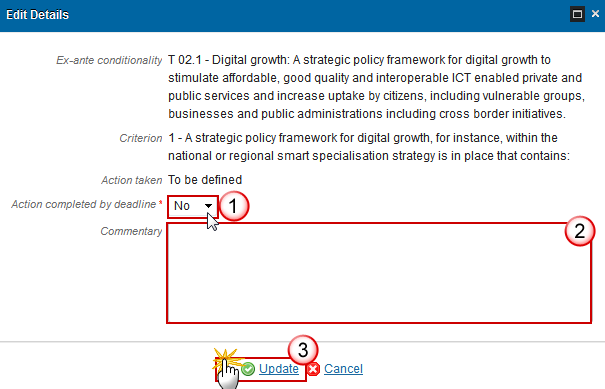
Enter or select the following information:
(1) Select if the Action is completed by deadline (yes or no)
(2) Enter a Commentary (no mandatory)
(3) Click on the Update link to save the information.
Note | All Actions records from Unfulfilled Criteria from the linked Programme version will be automatically created at creation time. From AIR 2017 reporting on the Ex-ante conditionalities is NOT required anymore. |
10. Progress of Major Projects & Joint Action Plans
Progress in preparation and implementation of Major Projects and joint action plans.
10.1 Major Projects
Table 12
Table 12 Major Projects
Note | It is a must that Table 12 contains all Major Projects (based on CCI) linked to this Programme. Some fields are mandatory depending of the Status of MP:
|
Select a row and click on the Edit button
 to add the Progress in preparation of Major Projects.
to add the Progress in preparation of Major Projects.
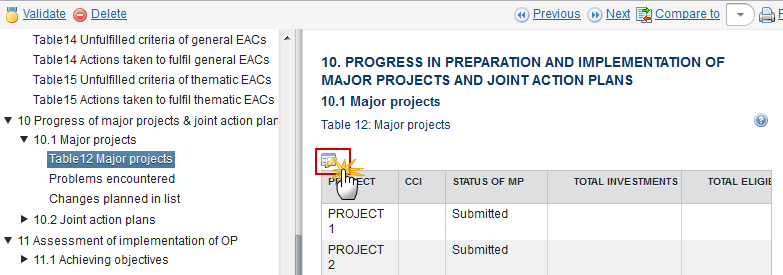
The Edit Details pop-up window appears:
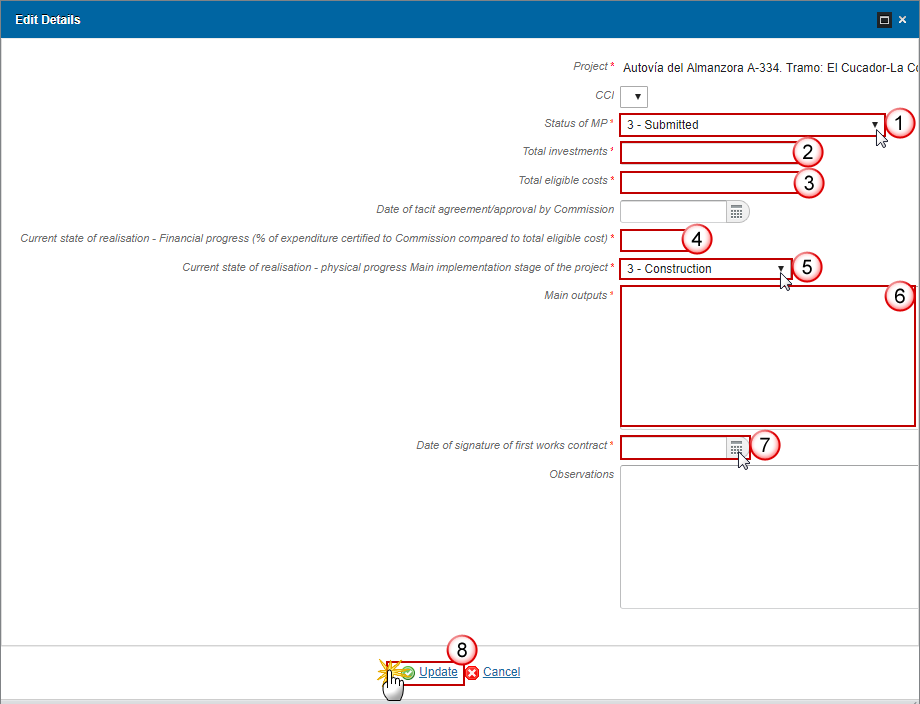
Enter or select the following information:
(1) Select the Status of MP (completed, approved, submitted, planned for notification/submission to EC, withdrawn and kept as a non-major project in the OP & withdrawn and taken out of the OP).
(2) Enter the Total investments
(3) Enter the Total eligible costs
(4) Enter the Current rate of realisation – physical progress Main implementation stage of the project
(5) Select the Current rate of realisation – physical progress Main implementation stage of the project (completed, advanced, construction, procurement and design)
(6) Enter the Main outputs
(7) Select the date of signature of first works contract (not mandatory when 4 – Planned for notification).
(8) Click on the Update link to save the information.
Note | All Major Project records from the linked Programme version will be automatically created at creation time. Unfortunately, these do not contain a CCI number and even now it is not yet certain that all Major Project CCI numbers are allocated. The list of CCIs contains all allocated Major Project CCIs for the same country as the Programme. Date of signature of first works contract becomes mandatory. |
Problems encountered
Significant problems encountered in implementing major projects and measures taken to overcome them
Clicking on the Edit button
 will open a pop up window allowing you to add a description text for the Problems encountered implementing major projects and measures taken to overcome them.
will open a pop up window allowing you to add a description text for the Problems encountered implementing major projects and measures taken to overcome them.

The Edit Details pop-up window appears:

Enter the following information:
(1) Enter a description text.
(2) Click on the Update link to save the information.
Changes Planned in list
Any change planned in the list of major projects in the operational programme
Clicking on the Edit button
 will open a pop up window allowing you to add a description text for any change planned in the list of major projects in the Operational Programme.
will open a pop up window allowing you to add a description text for any change planned in the list of major projects in the Operational Programme.

The Edit Details pop-up window appears:

Enter the following information:
(1) Enter a description text.
(2) Click on the Update link to save the information.
10.2 Joint Action Plans
Progress
Progress in the implementation of different stages of joint action plans
Clicking on the Edit button
 will open a pop up window allowing you to add a description text for the Progress in the Implementation of different stages of joint action plans.
will open a pop up window allowing you to add a description text for the Progress in the Implementation of different stages of joint action plans.

The Edit Details pop-up window appears:

Enter the following information:
(1) Enter a description text.
(2) Click on the Update link to save the information.
Table 13
Table 13 Joint Action Plans (JAP)
Click on the Add button
 to add the information on this table.
to add the information on this table.Select a row and click on the Delete button in the corresponding table
 to remove the selected information.
to remove the selected information.Select a row and click on the Edit button in the corresponding table
 to modify the information of this row.
to modify the information of this row.
Click on the Add button
 to add the joint action plans (JAP)
to add the joint action plans (JAP)

The Edit Details screen of Table 13 becomes editable:
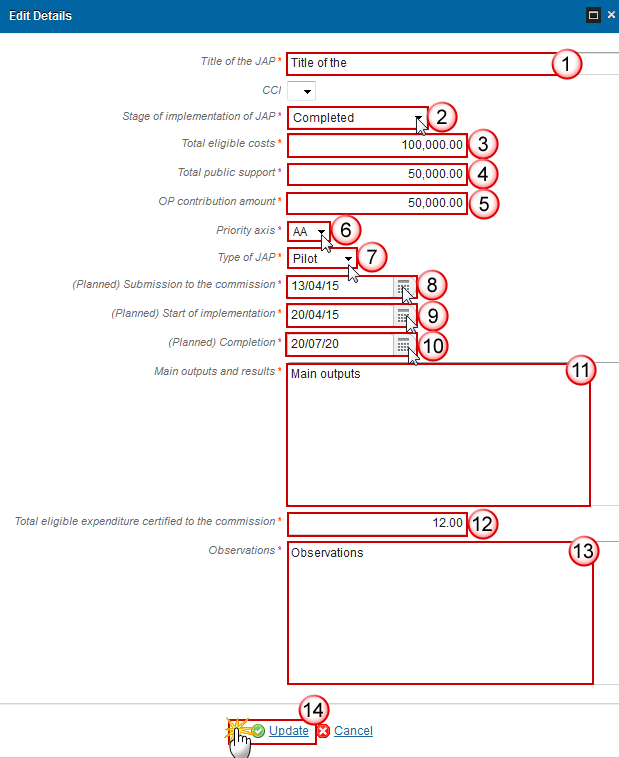
Enter the following information:
(1) Enter the Title of the JAP
(2) Select the Stage of implementation of JAP
(3) Enter the Total Eligible costs
(4) Enter the Total Public Support
(5) Enter the OP Contribution amount
(6) Select the Priority Axis
(7) Select the Type of JAP
(8) Select the Planned Submission to the Commission
(9) Select the Planned Start of Implementation
(10) Select the Planned Completion
(11) Enter the Main outputs and results
(12) Enter the Total eligible expenditure certified to the Commission
(13) Enter the Observations
(14) Click on the Update link to save the information.
Note | There are no JAPs in the Programme, so they will have to be inserted manually. It is possible that not all JAPs have already a CCI number allocated. The list of Priority Axes contains all Priority Axes from the linked Programme version. |
Problems encountered & Measures taken
Significant problems encountered and measures taken to overcome them.
Clicking on the Edit button
 will open a pop up window allowing you to add a description text for the significant problems encountered and the measures taken to overcome them.
will open a pop up window allowing you to add a description text for the significant problems encountered and the measures taken to overcome them.

The Edit Details pop-up window appears:

Enter the following information:
(1) Enter a description text.
(2) Click on the Update link to save the information.
11. Assessment of Implementation of OP
Assessment of the implementation of the Operational Programme.
Note | In AIRs 2017, 2019, 2020, 2021 and 2022 the following sections and their sub-sections are not be editable, and therefore not displayed (both in web, web service and will be empty in print): 11, 12, 14.1, 14.2, 14.3, 14.5, 14.6, 15, 16, 17, 18 |
11.1 Achieving Objectives
Information in part A and achieving objectives of the programme. Assessment of the information provided above and progress towards achieving the objectives of the programme, including the contribution of the European Structural and Investment Funds to changes in the value of result indicators, when evidence is available from evaluations.
Priority Axis: n
Assessment of the information provided above and progress towards achieving the objectives of the programme, including the contribution of the European Structural and Investment Funds to changes in the value of result indicators, when evidence is available from evaluations.
Clicking on the Edit button
 will open a pop up window allowing you to add a description text for the achieving objectives for the Priority Axis.
will open a pop up window allowing you to add a description text for the achieving objectives for the Priority Axis.

The Edit Details pop-up window appears:

Enter the following information:
(1) Enter a description text.
(2) Click on the Update link to save the information.
11.2 Specific Actions taken
Specific Actions taken to promote equality between men and women and to prevent discrimination and the arrangements implemented to ensure the integration of the gender perspective in the Operational Programme.
Clicking on the Edit button
 will open a pop up window allowing you to add a description text for the actions taken to promote equality.
will open a pop up window allowing you to add a description text for the actions taken to promote equality.

The Edit Details pop-up window appears:

Enter the following information:
(1) Enter a description text.
(2) Click on the Update link to save the information.
11.3 Sustainable Development
Clicking on the Edit button
 will open a pop up window allowing you to add a description text for the sustainable development.
will open a pop up window allowing you to add a description text for the sustainable development.

The Edit Details pop-up window appears:

Enter the following information:
(1) Enter a description text.
(2) Click on the Update link to save the information.
11.4 Reporting on support used for Climate change Objectives
Calculated amount of support to be used for climate change objectives based on the cumulative financial data by category of intervention in Table 7
Clicking on the Edit button
 will open a pop up window allowing you to add a free text for clarification on the values calculated in the programme (Article 50(4) of Regulation (EU) No 1303/2013). The figures will be calculated based on table 2 of the Financial Data. This table only needs to be submitted with the 31/01 submission.
will open a pop up window allowing you to add a free text for clarification on the values calculated in the programme (Article 50(4) of Regulation (EU) No 1303/2013). The figures will be calculated based on table 2 of the Financial Data. This table only needs to be submitted with the 31/01 submission.
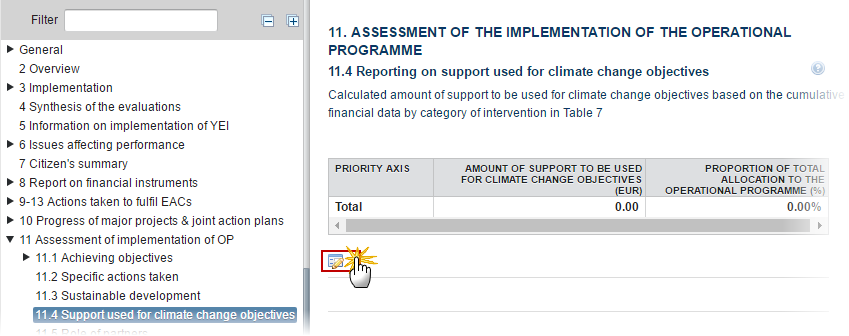
The Edit Details pop-up window appears:

Enter the following information:
(1) Enter a description text.
(2) Click on the Update link to save the information.
Note | The "Amount of Support to be used for Climate Change Objectives" is calculated by multiplying the Union Support of the Priority Axis with a Climate Change Rate. For the ERDF/CF part of the Priority Axis, get the Union Support and the Climate Change Rate from the Intervention Fields defined in Table 7 (Comes from Financial Data Table 2). Since in Table 7 there is no Union Support but only a Total Eligible Cost and a Public Eligible Cost per PA/Fund/Category of Region, multiply either of these two (based on the calculation basis of the PA/Fund/Category of Region) with the co-financing rate of the PA/Fund/Category of Region in Table 18a of the linked Programme version. If the Climate Change Rate for an Intervention Field = 0, then check that all Investment Priorities of the Priority Axis are related to TO4 or TO5 only. Only in this case, apply 40% as co-financing rate. For the ESF part of the Priority Axis, get the Union Support and the Climate Change Rate from the ESF Secondary Themes defined in Table 7 (Comes from Financial Data Table 2). Since in Table 7 there is no Union Support but only a Total Eligible Cost and a Public Eligible Cost per PA/Fund/Category of Region, multiply either of these two (based on the calculation basis of the PA/Fund/Category of Region) with the co-financing rate of the PA/Fund/Category of Region in Table 18a of the linked Programme version. We only show those Priority Axes which have a calculated amount > 0. The "Proportion of total allocation to the operational programme" is calculated by dividing the "Amount of support to be used for climate change objectives" by the Total Union Support (A) of Table 18a of the linked Programme version (=Performance Reserve included). |
11.5 Role of Partners
Clicking on the Edit button
 will open a pop up window allowing you to add a description text for the role of partners in the implementation of the programme.
will open a pop up window allowing you to add a description text for the role of partners in the implementation of the programme.

The Edit Details pop-up window appears:

Enter the following information:
(1) Enter a description text.
(2) Click on the Update link to save the information.
12. Obligatory Information and Assessment
Note | In AIRs 2017, 2019, 2020, 2021 and 2022 the following sections and their sub-sections are not be editable, and therefore not displayed (both in web, web service and will be empty in print): 11, 12, 14.1, 14.2, 14.3, 14.5, 14.6, 15, 16, 17, 18 |
12.1 Evaluation Plan
Progress in implementation of the evaluation plan and the follow-up given to the findings of evaluations
Clicking on the Edit button
 will open a pop up window allowing you to add a description text for the progress in implementation of the evaluation plan and the follow-up given to the findings of evaluation.
will open a pop up window allowing you to add a description text for the progress in implementation of the evaluation plan and the follow-up given to the findings of evaluation.
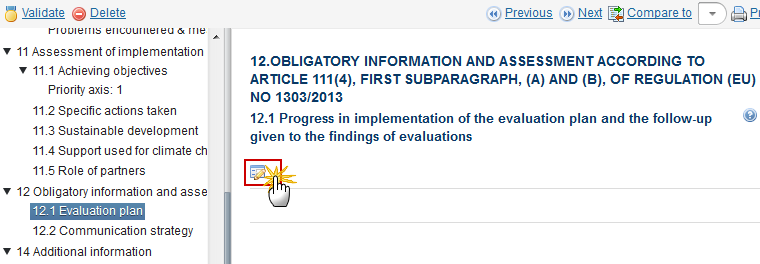
The Edit Details pop-up window appears:

Enter the following information:
(1) Enter a description text.
(2) Click on the Update link to save the information.
Click on the Add button
 to add the information in the evaluation table.
to add the information in the evaluation table.

The Edit Details pop-up window appears:
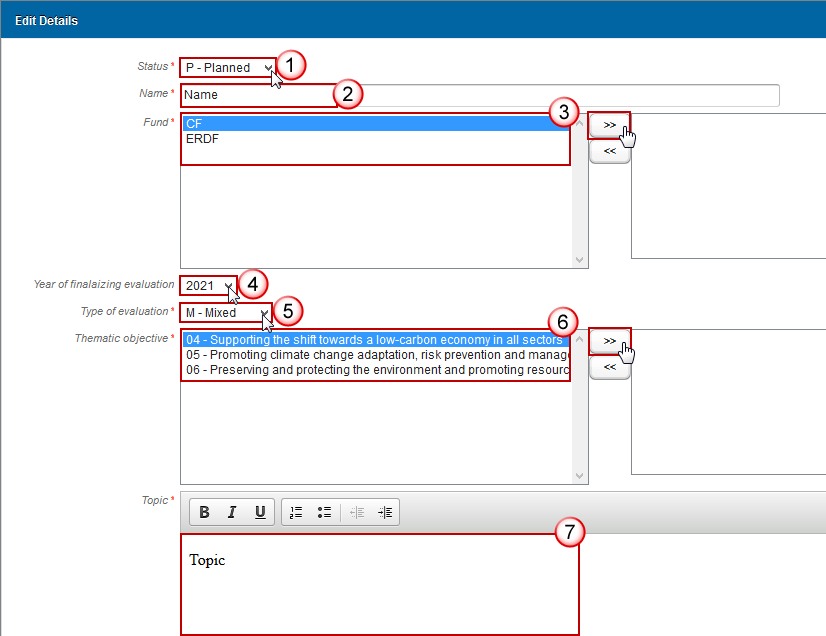

Select the following information:
(1) Select the Status
(2) Enter the Name
(3) Select the Funds
The Funds list contains all Funds covered by the Programme.
(4) Select the year of finalizing evaluation
(5) Select the type of evaluation
(6) Select the Thematic Objectives
The Thematic Objectives list contains all Thematic Objectives covered by the Programme.
(7) Enter the topic
(8) Enter the findings
(9) Enter the follow up explanation
(10) Click on the Update link to save the information.
12.2 Communication Strategy
The results of the information and publicity measures of the Funds carried out under the communication strategy
Clicking on the Edit button
 will open a pop up window allowing you to add a description text for the results of the information and publicity measures of the Funds under the communication strategy.
will open a pop up window allowing you to add a description text for the results of the information and publicity measures of the Funds under the communication strategy.
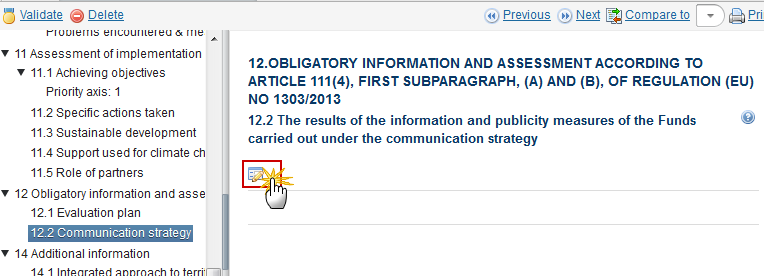
The Edit Details pop-up window appears:

Enter the following information:
(1) Enter a description text.
(2) Click on the Update link to save the information.
14. Additional Information
Additional information which may be added depending on the content and objectives of the Operational Programme.
Note | In AIRs 2017, 2019, 2020, 2021 and 2022 the following sections and their sub-sections are not be editable, and therefore not displayed (both in web, web service and will be empty in print): 11, 12, 14.1, 14.2, 14.3, 14.5, 14.6, 15, 16, 17, 18 The Macro-Regional and Sea Basin Strategies have been left out for this disable because they must be enabled at all time. |
14.1 Integrated Approach to Territorial Development
Clicking on the Edit button
 will open a pop up window allowing you to add a description text for the progress in the implementation of the integrated approach to territorial development.
will open a pop up window allowing you to add a description text for the progress in the implementation of the integrated approach to territorial development.

The Edit Details pop-up window appears:

Enter the following information:
(1) Enter a description text.
(2) Click on the Update link to save the information.
14.2 Reinforce Capacity to Administer
Clicking on the Edit button
 will open a pop up window allowing you to add a description text for the progress in the implementation of actions to reinforce the capacity of Member State Authorities.
will open a pop up window allowing you to add a description text for the progress in the implementation of actions to reinforce the capacity of Member State Authorities.

The Edit Details pop-up window appears:

Enter the following information:
(1) Enter a description text.
(2) Click on the Update link to save the information.
14.3 Interregional and Transnational Actions
Clicking on the Edit button
 will open a pop up window allowing you to add a description text for the progress in the implementation of any interregional and transnational actions.
will open a pop up window allowing you to add a description text for the progress in the implementation of any interregional and transnational actions.
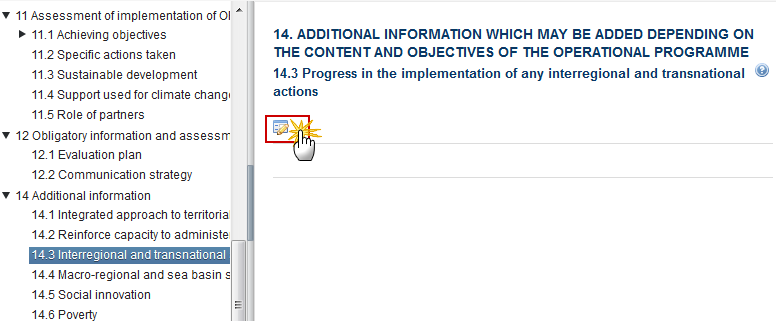
The Edit Details pop-up window appears:

Enter the following information:
(1) Enter a description text.
(2) Click on the Update link to save the information.
14.4 Macro-Regional and Sea Basin Strategies
Clicking on the Edit button
 will open a pop up window allowing you to enter an explanation.
will open a pop up window allowing you to enter an explanation.
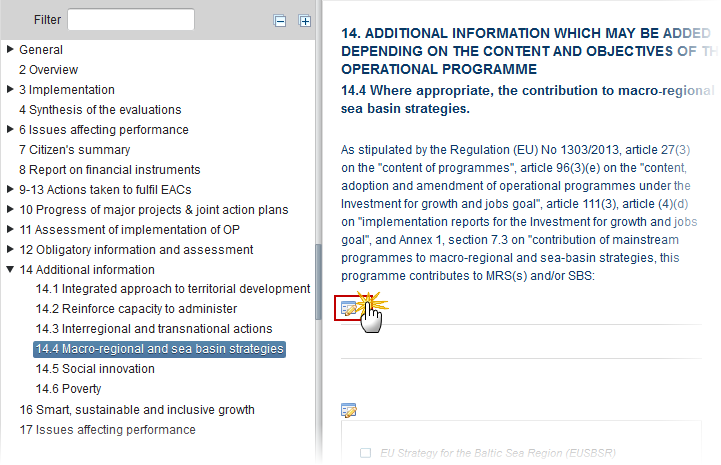
The Edit Details pop-up window appears:

Enter the following information:
(1) Enter a description text.
(2) Click on the Update link to save the information.
Clicking on the Edit button
 will open a pop up window allowing you to select the EU Strategy.
will open a pop up window allowing you to select the EU Strategy.
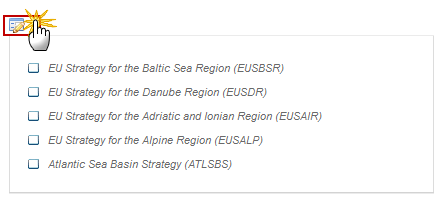
The table becomes editable:
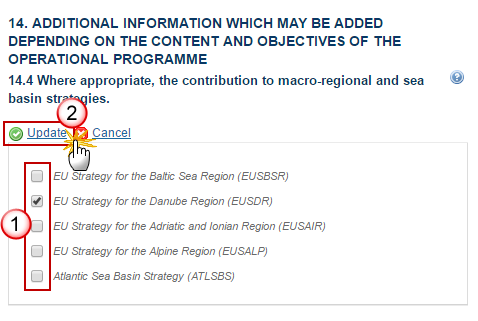
Enter the following information:
(1) Select the EU Strategy.
(2) Click on the Update link to save the information.
EUSBSR
EU Strategy for the Baltic Sea Region.
Relevance
Clicking on the Edit button
 will open a pop up window allowing you to enter the relevance of EUSBSR (2016 onwards).
will open a pop up window allowing you to enter the relevance of EUSBSR (2016 onwards).
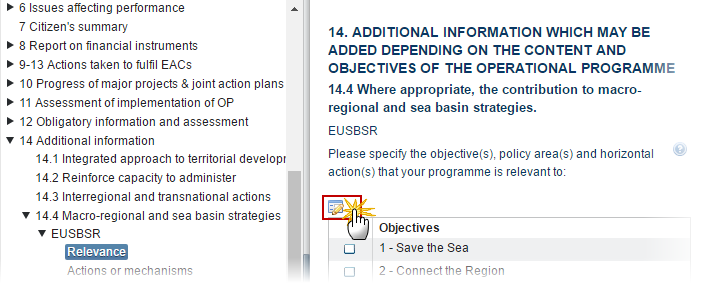
The table becomes editable:
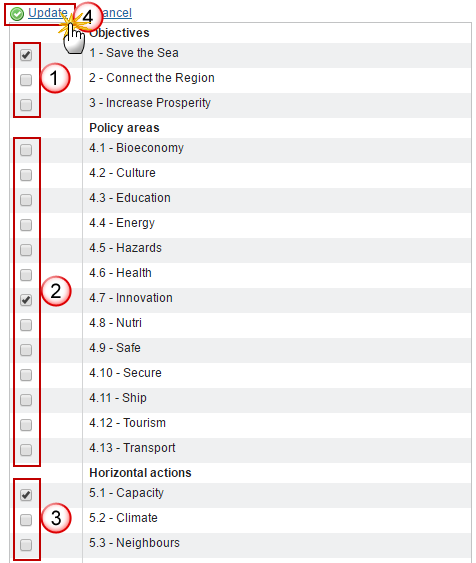
Enter the following information:
(1) Select the Objectives.
(2) Select the Policy Areas.
(3) Select the Horizontal actions.
(4) Click on the Update link to save the information.
Note | By default, all items will be un-ticked. At least one relevance must be selected. |
Actions or mechanisms
Clicking on the Edit button
 will open a table allowing you to enter the actions or mechanisms used to better link the programme with the EUSBSR.
will open a table allowing you to enter the actions or mechanisms used to better link the programme with the EUSBSR.

The table becomes editable:

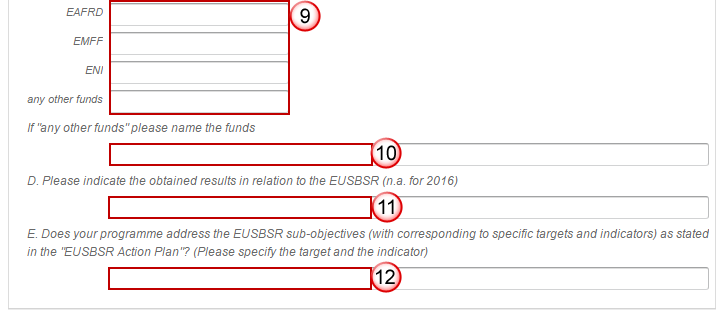
Enter the following information:
(1) Select Yes or No if the macro-regional coordinators are participating in the Monitoring Committee of the programme.
(2) If Yes, it is a must to provide a name and function.
(3) Select Yes or No if extra-points have been attributed to specific measures.
(4) If Yes, select Yes or No if there are targeted calls for proposals.
(5) If Yes, enter the number of macro-regional projects/actions already supported by the programme.
(6) Enter Yes or No if were given extra points to a project (if yes, elaborate one sentence).
(7) Enter Other actions.
(8) Select Yes or No if the programme has invested EU funds.
(9) If Yes, enter the amount invested.
It is a must to enter at least the amount for one fund.
(10) If any other funds, enter the funds.
(11) Indicate the obtained results.
(12) Specify the target and the indicator when your programme address the EUSBSR.
(13) Click on the Update link to save the information.
Note | Questions A, B and C must be answered. |
EUSDR
EU Strategy for the Danube Region.
Relevance
Clicking on the Edit button
 will open a pop up window allowing you to enter the relevance of EUSDR (2016 onwards).
will open a pop up window allowing you to enter the relevance of EUSDR (2016 onwards).

The table becomes editable:

Enter the following information:
(1) Select the pillars.
(2) Click on the Update link to save the information.
Note | By default, all items will be un-ticked. At least one relevance must be selected. |
Actions or mechanisms
Clicking on the Edit button
 will open a table allowing you to enter the actions or mechanisms used to better link the programme with the EUSDR.
will open a table allowing you to enter the actions or mechanisms used to better link the programme with the EUSDR.
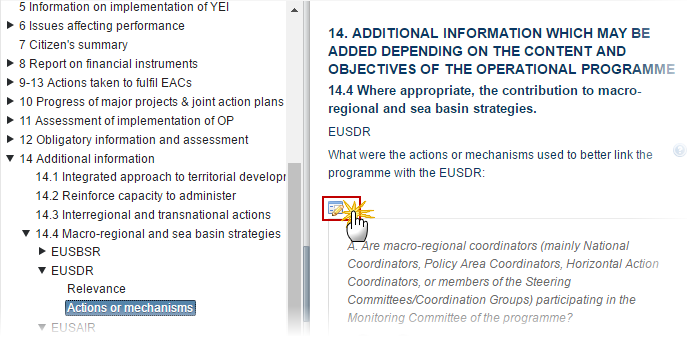
The table becomes editable:
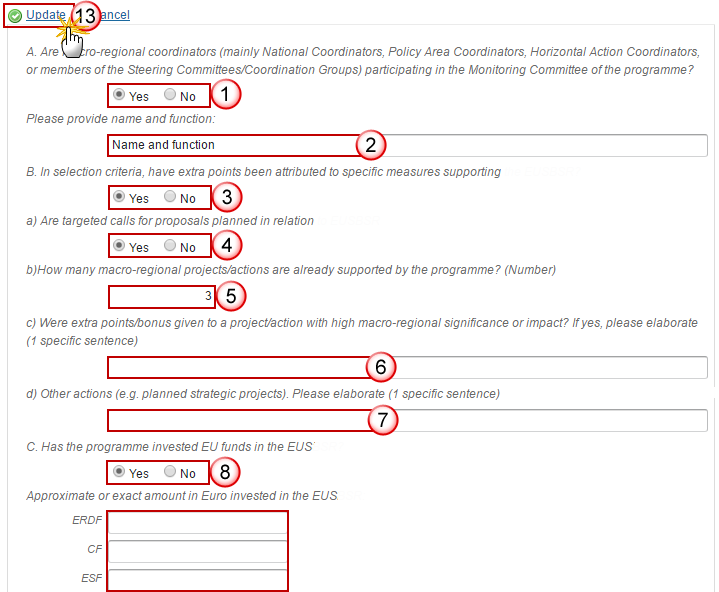
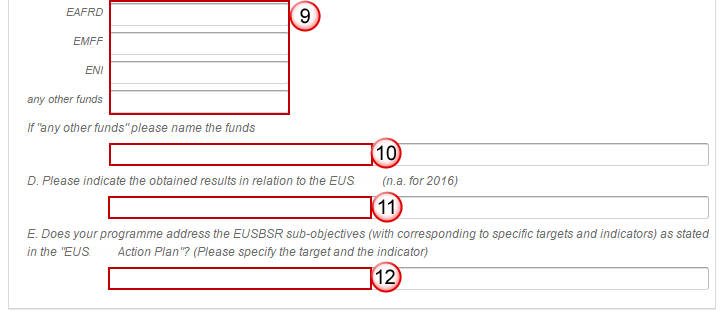
Enter the following information:
(1) Select Yes or No if the macro-regional coordinators are participating in the Monitoring Committee of the programme.
(2) If Yes, it is a must to provide a name and function.
(3) Select Yes or No if extra-points have been attributed to specific measures.
(4) If Yes, select Yes or No if there are targeted calls for proposals.
(5) If Yes, enter the number of macro-regional projects/actions already supported by the programme.
(6) Enter Yes or No if were given extra points to a project (if yes, elaborate one sentence).
(7) Enter Other actions.
(8) Select Yes or No if the programme has invested EU funds.
(9) If Yes, enter the amount invested.
(10) If any other funds, enter the funds.
(11) Indicate the obtained results.
(12) Specify the target and the indicator when your programme address the EUSDR.
(13) Click on the Update link to save the information.
Note | Questions A, B and C must be answered. |
EUSAIR
EU Strategy for the Adriatic and Ionian Region.
Relevance
Clicking on the Edit button
 will open a pop up window allowing you to enter the relevance of EUSAIR (2016 onwards).
will open a pop up window allowing you to enter the relevance of EUSAIR (2016 onwards).

The Table becomes editable:
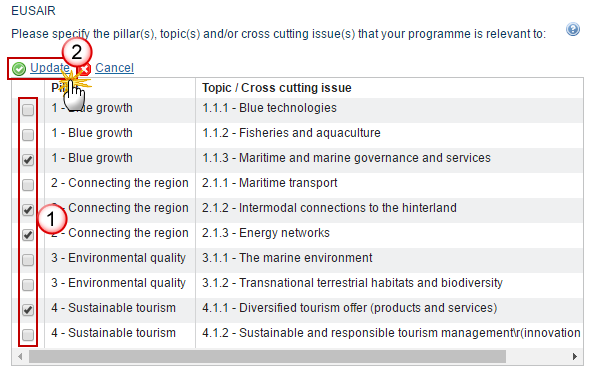
Enter the following information:
(1) Select the pillars.
(2) Click on the Update link to save the information.
Note | By default, all items will be un-ticked. At least one relevance must be selected. |
Actions or mechanisms
Clicking on the Edit button
 will open a table allowing you to enter the actions or mechanisms used to better link the programme with the EUSAIR.
will open a table allowing you to enter the actions or mechanisms used to better link the programme with the EUSAIR.

The table becomes editable:


Enter the following information:
(1) Select Yes or No if the macro-regional coordinators are participating in the Monitoring Committee of the programme.
(2) If Yes, it is a must to provide a name and function.
(3) Select Yes or No if extra-points have been attributed to specific measures.
(4) If Yes, select Yes or No if there are targeted calls for proposals.
(5) If Yes, enter the number of macro-regional projects/actions already supported by the programme.
(6) Enter Yes or No if were given extra points to a project (if yes, elaborate one sentence).
(7) Enter Other actions.
(8) Select Yes or No if the programme has invested EU funds.
(9) If Yes, enter the amount invested.
(10) If any other funds, enter the funds.
(11) Indicate the obtained results.
(12) Specify the target and the indicator when your programme address the EUSAIR.
(13) Click on the Update link to save the information.
Note | Questions A, B and C must be answered. |
EUSALP
EU Strategy for the Alpine Region.
Relevance
Clicking on the Edit button
 will open a pop up window allowing you to enter the relevance of EUSALP (2016 onwards).
will open a pop up window allowing you to enter the relevance of EUSALP (2016 onwards).

The table becomes editable:
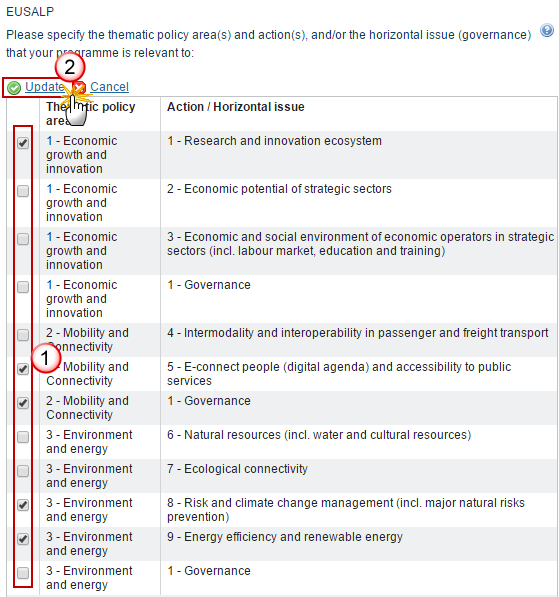
Enter the following information:
(1) Select the thematic policy area and the action/horizontal issue.
(2) Click on the Update link to save the information.
Note | By default, all items will be un-ticked. At least one relevance must be selected. |
Actions or mechanisms
Clicking on the Edit button
 will open a table allowing you to enter the actions or mechanisms used to better link the programme with the EUSALP.
will open a table allowing you to enter the actions or mechanisms used to better link the programme with the EUSALP.
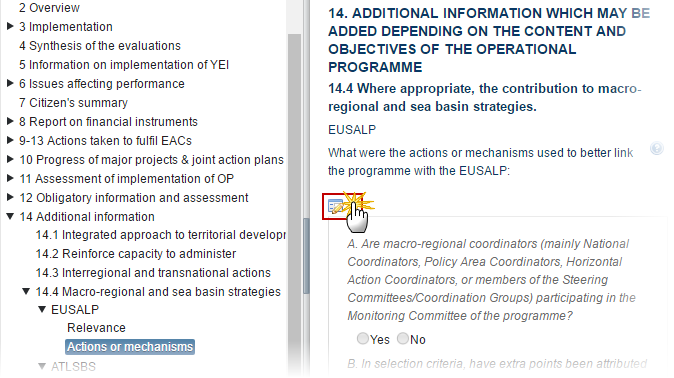
The table becomes editable:


Enter the following information:
(1) Select Yes or No if the macro-regional coordinators are participating in the Monitoring Committee of the programme.
(2) If Yes, it is a must to provide a name and function.
(3) Select Yes or No if extra-points have been attributed to specific measures.
(4) If Yes, select Yes or No if there are targeted calls for proposals.
(5) If Yes, enter the number of macro-regional projects/actions already supported by the programme.
(6) Enter Yes or No if were given extra points to a project (if yes, elaborate one sentence).
(7) Enter Other actions.
(8) Select Yes or No if the programme has invested EU funds.
(9) If Yes, enter the amount invested.
(10) If any other funds, enter the funds.
(11) Indicate the obtained results.
(12) Specify the target and the indicator when your programme address the EUSALP.
(13) Click on the Update link to save the information.
Note | Questions A, B and C must be answered. |
ATLSBS
Atlantic Sea Basin Strategy.
Relevance
Clicking on the Edit button
 will open a pop up window allowing you to enter the priorities and objectives relevant of ATLSBS (2016 onwards).
will open a pop up window allowing you to enter the priorities and objectives relevant of ATLSBS (2016 onwards).

The table becomes editable:
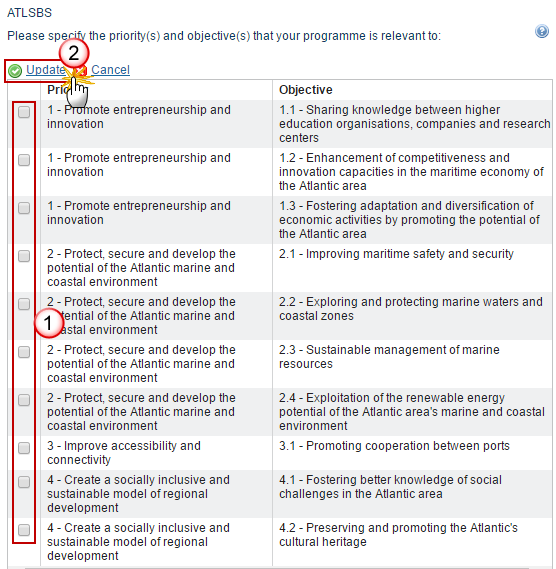
Enter the following information:
(1) Select the priority and the objective.
(2) Click on the Update link to save the information.
Note | By default, all items will be un-ticked. At least one relevance must be selected. |
Actions or mechanisms
Clicking on the Edit button
 will open a table allowing you to enter the actions or mechanisms used to better link the programme with the ATLSBS.
will open a table allowing you to enter the actions or mechanisms used to better link the programme with the ATLSBS.

The table becomes editable:


Enter the following information:
(1) Select Yes or No if the macro-regional coordinators are participating in the Monitoring Committee of the programme.
(2) If Yes, it is a must to provide a name and function.
(3) Select Yes or No if extra-points have been attributed to specific measures.
(4) If Yes, select Yes or No if there are targeted calls for proposals.
(5) If Yes, enter the number of macro-regional projects/actions already supported by the programme.
(6) Enter Yes or No if were given extra points to a project (if yes, elaborate one sentence).
(7) Enter Other actions.
(8) Select Yes or No if the programme has invested EU funds.
(9) If Yes, enter the amount invested.
(10) If any other funds, enter the funds.
(11) Indicate the obtained results.
(12) Specify the target and the indicator when your programme address the ATLSBS.
(13) Click on the Update link to save the information.
Note | Questions A, B and C must be answered. |
14.5 Social Innovation
Clicking on the Edit button
 will open a pop up window allowing you to add a description text for the progress in the implementation of actions in the field of social innovation.
will open a pop up window allowing you to add a description text for the progress in the implementation of actions in the field of social innovation.
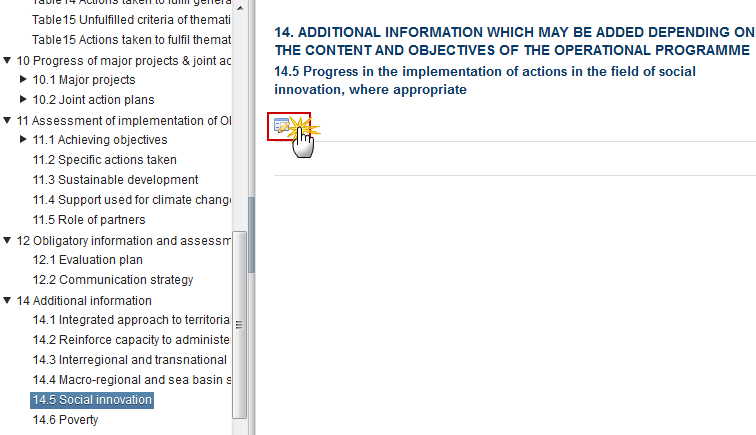
The Edit Details pop-up window appears:

Enter the following information:
(1) Enter a description text.
(2) Click on the Update link to save the information.
14.6 Poverty
Clicking on the Edit button
 will open a pop up window allowing you to add a description text for the Progress in the implementation of measures to address the specific needs of geographical areas most affected by poverty.
will open a pop up window allowing you to add a description text for the Progress in the implementation of measures to address the specific needs of geographical areas most affected by poverty.
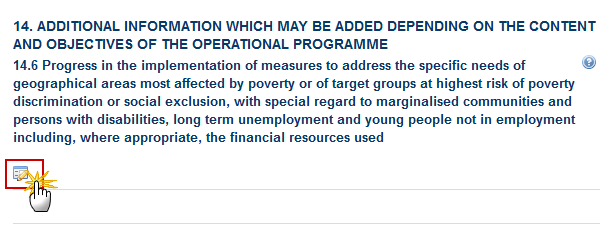
The Edit Details pop-up window appears:

Enter the following information:
(1) Enter a description text.
(2) Click on the Update link to save the information.
16. Smart, Sustainable and Inclusive Growth
Note | In AIRs 2017, 2019, 2020, 2021 and 2022 the following sections and their sub-sections are not be editable, and therefore not displayed (both in web, web service and will be empty in print): 11, 12, 14.1, 14.2, 14.3, 14.5, 14.6, 15, 16, 17, 18 |
Clicking on the Edit button
 will open a pop up window allowing you to add a description text for the sustainable and inclusive growth.
will open a pop up window allowing you to add a description text for the sustainable and inclusive growth.

The Edit Details pop-up window appaers:

Enter the following information:
(1) Enter a description text.
(2) Click on the Update link to save the information.
17. Issues affecting Performance
Note | In AIRs 2017, 2019, 2020, 2021 and 2022 the following sections and their sub-sections are not be editable, and therefore not displayed (both in web, web service and will be empty in print): 11, 12, 14.1, 14.2, 14.3, 14.5, 14.6, 15, 16, 17, 18 |
Clicking on the Edit button
 will open a pop up window allowing you to add a description text for the issues affecting the performance of the programme and measures taken.
will open a pop up window allowing you to add a description text for the issues affecting the performance of the programme and measures taken.

The Edit Details pop-up window appears:

Enter the following information:
(1) Enter a description text.
(2) Click on the Update link to save the information.
18. YEI
YEI (information required under Article 19(4) and (6) of Regulation 1304/2013)
Note | In AIRs 2017, 2019, 2020, 2021 and 2022 the following sections and their sub-sections are not be editable, and therefore not displayed (both in web, web service and will be empty in print): 11, 12, 14.1, 14.2, 14.3, 14.5, 14.6, 15, 16, 17, 18 |
Clicking on the Edit button
 will open a pop up window allowing you to add a description text for the Youth Employment Initiative.
will open a pop up window allowing you to add a description text for the Youth Employment Initiative.

The Edit Details pop-up window appears:

Enter the following information:
(1) Enter a description text.
(2) Click on the Update link to save the information.
Annex I
List of all operations phased from 2014-2020 into 2021-2027
REMARK | Annex I is only shown in the Final Implementation Report (9999). |
Click on the Add button
 to add the information on this table.
to add the information on this table.Select a row and click on the Delete button in the corresponding table
 to remove the selected information.
to remove the selected information.Select a row and click on the Edit button in the corresponding table
 to modify the information of this row.
to modify the information of this row.
Clicking on the Add button
 will open the products table allowing you to enter the information.
will open the products table allowing you to enter the information.
The Edit Details pop-up window appears:

Enter the following information:
(1) Select the Priority/Fund/Category of region.
The list of Priority/Fund/Category or region combinations contains all combinations covered by the linked Programme version.
(2) Enter the Operation reference.
(3) Enter the Operation title.
(4) Select the Date of tacit agreement/approval by commission (if major project).
(5) Enter the Number of tacit agreement/approval by commission (if major project).
(6) Tick the box Phased operation under article 118, if applicable.
The Phased operation under article 118 and the Phased operation under article 118a checkboxes are exclusive.
(7) Tick the box Phased operation under article 118a, if applicable.
(8) Enter the Total cost of operation (in EUR) - Total (for both phases, final or estimated).
(9) Enter the Total cost of operation (in EUR) - For the second phase (final or estimated).
(10) Enter the Total certified expenditure for the first phase (in EUR).
(11) Enter the Public contribution for the first phase (in EUR).
(12) Enter the Planned/final completion date of the second phase (year, quarter).
(13) Enter the 2021-2027 Programme under which the operation will be/was completed.
(14) Click on the Update link to save the information.
Annex II
List of non-functioning operations
REMARK | Annex II is only shown in the Final Implementation Report (9999). |
Click on the Add button
 to add the information on this table.
to add the information on this table.Select a row and click on the Delete button in the corresponding table
 to remove the selected information.
to remove the selected information.Select a row and click on the Edit button in the corresponding table
 to modify the information of this row.
to modify the information of this row.
Clicking on the Add button
 will open the products table allowing you to enter the information.
will open the products table allowing you to enter the information.

The Edit Details pop-up window appears:

Enter the following information:
(1) Select the Priority/Fund/Category of region.
The list of Priority/Fund/Category or region combinations contains all combinations covered by the linked Programme version.
(2) Enter the Operation reference.
(3) Enter the Operation title.
(4) Enter the Name of the beneficiary / recipient.
(5) Enter the Total cost of the operation (in EUR).
(6) Enter the Total Certified Expenditure (in EUR).
(7) Enter the Public contribution (in EUR).
(8) Click on the Update link to save the information.
Annex III
List of operations affected by ongoing national investigations / suspended by a legal proceeding or by an administrative appeal having suspensory effect
REMARK | Annex III is only shown in the Final Implementation Report (9999). |
Click on the Add button
 to add the information on this table.
to add the information on this table.Select a row and click on the Delete button in the corresponding table
 to remove the selected information.
to remove the selected information.Select a row and click on the Edit button in the corresponding table
 to modify the information of this row.
to modify the information of this row.
Clicking on the Add button
 will open the products table allowing you to enter the information.
will open the products table allowing you to enter the information.

The Edit Details pop-up window appears:
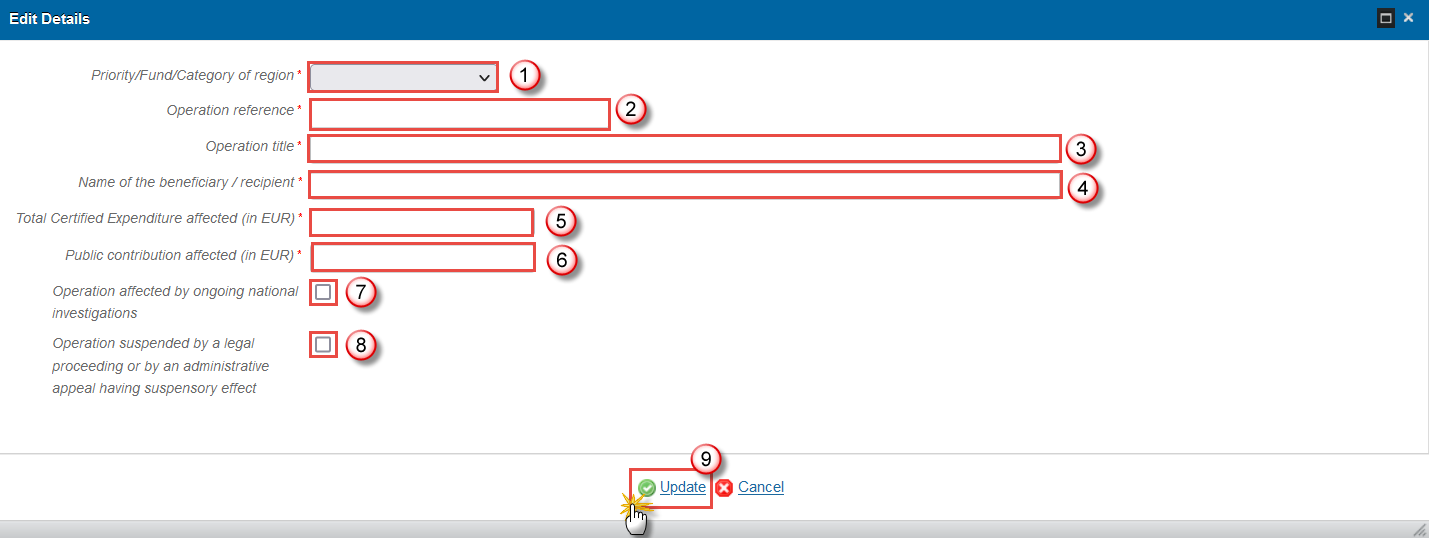
Enter the following information:
(1) Select the Priority/Fund/Category of region.
The list of Priority/Fund/Category or region combinations contains all combinations covered by the linked Programme version.
(2) Enter the Operation reference.
(3) Enter the Operation title.
(4) Enter the Name of the beneficiary / recipient.
(5) Enter the Total Certified Expenditure affected (in EUR).
(6) Enter the Public contribution affected (in EUR).
(7) Tick the box Operation affected by ongoing national investigations, if applicable.
(8) Tick the box Operation suspended by a legal proceeding or by an administrative appeal having suspensory effect, if applicable.
(9) Click on the Update link to save the information.
Validate the Implementation Report (IGJ)
REMARK | The Implementation Report can be validated when it is in a status 'Open' and currently resides at your Node. In the Last validation results list, Warning Messages that already existed in the previous minor version will be shown in grey and ordered at the end of the list. It is a must to have the role of MS Managing Authority Update. |
Click on the Validate link to validate the Implementation Report (IGJ).
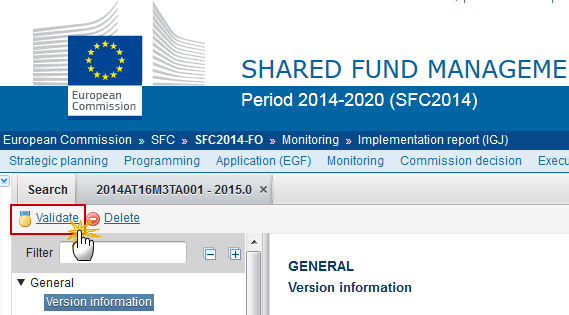
The system validates the following information:
REMARK | An Error will block you from sending the IR (IGJ). The error(s) should be resolved and the IR must be revalidated. Note that a Warning does not block you from sending the Implementation Report. |
CODE | VALIDATION RULES | SEVERITY |
2 | The system validates the integrity of the input fields |
|
2.1 | Validate that at least one Official in Charge of the Member State exists | Warning |
2.2 | Validate that the CCI code matches the following regular expression (implicit in web): For IGJ (……16..OP…|……05(?!FM|FS)..OP…|……05..TA…| ……16..TA…| ……16..SM…|2020..16RFRE...|2020..05SFRE…| 2020..16M2RE…|2020..05M2RE…|2020..16M0RE…|2020..05M0RE…| 2020..05M9RE…) | Error |
2.3 | Validate that the linked Programme version is the last adopted version at the time of initial creation of the implementation report’s working version 0 (implicit in web) | Warning |
2.5 | Validate that all integral documents have at least one attachment with a length > 0 | Error |
2.6 | Validate in Table 2C when quantitative indicator with measurement unit = Number and when gender breakdown has been provided, that the sum of the annual gender breakdown is equal to the annual total. | Error |
2.7 | Validate in Table 4A per Priority Axis/Investment Priority/Category of Region that: 1. Figures reported for CO01 are higher or equal to figures for CO02, 2. Figures reported for CO03 are higher or equal to figures for CO04, 3. The sum of CO01, CO03 and CO05 is higher or equal to the sum of CO06, CO7, 4. Figures reported for CO07 are higher or equal to figures for CO08, 5. The sum of CO01, CO03 and CO05 is higher or equal to the sum of CO09, CO10 and CO11, 8. Figures reported for CO17 are higher or equal to CO18, (warning) 9. The sum of CO01, CO03 and CO05 is higher or equal to figures for any of the common output indicators on participants (=CO01 to CO17) (error) 10. The grand total of participants is higher or equal to the sum of CO01+CO03+CO05 (error). 11. no figures are necessary for CO12, CO13 and CO14 when they are not used for target setting in Table 2A (warning) => "Common Indicators CO12, CO13 and CO14 are obsolete following the omnibus regulation and therefore don’t need to be reported: Table 4A, priority axis: {0}, investment priority: {1}, region category: {2}, output indicator: {3}” 12. Figures are necessary for CO12, CO13 and CO14 when they are used for target setting in Table 2A (error) => "Common Indicators CO12, CO13 and CO14 should have annual achievement values when they are used for target setting in Table 2A: Table 4A, priority axis: {0}, investment priority: {1}, region category: {2}, output indicator: {3}”. 13. The sum of CO01, CO03 and CO05 for cumulative figures only is higher or equal to the cumulative figures for the common output indicators on participants CO18 and CO19 (error). | Error |
2.8 | Validate in Table 2A per Priority Axis/Investment Priority/Category of Region that: 1. Cumulative figures reported for CR01 and not linked to a target are less or equal to cumulative figures for CO03 in Table 4A, 2. Cumulative figures reported for CR02 and not linked to a target are less or equal to the sum of cumulative figures for CO01, CO03 and CO05 in Table 4A, 3. Cumulative figures reported for CR03 and not linked to a target are less or equal to the sum of cumulative figures for CO01, CO03 and CO05 in Table 4A, 4. Cumulative figures reported for CR04 and not linked to a target are less or equal to the sum of cumulative figures for CO01 and CO03 in Table 4A, 5. For AIRs < 2018, the cumulative figures reported for CR05 and not linked to a target are less or equal to the sum of cumulative figures for CO12, CO14, CO15, CO16 and CO17 in Table 4A, 6. Cumulative figures reported for CR06 and not linked to a target are less or equal to the sum of cumulative figures for CO01 and CO03 in Table 4A, 7. Cumulative figures reported for CR07 and not linked to a target are less or equal to cumulative figures for CO05 in Table 4A, 8. Cumulative figures reported for CR08 and not linked to a target are less or equal to cumulative figures for CO08 in Table 4A (warning), 9. For AIRs < 2018, the cumulative figures reported for CR09 and not linked to a target are less or equal to the sum of cumulative figures for CO12, CO14, CO15, CO16 and CO17 in Table 4A, 10. Cumulative figures reported for the common result indicator linked to a target are less or equal to cumulative figures of the reference common output indicator reported in Table 4A. 11. Annual figures reported for CR01, CR02, CR03, CR04, and CR05 without a target are equal or higher than annual figures reported for CR01, CR02, CR03, CR04 and CR05 with a target, 12. Cumulative figures reported for CR01, CR02, CR03, CR04 and CR05 without a target are equal or higher than cumulative figures reported for CR01, CR02, CR03, CR04 and CR05 with a target, 13. Annual figures reported for CR06, CR07, CR08 and CR09 without a target are equal or higher than annual figures reported for CR06, CR07, CR08 and CR09 with a target, 14. Cumulative figures reported for CR06, CR07, CR08 and CR09 without a target are equal or higher than cumulative figures reported for CR06, CR07, CR08 and CR09 with a target, 15. Annual figures reported for CR05 are less or equal to the sum of annual figures for CR01, CR02, CR03 and CR04, 16. Cumulative figures reported for CR05 are less or equal to the sum of cumulative figures for CR01, CR02, CR03 and CR04, 17. Cumulative figures reported for CR08 for the year 2018 and 2023 are less or equal to the cumulative figures reported for CR06 (warning), 18. Cumulative figures reported for CR09 for the year 2018 and 2023 are less or equal to the cumulative figures reported for CR06 (warning). 19. for AIRs > = 2018, the cumulative figures of the reporting year reported for CR05 and not linked to a target are less or equal to the sum of cumulative figures of the reporting year for CO12, CO14, CO15, CO16 and CO17 in Table 4A. When CO12 and/or CO14 do not exist in the reporting year, then get its value from the last AIR in which it existed. 20. for AIRs >=2018, the cumulative figures of the reporting year reported for CR09 and not linked to a target are less or equal to the sum of cumulative figures of the reporting year for CO12, CO14, CO15, CO16 and CO17 in Table 4A. When CO12 and/or CO14 do not exist in the reporting year, then get its value from the last AIR in which it existed. | Error |
2.9 | Validate in Table 2B per Priority Axis/Investment Priority that: 1. cumulative figures for CRYEI 01 are less or equal to cumulative figures for CO01 in Table 4A, 2. cumulative figures for CRYEI 02 are less or equal to cumulative figures for CO01 in Table 4A, 3. cumulative figures for CRYEI 03 are less or equal to cumulative figures for CO01 in Table 4A, 4. cumulative figures for CRYEI 04 are less or equal to cumulative figures for CO02 in Table 4A 5. cumulative figures for CRYEI 05 are less or equal to cumulative figures for CO02 in Table 4A, 6. Cumulative figures for CRYEI 06 are less or equal to cumulative figures for CO02 in Table 4A, 7. Cumulative figures for CRYEI 07 are less or equal to cumulative figures for CO04 in Table 4A, 8. Cumulative figures for CRYEI 08 are less or equal to cumulative figures for CO04 in Table 4A, 9. Cumulative figures for CRYEI 09 are less or equal to cumulative figures for CO04 in Table 4A, 10. Cumulative figures for CRYEI 10 are less or equal to the sum of cumulative figures for CO01 and CO04 in Table 4A, 11. Cumulative figures for CRYEI 11 are less or equal to the sum of cumulative figures for CO01 and CO04 in Table 4A, 12. Cumulative figures for CRYEI 12 are less or equal to the sum of cumulative figures for CO01 and CO04 in Table 4A, 13. Cumulative figures for CRYEI 12 are less or equal to cumulative figures for CRYEI 11 in Table 4A. 14. Annual figures for CR04 are less or equal to the sum of annual figures for CRYEI03 and CRYEI09, 15. In AIRs 2018 and Final, the annual figures for CR06 are equal to the annual figures for CRYEI11, 16. Annual figures reported for CR01, CR02, CR03, CR04, CR05, CR06, CR07, CR08 and CR09 without a target are equal or higher than annual figures reported for CR01, CR02, CR03, CR04, CR05, CR06, CR07, CR08 and CR09 with a target, 17. Cumulative figures reported for CR01, CR02, CR03, CR04, CR05, CR06, CR07, CR08 and CR09 without a target are equal or higher than cumulative figures reported for CR01, CR02, CR03, CR04, CR05, CR06, CR07, CR08 and CR09 with a target. 18. No figures are reported for CO12, CO13 and CO14 (warning). | Error |
2.10 | Validate in Table 8 that the Priority Axes used are mono-Fund. | Warning |
2.11 | Validate in Table 1 when quantitative indicator and TA Priority Axis (Only TA Programme Specific Result indicators can have gender breakdown), that the sum of the annual gender breakdown is equal to the annual total. Remark: Since measurement unit in Table 12 of the Programme is free text, we cannot make any validation based on the fact that the measurement unit = Number. | Warning |
2.12 | Validate when work version = 0, that the "Report approval date by the monitoring committee" is not null. | Error |
2.13 | Validate in Table 2A that the annual values (men and women) are whole numbers. | Warning |
2.14 | Validate in Table 2B that the annual values (men and women) are whole numbers. | Warning |
2.15 | Validate in Table 2C when measurement Unit = 'N', that the annual and cumulative values (total, men and women) are whole numbers. | Error |
2.16 | Validate in Table 4A that the annual values (total, men and women) are whole numbers. | Error |
2.17 | Validate in Table 4B that the annual values (total, men and women) are whole numbers. | Error |
2.18 | Validate in Financial Instruments that element 26.1 is empty when element 7.1 of the master Fund of funds is empty or false. | Error |
2.19 | Validate in Financial Instruments when Thematic Objectives are defined that the sum of all Thematic Objective amounts (3.1) equals 14.1 | Warning |
2.20 | Validate in Financial Instruments that element 7.1.1 is empty when 7.1 is empty or false. | Error |
2.21 | Validate in Financial Instruments that element 12.1 is empty when 12 is different from 'Others'. | Error |
2.22 | Validate in Financial Instruments when (14.1.1+14.1.2+14.1.3+14.1.4+ 14.1.5) is not null that this sum is equal to 14.1 | Warning |
2.23 | Validate in Financial Instruments that elements 18, 19, 20 and 21 are empty when not a final implementation report. | Error |
2.24 | Validate in Financial Instruments that element 32.1 is empty when element 32 is empty or true. | Error |
2.25 | Validate in Financial Instruments that element 8.1.1 is empty when 8.1 is empty or false. | Error |
2.26 | Validate in Financial Instruments that element 9.1 is empty when 9.0.6 is empty or false. | Error |
2.27 | Validate in Financial Instruments that element 9.2 is empty when 9.0.7 is empty or false. | Error |
2.28 | Validate in Financial Instruments that element 25 is equal to 25.1 + 25.2 + 25.3 | Warning |
2.29 | Validate in Financial Instruments that element 29.4.1 is empty when 29.4 is <= 0 | Error |
2.30 | Validate in Table 2C when quantitative indicator and an annual value exists that the "Measurement unit for indicator" and the "Measurement unit for baseline and target" are not null. | Error |
2.31 | Validate in Table 2A that the annual Men and Women columns are not null for years <= reporting year, except for CO12, CO13 and CO14. | Error |
2.32 | Validate in Table 2B that the annual Men and Women columns are not null for years <= reporting year, except for CO12, CO13 and CO14. | Error |
2.33 | Validate in Table 4A, except for REACT-EU, REACT-EU CARE and REACT-EU SAFE Priority Axes, that the annual Men and Women columns are not null for Common Output Indicators CO01 to CO11 and CO15 to CO19 and years <= reporting year. | Error |
2.34 | Validate in Table 4A, except for REACT-EU, REACT-EU CARE and REACT-EU SAFE Priority Axes, that the annual Total columns are not null for Common Output Indicator CO20 to CO23 and years <= reporting year. | Error |
2.35 | Validate in Financial Instruments that the Thematic Objectives are covered by the selected Priority Axis. | Error |
2.36 | Validate in Financial Instruments that the Output Indicators (41) are used in the linked Programme version under the selected Priority Axis. | Error |
2.37 | Validate for each selected MRS/SBS that at least one relevance is selected. | Warning |
2.38 | Validate for each selected MRS/SBS that questions A, B and C are answered. | Warning |
2.39 | Validate for each selected MRS/SBS when answer to question A is Yes, that the Name is not null. | Warning |
2.40 | Validate for each selected MRS/SBS when answer to question B is Yes, that question a) is answered and that question b) is not null. | Warning |
2.41 | Validate for each selected MRS/SBS when answer to question C is Yes, that at least one Fund has an amount. | Warning |
2.42 | Validate for each selected MRS/SBS when “Any other Fund” has an amount, that “any other Fund name” is not null. | Warning |
2.44 | Validate in Table 2A and 2B per Priority Axis/Investment Priority/Category of Region when a Common Result Indicator has a Common Output Indicator used as a basis for target setting and a “Cumulative Value Total/Men/Women“ > 0, that the “Cumulative Value Total/Men/Women“ of that Output Indicator in Table 4A for the same Priority Axis/Investment Priority/Category of Region is > 0. => "For result indicator in table {0} with an common output Indicator used as a basis for target setting, and cumulative values total/men/women > 0, the cumulative values total/men/women in table 4A for that common output indicator must also be > 0 (priority axis: {1}, investment priority: {2}, region category: {3}, result indicator: {4}, output indicator: {5})” | Error |
2.45 | Validate in Table 2A and 2B per Priority Axis/Investment Priority/Category of Region when a Common Result Indicator has a Common Output Indicator used as a basis for target setting and a “Cumulative Value Total/Men/Women“, that this “Cumulative Value Total/Men/Women“ is <= the “Cumulative Value Total/Men/Women“ of that Output Indicator in Table 4A for the same Priority Axis/Investment Priority/Category of Region. => "For result indicator in table {0} with an common output indicator used as a basis for target setting, the values for cumulative value total/men/women must be less or equal than the same values in table 4A for that common output indicator (priority axis: {1}, investment priority: {2}, region category: {3}, result indicator: {4}, output indicator: {5}) | Error |
2.46 | Validate in Table 2C per Priority Axis/Investment Priority/Category of Region when a Programme Specific Result Indicator with measurement unit “Number” has an Output Indicator used as a basis for target setting with a measurement unit “Number” and a “Reporting Year Cumulative Value Total/Men/Women“ > 0, that the “Cumulative Value Total/Men/Women“ of that Output Indicator in Table 4A (Common) or in Table 4B (Programme Specific) for the same Priority Axis/Investment Priority/Category of Region is > 0. => "For result indicator in table 2C with an output indicator used as a basis for target setting, if the values for cumulative value total/men/women are > 0, then the same values in the entry in table 4A or 4B for that output indicator must be also > 0 (priority axis: {0}, investment priority/specific objective: {1}, region category: {2}, result indicator: {3}, output indicator: {4}) | Error |
2.47 | Validate in Table 2C per Priority Axis/Investment Priority/Category of Region when a Programme Specific Result Indicator with measurement unit “Number” has an Output Indicator used as a basis for target setting with measurement unit “Number” and a “Reporting Year Cumulative Value Total/Men/Women“, that this “Reporting Year Cumulative Value Total/Men/Women“ is <= the “Cumulative Value Total/Men/Women“ of that Output Indicator in Table 4A (Common) or in Table 4B (Programme Specific) for the same Priority Axis/Investment Priority/Category of Region. => "For result indicator in table 2C with an output indicator used as a basis for target setting, the values for “cumulative value total/men/women“ must be less or equal than the same values in the entry in table 4A or 4B for that output indicator (priority axis: {0}, investment priority/specific objective: {1}, region category: {2}, result indicator: {3}, output indicator: {4}) | Error |
2.48 | Validate in Table 1 for ERDF/CF when Annual total value is not null and Target value > Baseline, that the Annual Total values are >= Baseline value. => "Annual value entered in table 1 is below the baseline value and moving away from the target for priority axis: {0}, investment priority: {1}, specific objective: {2}, indicator: {3}, region category: {4}, year: {5} ({6} < {7}). Please check." | Warning |
2.49 | Validate in Table 1 for ERDF/CF when Annual total value is not null and Target value > Baseline, that the Annual Total values are <= Target value. => "Annual value entered in table 1 exceeds the target value for priority axis: {0}, investment priority: {1}, specific objective: {2}, indicator: {3}, region category: {4}, year: {5} ({6} > {7}). Please check." | Warning |
2.50 | Validate in Table 1 for ERDF/CF when Annual total value is not null and Target value < Baseline, that the Annual Total values are <= Baseline value. => "Annual value entered in table 1 is greater than the baseline value and moving away from the target for priority axis: {0}, investment priority: {1}, specific objective: {2}, indicator: {3}, region category: {4}, year: {5} ({6} > {7}). Please check." | Warning |
2.51 | Validate in Table 1 for ERDF/CF when Annual total value is not null and Target value < Baseline, that the Annual Total values are >= Target value. => "Annual value entered in table 1 is below the target value for priority axis: {0}, investment priority: {1}, specific objective: {2}, indicator: {3}, region category: {4}, year: {5} ({6} < {7}). Please check." | Warning |
2.52 | Validate in Table 3A for ERDF/CF that the Annual Total value for “S” is <= Total Target value. => "In table 3A, the annual total value entered is {0}% of the total target value for “S”, priority axis: {1}, investment priority: {2}, indicator: {3}, region category: {4}, year: {5}. Please check." | Warning |
2.53 | Validate in Table 3A for ERDF/CF that the Annual Total value for “F” is <= Total Target value. => "In table 3A, the annual total value entered is {0}% of the total target value for “F”, priority axis: {1}, investment priority: {2}, indicator: {3}, region category: {4}, year: {5}. Please check." | Warning |
2.54 | Validate in Table 3A for ERDF/CF that the Annual Total value for “F” is <= the Annual Total value for “S” for the same Indicator, Category of Region and Year. => "In table 3A, the annual total value entered for "F" (implemented) is {0}% of the annual total value entered for "S" (forecast from selected) for priority axis: {1}, investment priority: {2}, indicator: {3}, region category: {4}, year: {5}. Please check." | Warning |
2.55 | Validate in Table 3B that the Number of enterprises receiving support (CO01) is >= MAX of CO02, CO03, CO04 and CO05. => "In table 3B, the number of enterprises receiving support (CO01) cannot be less than the highest of the individual values of CO02, CO03, CO04 and CO05 ({0} < {1})” | Error |
2.56 | Validate in Table 3B that the SUM of CO02, CO03, CO04 and CO05 is >= Number of enterprises receiving support (CO01). => "In table 3B, the sum of CO02, CO03, CO04 and CO05 is less than the number of enterprises receiving support (CO01) ({0} < {1})" | Warning |
2.57 | Validate that Section 2 Overview of the implementation of the operational programme is not empty. | Error |
2.58 | Validate in Section 3.1 that for each Priority Axis the Key information field is not empty. | Error |
2.59 | Validate that Section 4 Synthesis of the Evaluations is not empty. | Error |
2.60 | Validate when Programme contains YEI, that Section 5 Information on the implementation of the YEI is not empty. | Error |
2.61 | Validate that Section 6.a Issues which affect the performance of the programme and the measures taken is not empty. | Error |
2.62 | Validate that Table 12 on Major Projects contains all Major Projects (based on CCI) linked to this Programme and that based on the "Status of MP" the following fields are not null:
| Error |
2.63 | Validate in Financial Instruments for FoF, SF and MA, that at least one Fund (=element 2) is selected. | Error |
2.64 | Validate in Financial Instruments for FoF, SF and MA, that at least one Thematic Objective (=element 3) is selected. | Error |
2.65 | Validate in Financial Instruments for FoF, SF and MA, that the selected CCIs (=element 4.1) are different than the CCI of the AIR. | Error |
2.66 | Validate in Financial Instruments for FoF and SF, that element 31.1 is true when element 13 is not null and vice versa. | Error |
2.67 | Validate in Financial Instruments for FoF and SF when element 7.2 is in (‘2’,’3’) or 7.3 is in (‘2’,’3’), that element 11.1 is not in (‘a’,’c’). | Error |
2.68 | Validate in Financial Instruments for FoF and SF, that element 13 is >= element 30. | Warning |
2.69 | Validate in Financial Instruments for SF/FoF, that element 13 is >= element 13 in master FoF | Error |
2.70 | Validate in Financial Instruments for FoF, SF/FoF and SF, that element 15 is <= element 14. | Error |
2.71 | Validate in Financial Instruments for MA, that element 7.2 = ‘d. undertaking implementation directly’. | Error |
2.72 | Validate in Financial Instruments for FoF, SF/FoF and SF that element 38.2 is <= element 38.1. | Warning |
2.73 | Validate in Financial Instruments for FoF, SF/FoF and SF when 38.2 is not null that element 38.2 is >= element 15.2 (Error in AIR2018 and FIR, Warning in other AIRs) | Error Warning |
2.74 | Validate in Financial Instruments for FoF, SF/FoF and SF when 38.2.1 is not null that element 38.2.1 is >= element 15.2.1 (Error in AIR2018 and FIR, Warning in other AIRs) | Error Warning |
2.75 | Validate in Financial Instruments for FoF, SF/FoF and SF when 38.2.2 is not null that element 38.2.2 is >= element 15.2.2 (Error in AIR2018 and FIR, Warning in other AIRs) | Error Warning |
2.76 | Validate in Financial Instruments for SF/FoF, SF and MA that element 22 is different from element 11.1.1. | Error |
2.77 | Validate in Financial Instruments for SF/FoF, SF and MA that element 25 is <= element 24. | Error |
2.78 | Validate in Financial Instruments for SF/FoF, SF and MA that element 25.1 is <= element 24.1. | Error |
2.80 | Validate in Financial Instruments for SF/FoF, SF and MA that element 29 is <= element 27. | Error |
2.81 | Validate in Financial Instruments for SF/FoF, SF and MA that element 29 = element 29.1+29.2+29.3+29.4. | Error |
2.82 | Validate in Financial Instruments for SF/FoF, SF and MA that element 24.1 is <= element 24. | Error |
2.83 | Validate in Financial Instruments for SF/FoF, SF and MA for years >= 2017 when 38.3.1 is not null that element 38.3.1 is >= element 25.2 (Error in AIR2018 and FIR, Warning in other AIRs) | Error Warning |
2.84 | Validate in Financial Instruments Equities and Loans for SF/FoF, SF and MA for years >= 2017 when 38.3.2 is not null that element 38.3.2 is >= element 25.3 (Error in AIR2018 and FIR, Warning in other AIRs) | Error Warning |
2.85 | Validate in Financial Instruments Guarantees for SF/FoF, SF and MA when element 25 > 0 that element 26 is > 0 | Warning |
2.86 | Validate in Financial Instruments for SF/FoF and SF when element 22.1 is “O. Other support combined within the financial instrument” that 9.0.7 is true. | Error |
2.87 | Validate in Financial Instruments for SF/FoF, SF and MA that at least 1 output indicator (41) is selected (error in AIR2018 and FIR, warning in other AIRs). | Warning |
2.88 | Validate in Financial Instruments for MA that element 11.1 = ’(c) body undertaking implementation task directly (managing authority or intermediate body)’ | Error |
2.91 | Validate in Table 2C for qualitative result indicators that the Annual Qualitative columns are not null for years <= reporting year and >= 2017 | Error |
2.92 | Validate in Table 2C for quantitative result indicators with a "Measurement unit for the indicator" = "Ratio" and no "Output Indicator" selected, that the Annual Total, Men and Women columns, and the Cumulative Total, Men and Women columns are not null for years <= reporting year and >= 2017. | Error |
2.93 | Validate in Table 2C for quantitative result indicators with a "Measurement unit for the indicator" = "Ratio" and an "Output Indicator" selected, or with a "Measurement unit for the indicator" = "Number", that the Annual Total columns are not null for years <= reporting year and >= 2017, except for CO12, CO13 and CO14. | Error |
2.94 | Validate in Table 3A for output indicators that the Annual Total columns are not null for years <= reporting year and >= 2017. | Error |
2.95 | Validate in Table 3B for each record that the Number of enterprises column is not null. | Error |
2.96 | Validate in Table 4B for output indicators, that the Annual Total, Men and Women columns are not null for years <= reporting year and >= 2017. | Error |
2.97 | Validate in Table 5 for years <= reporting year and >= 2017, that for quantitative indicators the Annual Cumulative Total columns are not null and that for qualitative indicators the Annual Qualitative columns are not null. | Error |
2.98 | Validate in Table 10 when containing ESF, that the amount columns 1 and 3 are not null. | Error |
2.99 | Validate in Table 11 when containing YEI, that the amount columns 1, 2, 3 and 4 are not null. | Error |
2.100 | Validate when AIR version in 2017, 2019, 2020, 2021 or 2022 that the following Section values are null (implicit in web) 11.1 Implementation Priority Axis. Assessment. 11.2 Implementation Report Version Section BSfCf. Specific Actions. 11.3 Implementation Report Version Section BSfCf. Sustainable Development. 11.4 Implementation Report Version Section BSfCf. Climate Change Clarification. 11.5 Implementation Report Version Section BSfCf. RoleOfPartners 12.1 Implementation Report Version Section BSfCf. Evaluation Plan Progress. 12.2 Implementation Report Version Section BSfCf. Communication Strategy Results. 14.1 Implementation Report Version Section BSfCf. Integrated Approach Progress. 14.2 Implementation Report Version Section BSfCf. Reinforce Capacity Progress. 14.3 Implementation Report Version Section BSfCf. Interregional Progress 14.5 Implementation Report Version Section BSfCf. Social Innovation Progress. 14.6 Implementation Report Version Section BSfCf. Poverty Progress. 16 Implementation Report Version Section CSfCf. Growth 17 Implementation Report Version Section CSfCf. Performance 18 Implementation Report Version Section CSfCf. YEI Assessment. | Error |
2.101 | Validate that Table 8 contains a record per “Priority Axis”/”Use of Cross-Financing” for each Priority Axis covering ERDF and/or ESF, except CARE, REACT-EU CARE, SAFE and REACT-EU SAFE Priority Axes. If a PA covers both ESF and ERDF, 2 records are required | Error |
2.102 | Validate that Table 9 contains a record for each Priority Axis containing ERDF and/or CF (= 1 record per PA). | Error |
2.103 | Validate in Financial Instruments Products for SF/FoF, SF and MA when element 29.2.1 is not null that it is <= 29.2 | Error |
2.104 | Validate when AIR version in 2018 or 9999, that for Programmes of Member States different from (AT, CY, DK, EE, HR, LT, LU, LV, SI), the following Section values are not null (implicit in web) 16 Implementation Report Version Section CSfCf. growth | Error |
2.105 | Validate when AIR version in 2018 or 9999, that for Programmes with YEI, the following Section values are not null (implicit in web). 18 Implementation Report Version Section CSfCf .yei Assessment | Error |
2.106 | Validate when AIR version in 2018 or 9999 that the following Section values are not null (implicit in web) 11.1 Implementation Priority Axis .assessment 11.5 Implementation Report Version section BSfcf. Role of partners 12.1 Implementation Report Version Section BSfCf. Evaluation Plan Progress 12.2 Implementation Report Version Section BSfCf. Communication Strategy Results | Error |
2.107 | Validate in Financial Instruments for FoF, SF and MA that element 1.1 is not null. | Error |
2.108 | Validate in Financial Instruments for FoF, SF and MA when the same FI exists in previous year’s AIR and its element 30 is null that element 30 in the current AIR is not null. => “No date on completion of ex ante assessment has been provided which means that it has not yet been completed. As no date was reported in the preceding year as well, delays might need to be explained” | Warning |
2.109 | Validate in Financial Instruments for FoF, SF and MA when the same FI doesn’t exist in previous year’s AIR or exists but has its element 30 filled in, that element 30 in the current AIR is not null. => “No date on completion of ex ante assessment has been provided which means that it has not yet been completed.” | Warning |
2.110 | Validate in Financial Instruments for FoF and SF that from elements 7.1, 7.2 and 7.3, one and only one has a value selected. Value ‘No’ of 7.1 is considered no value. | Error |
2.111 | Validate in Financial Instruments for FoF and SF, that element 7.3 doesn't contain Implementation Arrangement Type 4. | Error |
2.112 | Validate in Financial Instruments for FoF and SF when element 13 is not empty, that element 30 is also not empty. => “Date for completion of ex-ante assessment (element 30), which normally precedes signature of the funding agreement (element 13), is missing.” | Warning |
2.115 | Validate in Financial Instruments for FoF and SF/FoF when the amount in element 14 is > 0 that the date of signature in element 13 is not empty. => “Committed amounts but the date of signing the agreement is missing” | Error |
2.116 | Validate in Financial Instruments for FoF and SF/FoF when the amount in element 14 is > 0 that the date of signature in element 13 <= cut-off date for the report. | Warning |
2.117 | Validate in Financial Instruments for FoF when the amount in element 14 is > 0, that date element 30 is not empty. => “Date of ex ante assessment not reported. In line with Article 37(3) CPR the ex-ante assessment should have been completed before the MA decides to make programme contributions to a financial instrument” | Warning |
2.118 | validate in Financial Instruments, that the sum of elements 14.1 in FoF and SF is <= than the ESIF amounts in the adopted programme version for the Priority Axis referred to in element 1.1 | Warning |
2.119 | validate in Financial Instruments, that the sum of elements 14.1.1 in FoF and SF is <= than the ERDF amounts in the adopted programme version for the Priority Axis referred to in element 1.1 | Warning |
2.120 | validate in Financial Instruments, that the sum of elements 14.1.2 in FoF and SF is <= than the CF amounts in the adopted programme version for the Priority Axis referred to in element 1.1 | Error |
2.121 | validate in Financial Instruments, that the sum of elements 14.1.3 in FoF and SF is <= than the ESF amounts in the adopted programme version for the Priority Axis referred to in element 1.1 | Error |
2.122 | validate in Financial Instruments, that the sum of elements 14.1.4 in FoF and SF is <= than the EAFRD amounts in the adopted programme version for the Priority Axis referred to in element 1.1 | Error |
2.123 | validate in Financial Instruments, that the sum of elements 14.1.5 in FoF and SF is <= than the EMFF amounts in the adopted programme version for the Priority Axis referred to in element 1.1 | Error |
2.124 | validate in Financial Instruments for FoF, SF/FoF and SF, that element 15.1 is <= element 14.1 | Error |
2.125 | validate in Financial Instruments for FoF, SF/FoF and SF, that element 15.1.1 is <= element 14.1.1 | Warning |
2.126 | validate in Financial Instruments for FoF, SF/FoF and SF, that element 15.1.2 is <= element 14.1.2 | Warning |
2.127 | validate in Financial Instruments for FoF, SF/FoF and SF, that element 15.1.3 is <= element 14.1.3 | Warning |
2.128 | validate in Financial Instruments for FoF, SF/FoF and SF, that element 15.1.4 is <= element 14.1.4 | Warning |
2.129 | validate in Financial Instruments for FoF, SF/FoF and SF, that element 15.1.5 is <= element 14.1.5 | Warning |
2.130 | validate in Financial Instruments for FoF, SF/FoF and SF, when element 15 is > 0, that elements 13 and 14 are not null | Error |
2.131 | validate in Financial Instruments, that the sum of elements 15 in FoF and SF is >= sum of “Total amount of programme contributions paid to financial instruments” in Appendix 1 of the last submitted Payment Application for Accounting Year = Implementation Year and for the Priority Axis as specified in element 1.1 | Warning |
2.132 | Validate in Financial Instruments for FoF, SF/FoF and SF, that element 17 is not null. => “Management costs and fees paid should be reported even if not yet included in the payment claims. Only the amounts not paid from programme resources should be excluded” | Warning |
2.133 | validate in Financial Instruments for FoF, SF/FoF and SF, that element 17 is >= 17.1 + 17.2 | Error |
2.134 | validate in Financial Instruments, when sum of “Total amount of programme contributions paid to financial instruments” in Appendix 1 of the last submitted Payment Application for Accounting Year = Implementation Year and for the Priority Axis as specified in element 1.1 is > 0, that the sum of elements 35 in FoF and SF is > 0 | Warning |
2.135 | Validate in Financial Instruments for FoF, SF/FoF and SF when 38.1 is not null, that element 38.1 is >= 14 – 14.1 => “The amount in element 38.1 should include the amount of national co-financing and other non-programme resources committed in the funding agreement” | Error |
2.137 | validate in Financial Instruments for SF/FoF, that the sum of elements 14.1 of all SF/FoFs is <= element 14.1 in the master FoF | Error |
2.138 | validate in Financial Instruments for SF/FoF, that the sum of elements 14.1.1 of all SF/FoFs is <= element 14.1.1 in the master FoF | Warning |
2.139 | validate in Financial Instruments for SF/FoF, that the sum of elements 14.1.2 of all SF/FoFs is <= element 14.1.2 in the master FoF | Warning |
2.140 | validate in Financial Instruments for SF/FoF, that the sum of elements 14.1.3 of all SF/FoFs is <= element 14.1.3 in the master FoF | Warning |
2.141 | validate in Financial Instruments for SF/FoF, that the sum of elements 14.1.4 of all SF/FoFs is <= element 14.1.4 in the master FoF | Warning |
2.142 | validate in Financial Instruments for SF/FoF, that the sum of elements 14.1.5 of all SF/FoFs is <= element 14.1.5 in the master FoF | Warning |
2.144 | validate in Financial Instruments for SF/FoF, that the sum of elements 15.1 of all SF/FoFs is <= element 15.1 in the master FoF | Error |
2.145 | validate in Financial Instruments for SF/FoF, that the sum of elements 15.1.1 of all SF/FoFs is <= element 15.1.1 in the master FoF | Warning |
2.146 | validate in Financial Instruments for SF/FoF, that the sum of elements 15.1.2 of all SF/FoFs is <= element 15.1.2 in the master FoF | Warning |
2.147 | validate in Financial Instruments for SF/FoF, that the sum of elements 15.1.3 of all SF/FoFs is <= element 15.1.3 in the master FoF | Warning |
2.148 | validate in Financial Instruments for SF/FoF, that the sum of elements 15.1.4 of all SF/FoFs is <= element 15.1.4 in the master FoF | Warning |
2.149 | validate in Financial Instruments for SF/FoF, that the sum of elements 15.1.5 of all SF/FoFs is <= element 15.1.5 in the master FoF | Warning |
2.153 | Validate in Financial Instruments, that the sum of elements 25 in SF/FoF and SF + the sum of elements 17 in SF/FoF and SF is >= sum of “Total amount of programme contributions effectively paid, or, in the case of guarantees, committed, as eligible expenditure in the meaning of article 42(1)” in Appendix 1 of the last submitted Payment Application in the reporting year and for the Priority Axis as specified in element 1.1 => “Sum of elements 25 + Sum of elements 17 possibly inconsistent with appendix 1 to the payment claims ( the sum of elements 25 in SF/FoF and SF + the sum of elements 17 in SF/FoF and SF should be >= sum of “Total amount of programme contributions effectively paid, or, in the case of guarantees, committed, as eligible expenditure in the meaning of article 42(1)” =>”in Appendix 1 of the last submitted Payment Application in the reporting year and for the Priority Axis as specified in element 1.1). Priority Axis: {0}, sum elements 25 in SF/FoF and SF: {1}, sum of elements 17 in SF/FoF and SF:{2}, sum total amounts in payment application: {3}” | Warning |
2.155 | validate in Financial Instruments for SF/FoF and SF, that element 25.1.1 has only a value different than ZERO when a value different from 0 exists in element 14.1.1 or in element 15.1.1 | Error |
2.156 | validate in Financial Instruments for SF/FoF and SF, that element 25.1.2 has only a value different than ZERO when a value different from 0 exists in element 14.1.2 or in element 15.1.2 | Error |
2.157 | validate in Financial Instruments for SF/FoF and SF, that element 25.1.3 has only a value different than ZERO when a value different from 0 exists in element 14.1.3 or in element 15.1.3 | Error |
2.158 | validate in Financial Instruments for SF/FoF and SF, that element 25.1.4 has only a value different than ZERO when a value different from 0 exists in element 14.1.4 or in element 15.1.4 | Error |
2.159 | validate in Financial Instruments for SF/FoF and SF, that element 25.1.5 has only a value different than ZERO when a value different from 0 exists in element 14.1.5 or in element 15.1.5 | Error |
2.163 | validate in Financial Instruments for SF/FoF and SF, that element 39.1 is not null | Warning |
2.164 | validate in Financial Instruments for SF/FoF and SF, when element 25 is > 0 in the current AIR and in the previous AIR for the same FI and Product, that element 40 is > 0 => “Possible missing data in element 40: the investments were made more than year before the end of reporting period” | Warning |
2.165 | Validate in Financial Instruments for SF/FoF, SF and MA, when in the previous AIR the same FI and Product exists, that element 24 is > 0 => “Possible missing data in element 24” | Warning |
2.166 | Validate in Financial Instruments for SF/FoF and SF, when element 24 is > 0 in the previous AIR for the same FI and Product, that element 25 in the current AIR is > 0 => “Possible missing data in element 25” | Warning |
2.167 | Validate in Financial Instruments for SF/FoF and SF, when element 26 is > 0 in the previous AIR for the same FI and Product, that element 26 in the current AIR is > 0 => “Possible missing data in element 26” | Warning |
2.168 | Validate in Financial Instruments for SF/FoF and SF, when element 26.1 is > 0 in the previous AIR for the same FI and Product, that element 26.1 in the current AIR is > 0 => “Possible missing data in element 26.1” | Warning |
2.169 | Validate in Financial Instruments for SF/FoF and SF, when element 25 is > 0, that element 27 is > 0 | Error |
2.170 | Validate in Financial Instruments for SF/FoF and SF, when element 33 is > 0, that element 34 is > 0 | Error |
2.171 | Validate in Financial Instruments for FoF and SF, when element 31.1 is false and element 30 is not null, that the cut-off date of the current AIR (=31/12/ReportingYear) is > date of element 30 + 2 years. => “The ex-ante has been completed already 2 years ago or earlier. It is recommended that you include explanation for the delay in the relevant parts of the AIR” | Warning |
2.172 | Validate in Financial Instruments for FoF and SF when element 13 is null and element 30 is not null, that the cut-off date of the current AIR (=31/12/ReportingYear) is > date of element 30 + 2 years. => “2 years or more since ex ante is completed and no signature of funding agreement (element 13). The delay may require explanation in the other sections of the AIR” | Warning |
2.173 | Validate in Financial Instruments for SF/FoF, when element 33 is > 0, that element 34 is > 0 | Error |
2.174 | Validate in Financial Instruments for FoF, SF/FoF and SF when element 13 is not empty, that element 14 is > 0 (error). => “Funding agreement signed but no amounts indicated in element 14” | Error |
2.175 | Validate in Financial Instruments for SF/FoF and SF, that element 39.1 is < 20 for guarantee and equity and is < 10 for loan. => “Unusual value for this type of instrument (>10 for loans, >20 for guarantees or equity). Please verify 39.1 for FI {0}, Product {1}” | Warning |
2.176 | Validate in working version 0 that a Citizens' summary (IR.CIT) is uploaded | Error |
2.177 | Validate in working versions > 0 that a Citizens' summary (IR.CIT) is uploaded | Warning |
2.178 | Validate in Annex I that the Priority, Fund, Category of region combination is covered by the linked Programme version | Error |
2.179 | Validate in Annex II that the Priority, Fund, Category of region combination is covered by the linked Programme version | Error |
2.180 | Validate in Annex III that the Priority, Fund, Category of region combination is covered by the linked Programme version | Error |
2.181 | Validate for Final Implementation Report, that the Final Payment Application (2023-2024) has been submitted to the Commission | Error |
After all errors have been resolved the status of the Implementation Report becomes Ready to send.
An example of a validation window:
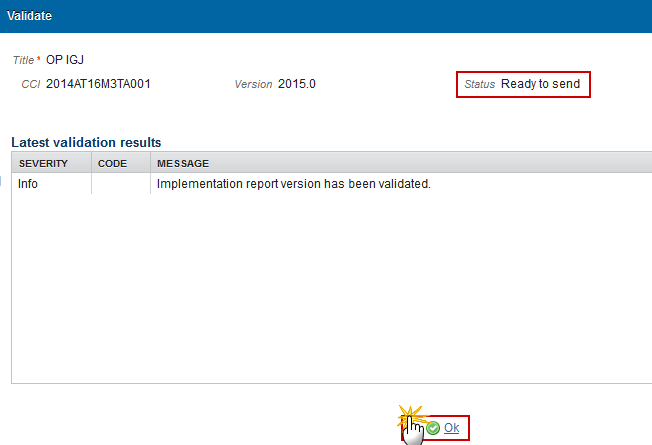
Send the Implementation Report (IGJ)
REMARK | It is a must to have the role of MS Managing Authority with Send rights. The Implementation Report (IGJ) can only be sent once all Validation Errors have been removed and the status of the Implementation Report (IGJ) is Validated. The Implementation Report version has a status 'Ready to send' or 'Sent'. For users, the '4 eye principle' must be respected. Therefore, the user sending must be different from the user who last validated. The Sending of information by a Member State to the Commission should be electronically signed in accordance with Directive 1999/93/EC. Sending of the different objects is generating a snapshot document and after the sending an acknowledge document is generated by the European Commission. |
Click on the Send link to send the Implementation Report (IGJ).
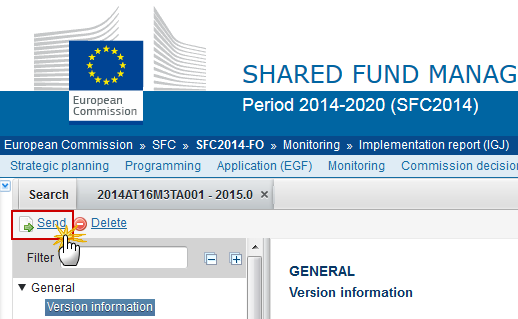
The system will ask you to confirm the send action:
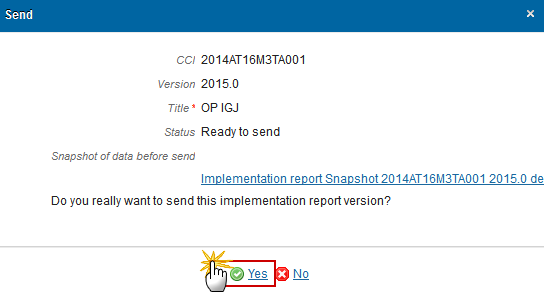
Click on Yes to confirm or click on No to return to the Implementation Report (IGJ).
The Sending of information by a Member State to the Commission should be electronically signed in accordance with Directive 1999/93/EC.
Sending of the different objects is generating a snapshot document and after the sending an acknowledge document is generated by the European Commission.
This acknowledge document is signed but the Member State was not signing the snapshot document. The EU Login now provides a functionality of signing without forcing the user to have a certificate. The action to sign will only be triggered when sending to the European Commission:
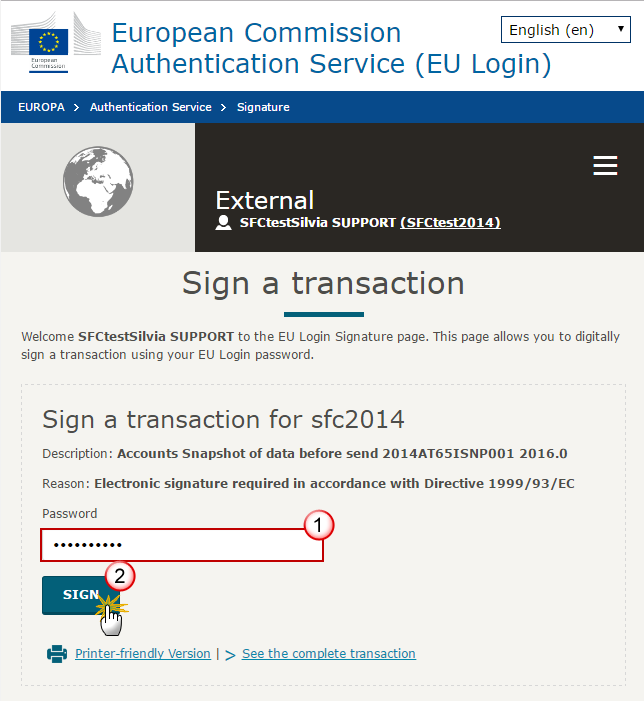
(1) Enter your SFC2014 Password
(2) Click on the 'Sign' button
On success, the Implementation Report version has been sent to the Commission or to an upper node and the status is set to Sent.
Delete the Implementation Report (IGJ)
REMARK | An Implementation Report (IGJ) can be deleted only if its status is 'Open', 'Ready to send' or 'Returned for modification by MS' and has never been sent to the Commission before and has no sent documents attached. It is a must to have the role of MS Managing Authority with Update access. |
Click on the Delete link to remove the Implementation Report from the system.
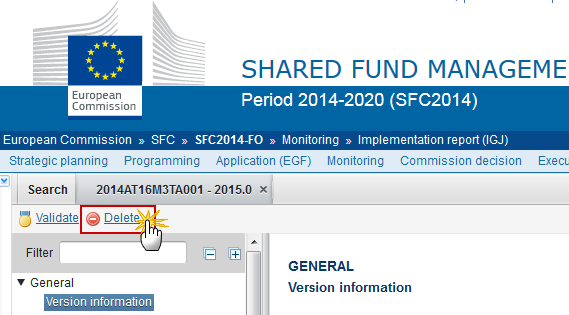
The system will ask you to confirm the delete action:

Click on Yes to confirm or click on No to return to the Implementation Report (IGJ).
On success, the Implementation Report is removed physically from the system.
Create a New Version of an Implementation Report (IGJ)
REMARK | It is a must to have the role of MS Managing Authority with Update access. A New Version can only be created when the last Implementation Report version for the specific Reporting Year is 'Returned for modification by EC', 'technical return on performance review', 'Accepted by EC (Technical return) ' or 'Non-Admissible'. From AIR2017 onwards, also the Financial Instruments information will be copied and the EAC (Ex-ante conditionalities) information will not be copied anymore. |
Click on the Create New Version link to create a new version of the Implementation Report (IGJ).

The system will ask you to confirm the creation of a new version:
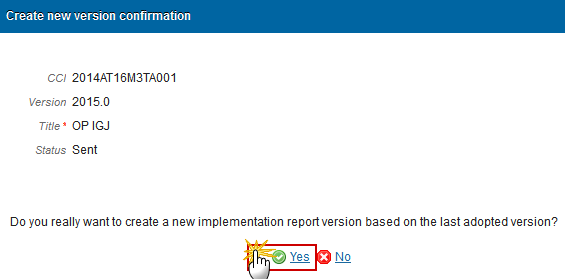
Click on Yes to confirm or on No to return to the Implementation Report.
On success, a new version of the Implementation Report (IGJ) has been created as a copy of the previous version, with a version number identical to the previous and a working version incremented by one. Its status was set to Open.
The "Report approval date by the monitoring committee" should not be copied.
Additional Functionality
Early warning notification
An early warning notification job will run on 1, 15, 20, 26, 27, 28, 29 and 30 of April 2015. It will select all adopted YEI Programmes for which no Implementation Report for Reporting Years smaller than the current year has been sent to the Commission.
An early warning notification job will run on 1, 14, 21, 25, 27 and 31 of May in 2016, 2018, 2020, 2021 and 2022. It will select all adopted IGJ Programmes for which no Implementation Report for Reporting Years smaller than the current year has been sent to the Commission.
An early warning notification job will run on 1, 14, 21, 25, 27 and 30 of September in 2017 and 2019. It will select all adopted IGJ Programmes for which no Implementation Report for Reporting Years smaller than the current year has been sent to the Commission.
For these Programmes, an email notification will be sent to the Managing Authority of the Programme and to the subscribers of this Event Type. The notification will say:
For 2016, 2018, 2020, 2021 and 2022 submissions:
“The deadline for the submission to the Commission of the Implementation Report [YYYY] for Programme [CCI] is 31st of May. Please submit it as soon as possible.”
For 2019 submission:
“The deadline for the submission to the Commission of the Implementation Report [YYYY] for Programme [CCI] is 30th of September. Please submit it as soon as possible.”

 ):
):
